Contact rj.cook@btinternet.com
September 6th 2023
Is Wagner still a threat to global security?
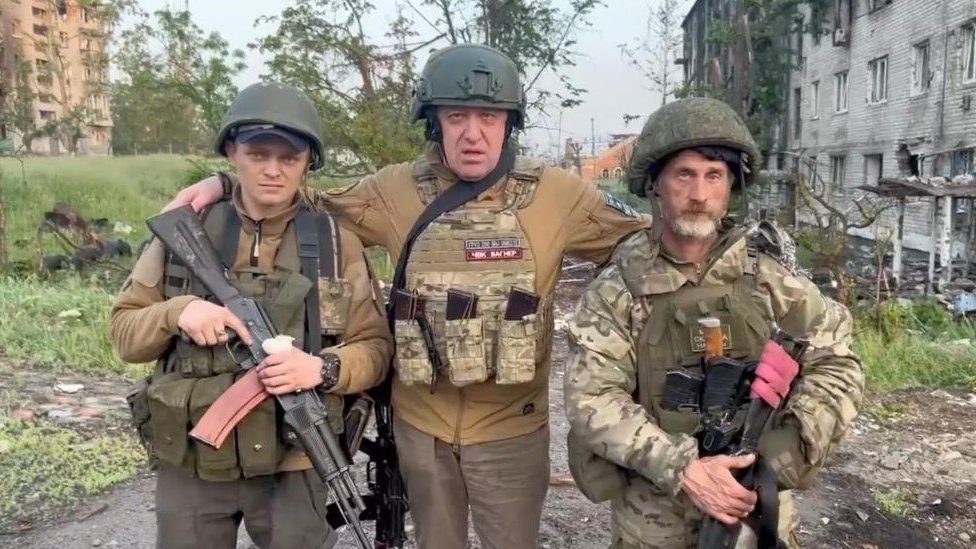
By Frank Gardner
BBC security correspondent
Russia’s Wagner mercenary group is set to be proscribed by the UK Government as a terrorist organisation under the Terrorism Act 2000.
The move is significant but considered by some to be long overdue.
It follows criticism by Parliament’s Foreign Affairs Committee that the Government had not done enough to confront the activities of Wagner.
What is Wagner?
The Wagner group is a private military group, financed by the Kremlin and active in promoting Russia’s interests around the globe.
Formed in 2014 with help from Russia’s GRU military intelligence, its core members were former Russian Spetsnaz (Special Forces) operatives and career soldiers with a reputation for both toughness and brutality.
They have been fighting on Russia’s behalf in Ukraine, notably in the Donbas, Syria and several countries in Africa.
- Wagner to be declared terrorist organisation
- What is Russia’s Wagner mercenary group?
- Prigozhin and Putin: How a friendship turned ugly
Headed by the late Russian billionaire Yevgeny Prigozhin, they have proved to be Russia’s most effective fighting force in the Ukraine war, largely because they have been able to operate independently from Russia’s inefficient and often incompetent Defence Ministry.
President Vladimir Putin recently admitted that the Kremlin has been funding Wagner to the tune of a billion US dollars. But the money flows both ways.
Wagner has won lucrative contracts in countries like Mali, Central African Republic and Sudan, providing autocratic rulers with security and protection services in exchange for gold, diamonds and mineral concessions. Much of the proceeds have made their way back to Moscow and funded the Russian war effort.
Human rights groups have accused Wagner of committing widespread torture and carrying out atrocities in a number of countries.
The home secretary stated: “Wagner has been involved in looting, torture and barbarous murders. Its operations in Ukraine, the Middle East and Africa are a threat to global security.” The Government says it poses a threat to British nationals abroad.
What difference will this ban make?
The proscription of Wagner, once it becomes law, will make it a criminal offence to be a member of the group or to assist its activities, including the transfer of money flows. Some offences carry a jail sentence of up to 14 years.
This law will mean that Wagner’s assets can be classed as ‘terrorist property’ and seized. This has huge legal implications for the thousands of Ukrainians seeking compensation, meaning that in theory they can now pursue these through the UK courts.
Dr Jason McCue, senior partner at the law firm McCue Jury & Partners, applauded the UK’s move. He said it “would make it almost impossible for the operations, finances and logistics of the post-modern terror organisation’s business to continue”.
He described the Wagner group as “one of the most vicious, sadistic bunch of mercenaries that have equalled the depravities of the worst elements of (Nazi Germany’s) Waffen SS”.
Is Wagner still a threat to global security?
Yes, according to the UK government, which is why they are proscribing it.
Some might say that this measure comes so late – more than a year after many called for Wagner to be proscribed – that it is almost a case of shutting the barn door after the horse has bolted, that the Government should have acted sooner to curtail its activities when Wagner was at the height of its power.
Wagner today is already a weaker organisation than it was three months ago before it carried out a mutinous and aborted march on Moscow.
Since then, it has effectively been hobbled by the Kremlin, forced to hand over its heavy weapons and sign new contracts with Russia’s Defence Ministry.
Its forces are no longer fighting in Ukraine. Instead they are scattered between Belarus and Africa while others have joined the Russian Army or simply gone home.
Its leadership is decapitated after a mysterious plane crash in August that killed Wagner’s leader, deputy leader and finance director. Western officials said this was President Putin’s revenge for the mutiny. The Kremlin has denied involvement.
But Wagner remains an extensive and potentially disruptive force across several countries where it operates. Poland and the Baltic states are concerned that it may try to foment trouble on the border with Belarus.
In West Africa its forces have replaced the French in a number of countries.
Analysts and Kremlin-watchers now expect Russia’s military intelligence arm, the GRU, to take over much of the direction of Wagner, moving away from direct combat and more into cyber warfare and deniable, ‘grey zone’ operations.
Related Topics
- Wagner to be declared a terrorist organisation by UK
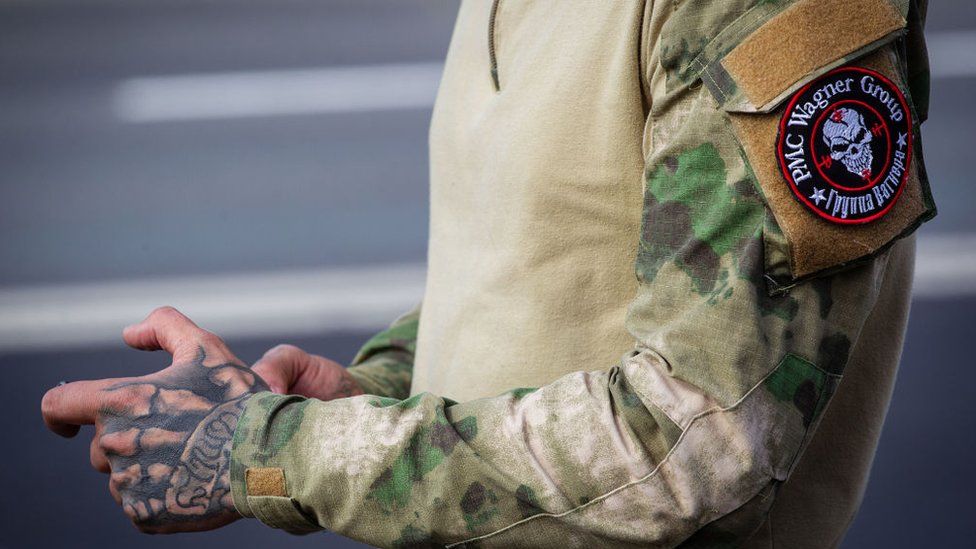
- What is Russia’s Wagner mercenary group?
- Published12 hours ago

- Wagner – built by blood and treasure in Africa
- Published26 August
August 26th 2023
Trump seeks to make the most of historic Georgia mugshot
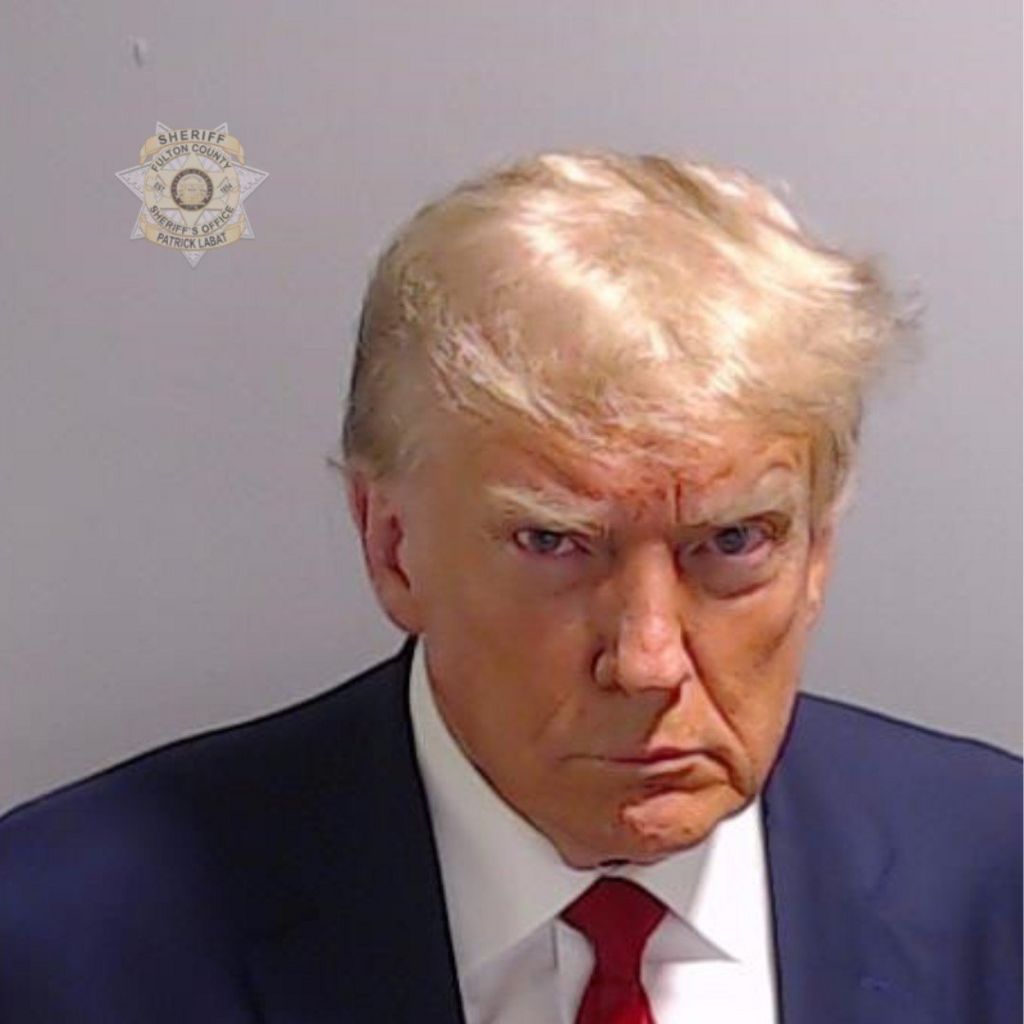
By George Wright & Holly Honderich
BBC News
The photo of Donald Trump scowling defiantly into the camera in the Fulton County Sheriff’s office will go down in history.
The mugshot, the first of a former US president, came after his fourth arrest in five months.
Mr Trump posted on X, formerly known as Twitter, for the first time since January 2021 to share the address of his website and the mugshot with an all-capital letters caption: “Election interference. Never surrender!”
Within hours, his campaign website was selling mugshot-branded mugs, t-shirts and drink coolers.
John Bolton, who served as national security advisor under Mr Trump, said the image was likely carefully staged. “I think it’s intended to be a sign of intimidation against the prosecutors and the judges,” he told CNN.
“He could’ve smiled. He could’ve looked benign,” Mr Bolton added. “Instead he looks like a thug.”

Mr Trump was charged last week with 18 alleged co-conspirators with attempting to overturn his 2020 election defeat in the state of Georgia.
At least 11 of the co-conspirators – Mr Trump, Rudy Giuliani, Sidney Powell, Jenna Ellis, Kenneth Chesebro, Cathy Latham, Harrison Floyd, Mark Meadows, Ray Smith, Harrison Floyd and Scott Hall – have so far been booked and processed at the local jail in Atlanta.
While the former president and his supporters are clearly pleased with his mugshot, photos of his indicted allies have been less well received.
“I thought these were all memes at first,” said Jake Olson, a photographer based in Columbus, Ohio. “It’s the perfect storm of bad photos, There are so many cardinal rules of photography that they are just not following.”
“They have this one interrogation-style light, you can see they all have that little highlight on their foreheads,” said Pittsburgh photographer and professor Ray Mantle. “They all don’t look great… they all look tired.”
The expressions vary widely. Lawyer Jenna Ellis is beaming down the lens, while Ray Smith, also an attorney, glares into the camera – two strikingly different choices for a photo that, unlike most other mugshots, will be published far and wide.
“For a lot of these people, this is their major public debut,” Mr Mantle said. “They know that everyone’s going to see these.”
Pulling off a good mugshot can be tough, said Cooper Lawrence, a journalist who has written extensively about celebrity culture. It’s a difficult balance to strike, a challenge that celebrities like Justin Bieber, Lindsay Lohan and Paris Hilton have all had to face.
“Don’t smile. A smile will make it look too arrogant,” Lawrence said. “You want to smirk like Lindsay Lohan and Paris Hilton do. A smirk says, ‘yes, this sucks, but I’m gonna be fine.'”
Hair, makeup and wardrobe – even while in the custody of Fulton County authorities – is crucial, she said. But “keep it simple”, she added. “You’re going to jail, not on an audition.”
https://emp.bbc.co.uk/emp/SMPj/2.50.4/iframe.htmlMedia caption,
Watch: Trump surrenders at Georgia jail…in 74 seconds
Mr Trump, however, is a man well aware of the power of his public image.
Earlier this year he complained that producers on Fox News chose to “purposely show the absolutely worst pictures of me, especially the big ‘orange’ one with my chin pulled way back”.
And to some the low quality of the Fulton County mugshot looks especially strange on a former president, even with its possible promotional value.
“It struck me how humbling and humanising a bad portrait can be,” said Mr Olson. “It’s funny to see such a poorly done portrait of somebody who has such a significant presence, to say the least.”
But despite the low resolution, Edd Mair, a lecturer in the History of Modern America at the University of York, said Mr Trump’s campaign “clearly thinks there’s a lot to get out of a photo like this”.
“What’s most striking about it is how on brand this is for Donald Trump. Even a mugshot there’s a way of converting this into political capital and enthusing his base.”
Some right-wing commentators have been drawing analogies with Nelson Mandela and Dr Martin Luther King Jr, who had mugshots taken, including in an iconic 1963 shot from Birmingham Jail.
“They did the same thing to Martin Luther King Jr,” tweeted comedian and Trump supporter Terrence K Williams.
“They go after the good guys and especially the ones who fight for freedom and expose evilness and corruption. I stand with President Trump and this mugshot makes me want to vote for him even more.”
Mr Mair said Trump supporters will be attempting to frame the mugshot in this way. “These people were deemed as dangerous individuals going against the grain, but they were eventually proven right. This is what Donald Trump and his supporters want to get out of this mugshot.”
But those on the left and the centre will see the photo very differently, he said.
“Certainly it will be used in the same breath as Richard Nixon and the Watergate scandal too, but even Nixon never got this far in actually having a mugshot.
“I think on the left and in the centre ground this will be seen as quite a low moment for the American presidency.”
Trump seeks to make the most of historic Georgia mugshot
- Published
- 1 day ago
Related Topics

By George Wright & Holly Honderich
BBC News
The photo of Donald Trump scowling defiantly into the camera in the Fulton County Sheriff’s office will go down in history.
The mugshot, the first of a former US president, came after his fourth arrest in five months.
Mr Trump posted on X, formerly known as Twitter, for the first time since January 2021 to share the address of his website and the mugshot with an all-capital letters caption: “Election interference. Never surrender!”
Within hours, his campaign website was selling mugshot-branded mugs, t-shirts and drink coolers.
John Bolton, who served as national security advisor under Mr Trump, said the image was likely carefully staged. “I think it’s intended to be a sign of intimidation against the prosecutors and the judges,” he told CNN.
“He could’ve smiled. He could’ve looked benign,” Mr Bolton added. “Instead he looks like a thug.”

Mr Trump was charged last week with 18 alleged co-conspirators with attempting to overturn his 2020 election defeat in the state of Georgia.
At least 11 of the co-conspirators – Mr Trump, Rudy Giuliani, Sidney Powell, Jenna Ellis, Kenneth Chesebro, Cathy Latham, Harrison Floyd, Mark Meadows, Ray Smith, Harrison Floyd and Scott Hall – have so far been booked and processed at the local jail in Atlanta.
While the former president and his supporters are clearly pleased with his mugshot, photos of his indicted allies have been less well received.
“I thought these were all memes at first,” said Jake Olson, a photographer based in Columbus, Ohio. “It’s the perfect storm of bad photos, There are so many cardinal rules of photography that they are just not following.”
“They have this one interrogation-style light, you can see they all have that little highlight on their foreheads,” said Pittsburgh photographer and professor Ray Mantle. “They all don’t look great… they all look tired.”
The expressions vary widely. Lawyer Jenna Ellis is beaming down the lens, while Ray Smith, also an attorney, glares into the camera – two strikingly different choices for a photo that, unlike most other mugshots, will be published far and wide.
“For a lot of these people, this is their major public debut,” Mr Mantle said. “They know that everyone’s going to see these.”
Pulling off a good mugshot can be tough, said Cooper Lawrence, a journalist who has written extensively about celebrity culture. It’s a difficult balance to strike, a challenge that celebrities like Justin Bieber, Lindsay Lohan and Paris Hilton have all had to face.
“Don’t smile. A smile will make it look too arrogant,” Lawrence said. “You want to smirk like Lindsay Lohan and Paris Hilton do. A smirk says, ‘yes, this sucks, but I’m gonna be fine.'”
Hair, makeup and wardrobe – even while in the custody of Fulton County authorities – is crucial, she said. But “keep it simple”, she added. “You’re going to jail, not on an audition.”
https://emp.bbc.co.uk/emp/SMPj/2.50.4/iframe.htmlMedia caption,
Watch: Trump surrenders at Georgia jail…in 74 seconds
Mr Trump, however, is a man well aware of the power of his public image.
Earlier this year he complained that producers on Fox News chose to “purposely show the absolutely worst pictures of me, especially the big ‘orange’ one with my chin pulled way back”.
And to some the low quality of the Fulton County mugshot looks especially strange on a former president, even with its possible promotional value.
“It struck me how humbling and humanising a bad portrait can be,” said Mr Olson. “It’s funny to see such a poorly done portrait of somebody who has such a significant presence, to say the least.”
But despite the low resolution, Edd Mair, a lecturer in the History of Modern America at the University of York, said Mr Trump’s campaign “clearly thinks there’s a lot to get out of a photo like this”.
“What’s most striking about it is how on brand this is for Donald Trump. Even a mugshot there’s a way of converting this into political capital and enthusing his base.”
Some right-wing commentators have been drawing analogies with Nelson Mandela and Dr Martin Luther King Jr, who had mugshots taken, including in an iconic 1963 shot from Birmingham Jail.
“They did the same thing to Martin Luther King Jr,” tweeted comedian and Trump supporter Terrence K Williams.
“They go after the good guys and especially the ones who fight for freedom and expose evilness and corruption. I stand with President Trump and this mugshot makes me want to vote for him even more.”
Mr Mair said Trump supporters will be attempting to frame the mugshot in this way. “These people were deemed as dangerous individuals going against the grain, but they were eventually proven right. This is what Donald Trump and his supporters want to get out of this mugshot.”
But those on the left and the centre will see the photo very differently, he said.
“Certainly it will be used in the same breath as Richard Nixon and the Watergate scandal too, but even Nixon never got this far in actually having a mugshot.
“I think on the left and in the centre ground this will be seen as quite a low moment for the American presidency.”
August 25th 2023
Bodies and flight recorders recovered at Wagner boss Prigozhin’s jet crash site
By Will Vernon & Jaroslav Lukiv
BBC News, Moscow & London
Russia says 10 bodies and flight recorders have been recovered from the scene of a jet crash presumed to have killed Wagner chief Yevgeny Prigozhin.
“Molecular-genetic tests are now being carried out,” investigators say.
The plane crashed near Moscow on Wednesday, prompting speculation that a bomb or a missile was to blame.
Claims that the Kremlin gave an order to kill Prigozhin were a “complete lie”, Russian President Vladimir Putin’s spokesman told the BBC earlier.
Prigozhin – once a Putin loyalist – led an aborted armed revolt by his mercenary fighters in June.
Mr Putin at the time described the mutiny as “treachery”, but a deal was later struck for Wagner mercenaries to either join Russia’s regular army or go to Belarus – Moscow’s ally.
Even so, in the wake of the rebellion, many observers described Prigozhin, 62, as a “dead man walking”, arguing that the Russian president would never forgive the Wagner boss.
During Friday’s conference call with journalists, Kremlin spokesman Dmitry Peskov told the BBC there was “lots of speculation” around the “tragic” deaths of all 10 people in Wednesday’s air crash in the Tver region, north-west of the Russian capital.
Prigozhin and his right-hand man Dmitry Utkin, as well as five other passengers and three crew members, were on board of the Embraer Legacy 600 jet, according to the passenger list.
“In the West, of course, this speculation comes from a certain angle. It’s all a complete lie,” Mr Peskov went on.
“We don’t have many facts at the moment, the facts need to be clarified during the official investigation which is being carried out now,” he added.
And despite the jet’s manifest, Mr Peskov refused to be drawn on whether the Kremlin had confirmation that Prigozhin was definitely on board the downed plane.
The future of Wagner itself has also been thrown further into doubt by Prigozhin’s presumed death.
On Friday, Belarus’ leader Aleksander Lukashenko that up to 10,000 Wagner fighters would continue to be based in the country.
However, many experts believe that Mr Lukashenko takes orders from the Kremlin.
President Putin stayed silent over the crash for almost 24 hours, before expressing condolences to all the victims’ families.
He also described Prigozhin as a “talented person” who “made serious mistakes in life”.
But from the moment the plane came down, there has been frenzied speculation about what caused the crash.
The Pentagon says it believed the Wagner chief was probably killed, while a US official told CBS News that the most likely cause of the crash was an explosion on board the plane.
President Joe Biden said on Friday that the US was still trying to “nail down” precisely what brought down the plane.

More on Prigozhin’s reported death
- Russia plane crash: What we know so far
- Frank Gardner: Was Wagner chief a dead man walking?
- Who is Dmitry Utkin and who else was on the plane?
- How Russia reacted after plane crash
August 24th 2023
Plane Crazy
Summary
- The Kremlin has still not commented on Wednesday’s plane crash in which Wagner leader Yevgeny Prigozhin is presumed to have died
- Russia’s President Vladimir Putin made no mention of the crash as he addressed an international summit via video link
- Authorities say all 10 people on the plane were killed near Moscow – and passengers included Prigozhin and his right-hand man Dmitry Utkin
- There’s huge speculation about what happened. UK defence sources tell the BBC that Russia’s FSB intelligence agency is most likely to be responsible
- The Wagner mercenary group was very active in Ukraine until Prigozhin led a short-lived mutiny in June – Putin called it “treachery” at the time
Live Reporting
Edited by Marita Moloney
Posted at 10:0510:05
Putin addresses Brics again
Vladimir Putin is addressing the Brics summit in South Africa via video link for the second time today.
We’re listening in and will bring you the key lines from what he says.
BreakingFSB likely targeted Prigozhin’s plane – UK defence sources
Frank Gardner
Security correspondent

UK defence sources say that Russia’s FSB domestic intelligence agency (the successors to the KGB) are those most likely to have targeted Yevgeny Prigozhin’s plane.
They are totally loyal to Vladimir Putin and also run the border force.
The view is that this now probably strengthens the position of Russian Defence Minister Sergei Shoigu and Chief of the General Staff of the Russian Armed Forces Valery Gerasimov, whom Prigozhin loathed and publicly criticised.
This in turn is good for Ukraine as those two are considered incompetent.
Article share tools
Share this post
- Copy this link
Posted at 9:469:46
Putin has reasserted control – former MI6 boss
Former MI6 boss Sir John Sawers says he thinks it’s highly likely that Vladimir Putin is behind the reported death of Yevgeny Prigozhin.
“You can never fully be certain of the facts in places like Russia but all the indications point to the fact that Putin has taken him out – he’s reasserted his control,” he told BBC Radio 4’s Today programme.
Sawers says it’s likely that there was a device “that brought the plane down suddenly, and killed everyone on board”.
He rejected claims by Putin’s former spokesman that Ukraine was responsible for the attack.
Earlier, Sergei Markov called Prigozhin a “hero” and said – without offering proof – that he was killed by Ukrainian intelligence as a “gift to Zelensky for Ukraine’s Independence Day”.
Share this post
- Copy this link
Posted at 9:349:34
British government must ‘avoid jumping to conclusions’ over crash
Schools minister Nick Gibb says the government must “avoid jumping to conclusions” over the plane crash in Russia that reportedly killed Wagner chief Yevgeny Prigozhin.
“This only happened a few hours ago,” Gibb tells BBC Radio 4’s Today programme.
He says the government is monitoring the situation closely and working with its allies.
“I can’t go any further at the moment,” he adds. “But of course, the government will have more to say once our assessment of it has happened, and conversations with allies reach clear conclusions.”
Article share tools
Share this post
- Copy this link
Posted at 9:269:26
Putin sticks to script in Brics address

Paul Kirby
Europe digital editor

If you were looking for a first comment from Russia’s president on the reported demise of Yevgeny Prigozhin, there really was nothing to see in this brief video address.
Putin stuck to his script, focusing on the expansion of the Brics group “to ensure the influence of Brics in the world grows”.
Not much of a surprise that there was no mention of his former ally-turned-mutineer. It may have been the elephant in the room but this was not the forum for domestic concerns.
Of course, Putin was not actually in the room in Johannesburg. He stayed in Russia because of an arrest warrant for alleged war crimes in Ukraine issued by the International Criminal Court.
August 21st 2023
Ukrainian drone destroys Russian supersonic bomber
Related Topics
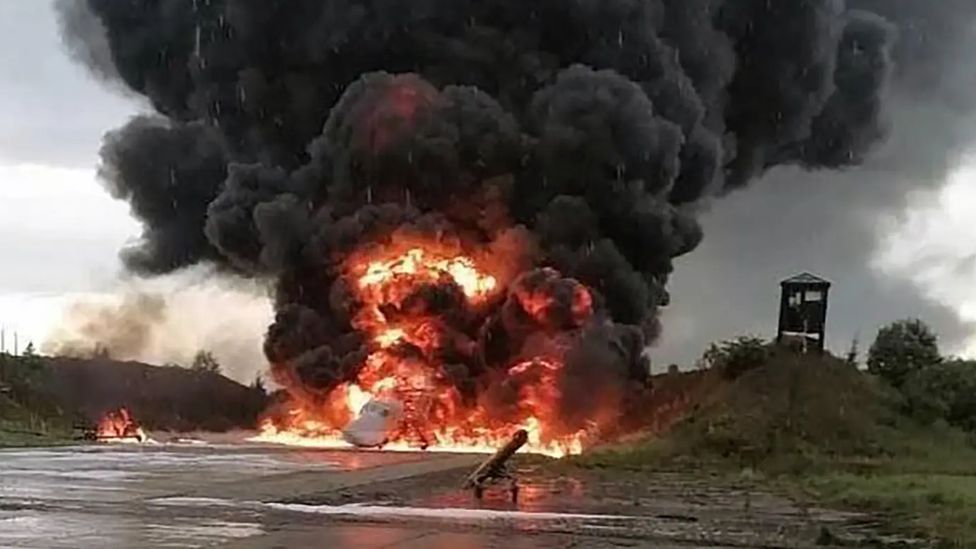
By Graeme Baker
BBC News
A flagship Russian long-range bomber has been destroyed in a Ukrainian drone strike, according to reports.
Images posted on social media and analysed by BBC Verify show a Tupolev Tu-22 on fire at Soltsy-2 airbase, south of St Petersburg.
Moscow said that a drone was hit by small-arms fire but managed to “damage” a plane. Ukraine has not commented.
The Tu-22 can travel at twice the speed of sound and has been used extensively by Russia to attack cities in Ukraine.
The Russian Ministry of Defence said in a statement that an attack by a “copter-type UAV” took place at around 10:00 Moscow time (08:00 BST) on Saturday.
It stated the location as “a military airfield in the Novgorod region”, where Soltsy-2 is situated.
“The UAV was detected by the airfield’s observation outpost and was hit with small-arms fire,” the ministry said.
“One airplane was damaged; there were no casualties as a result of the terrorist act.”
The statement also said a fire which broke out in the airfield parking lot was quickly extinguished.
However, images posted on the social media platform Telegram showed a large fire engulfing a jet with the distinctive nose cone of the Tu-22. BBC Verify analysed the images and believes them to be credible.
While the destruction of a single aircraft will have little effect on the potency of Moscow’s current 60-strong fleet, the operation highlights Kyiv’s growing ability to strike targets deep inside Russian territory.
Kyiv has over recent months launched dozens of fixed-wing unmanned aircraft to attack Moscow, a journey of several hundred miles. Soltsy-2 is around 400 miles (650km) from the Ukraine border.
However, the Russian MoD’s description of the drone as a “copter-type UAV” suggests a cheap, commercially available device launched at short range.
The Tu-22 is a Cold War-era, swing-wing supersonic bomber, codenamed “Backfire” by Nato, which has been used extensively in attacks on Ukrainian cities.
Modern versions such as the Tu-22M3 can reach speeds of Mach 2 (2,300km/h or 1,430mp/h) and can carry up to 24,000kg of weapons, including “dumb bombs” and homing missiles.
They have been used in conflicts in Syria, Chechnya, and Georgia and most recently in Ukraine.
According to prosecutors in Kyiv, 30 people were killed when a Tu-22-launched missile hit a block of flats in Dnipro in January.
They said Russia’s 52nd Guards Bomber Aviation Regiment carried out the attack. The regiment is based at Soltsy-2.
BBC Verify confirmed the location of the Ukrainian drone attack on Soltsy-2 by comparing visual clues – such as the appearance of aircraft and bays – to historical satellite images of the airbase.
The weather conditions at the time – wet and overcast – also matched the weather in the images, as well as other witness photos of the incident.
The remnants of the aircraft visible in the footage are consistent with that of a Tu-22M3.
Historical satellite imagery analysed by BBC Verify shows that aircraft of this kind were stationed at the base.
On Monday, a spokesperson for Ukraine’s defence intelligence service said another military aircraft had been damaged in a drone attack in Russia’s Kaluga region.
Russian media also reported the attack, but denied there had been any damage.
Comment This Ukrainian attack in NATO’s proxy war on Russia moves ever closer to full blown
World War III . These are NATO
August 20th 2023
Fake Democracy
European diplomats are not overlooking the possibility that Donald Trump might secure a second term in the Oval Office if he is re-elected in 2024, and are actively formulating back-up strategies in case this scenario materialises, according to a report.
The prospect of Mr Trump returning to the White House has become an important topic of discussion in private conversations, with some calling it “terrifying”, The New York Times reported.
Comment
Democrats have admitted that Trump’s relectance to interfere in Ukraine and desire to quit war mongering war profiteering NATO, were major reasons for so much expensive waste of tax payer’s money in their anti democratic efforts to impeach him. These mainstream elite political and media protestations that we of the masses inhabit democracy are absurd, unless the elite mean the Lenin version. By the way, Ukraine, like Scandanavia, is nowhere near the North Atlantic. The war in Ukraine has brought a boom for the U.S Defence Industry. A Biden Administration spokesperson justified the war crime of cluster munitions as a stop gap while more conventional munitions are manufactured. Ukraine has been supplying ingredients to U.S arms manufacturers since 2020.
R J Cook
August 17th 2023
Ukrainian sea drone targets Russian tanker
https://emp.bbc.co.uk/emp/SMPj/2.50.2/iframe.html
Ukrainian sea drone targets Russian tanker
This is the moment a naval drone purportedly heads directly towards a Russian tanker in the Kerch Strait, south of the Crimean Bridge.
Unverified footage shared by a source at Ukraine’s security service shows what they say is the drone moving across the Black Sea, as it approaches the Russian vessel.
Russian maritime officials said the Sig tanker’s engine room was damaged in an attack, but no-one on board was injured.
A Ukrainian security service source told the BBC the operation was conducted jointly with the Ukrainian navy and that 450kg of TNT explosive had been used.
August 16th 2023
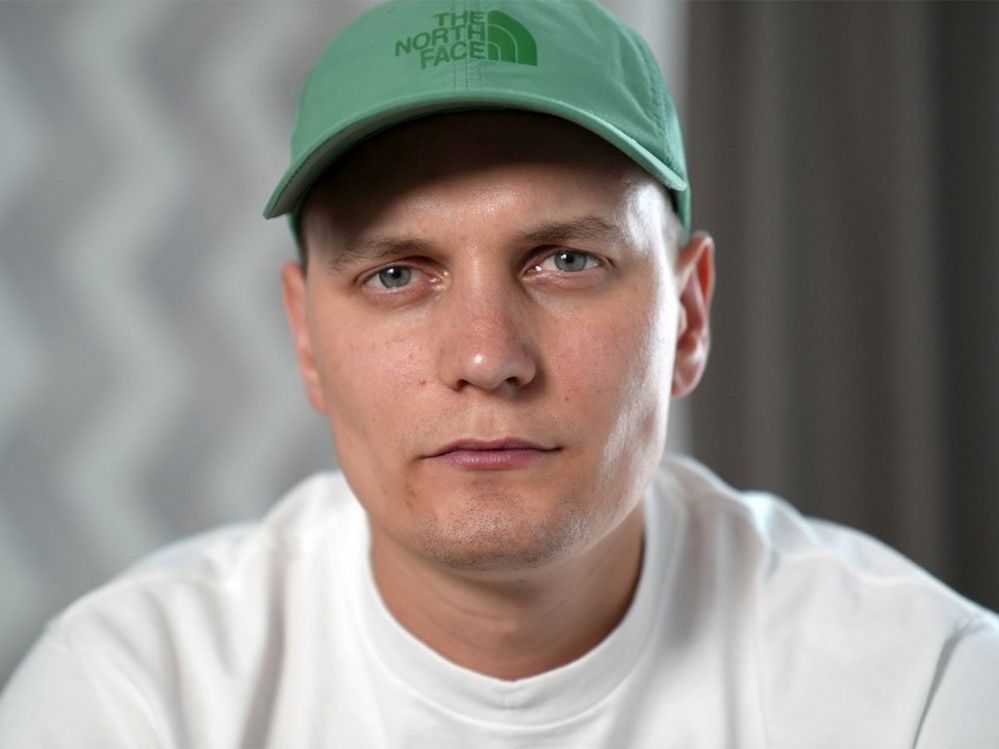
By Hugo Bachega
BBC News, Ukraine
Former Ukrainian captives say they were subjected to torture, including frequent beatings and electric shocks, while in custody at a detention facility in south-western Russia, in what would be serious violations of international humanitarian law.
In interviews with the BBC, a dozen ex-detainees released in prisoner exchanges alleged physical and psychological abuse by Russian officers and guards at the Pre-Trial Detention Facility Number Two, in the city of Taganrog.
The testimonies, gathered during a weeks-long investigation, describe a consistent pattern of extreme violence and ill-treatment at the facility, one of the locations where Ukrainian prisoners of war have been held in Russia.
Their allegations include:
- Men and women at the Taganrog site are repeatedly beaten, including in the kidneys and chest, and given electric shocks in daily inspections and interrogations
- Russian guards constantly threaten and intimidate detainees, some of whom have given false confessions which were allegedly used as evidence against them in trials
- Captives are constantly left under-nourished, and those who are injured are not given appropriate medical assistance, with reports of detainees dying at the facility
The BBC has been unable to independently verify the claims, but details of the accounts were shared with human rights groups and, when possible, corroborated by other detainees.
The Russian government has not allowed any outside bodies, including the United Nations and the International Committee of the Red Cross, to visit the facility which before the war was used exclusively to hold Russian prisoners.
Russia’s defence ministry did not respond to several requests to comment on the allegations. It has previously denied torturing or mistreating captives.
The prisoner swaps between Ukraine and Russia are a rare diplomatic achievement in the war and more than 2,500 Ukrainians have been released since the start of the conflict. Up to 10,000 captives are believed to remain in Russian custody, according to human rights groups.
Dmytro Lubinets, Ukraine’s human rights ombudsman and one of the officials involved in exchange negotiations with Moscow, said nine in every 10 former detainees claimed they had been tortured while in Russian captivity. “This is the biggest challenge for me now: how to protect our people on the Russian side,” Lubinets said. “Nobody knows how we can do it.”

Last September, Artem Seredniak, a senior lieutenant, had already been in Russian captivity for four months when he and about 50 other Ukrainians were transferred to Pre-Trial Detention Facility Number Two. They travelled in the back of a truck for hours, without knowing where they were going, blindfolded and tied to each other by their arms, like a “human centipede”, Seredniak told me.
On their arrival in Taganrog, he recalled, an officer greeted them: “Hello boys. Do you know where you are? You’ll rot here until the end of your lives.” The captives remained silent. They were escorted inside the building, Seredniak said, had their fingerprints taken and clothes removed, were shaven and forced to shower.
At every step, guards at the facility, who carried black batons and metal bars, beat them in the legs, arms, or “anywhere they wanted”, Seredniak said. “It’s what they call ‘reception’.”
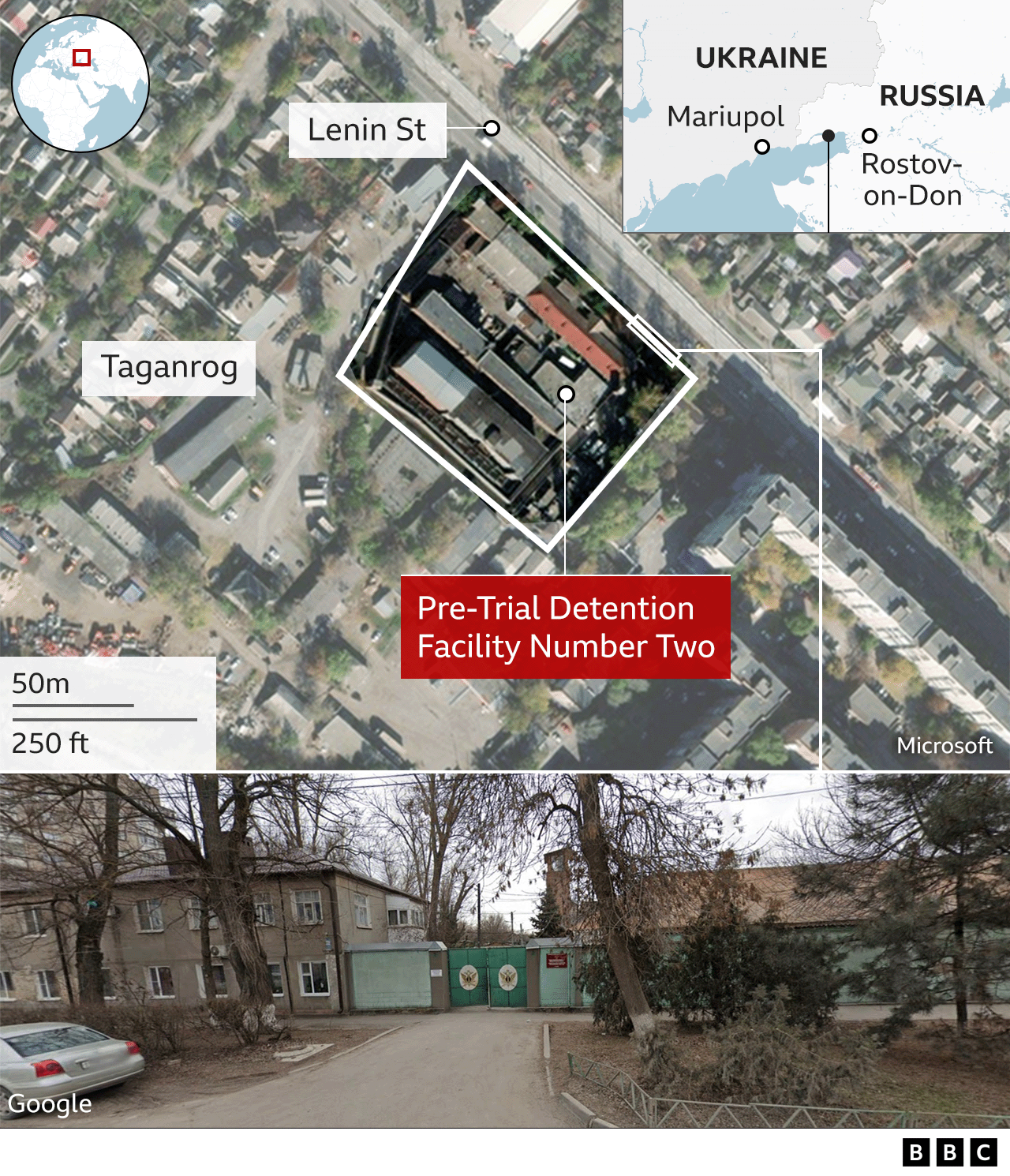
Before his capture, Seredniak, who is 27, headed a sniper platoon at the Azov Regiment, the main military force in Mariupol. This, he said, made him a key target for the prison staff. Seredniak said he was separated from the others and, dressed only in his underwear, brought to a room to be interrogated for the first time. He was then pushed to the floor, he said, with his head facing down.
The guards asked him about his role in the army and the tasks he had carried out. With an electric stun weapon, they gave him shocks, Seredniak said, in his back, groin and neck.
“That’s how they worked on everybody,” he said. “They hammered you like a nail.”

In May last year, as Mariupol was under a Russian siege, the Ukrainian authorities ordered hundreds of soldiers holed up in the city’s Azovstal steelworks to surrender. Seredniak was among the last to be evacuated. He was first taken to a facility in Olenivka, a village in Donetsk, and, months later, sent to the prison in Taganrog, in the Russian border region of Rostov, about 120km (74 miles) east of Mariupol.
There, he told me, the captives were inspected twice a day, and anything appeared to be a motive for guards to abuse them. “They might not have liked how you left the cell, or you weren’t quick to get out, or your arms were too low or your head was too high.”
In one of those checks, Seredniak was asked whether he had a girlfriend. He said he did, and recalled a guard telling him: “Give us her Instagram. We’ll take a picture of you and send it to her.” He lied, not wanting to expose her, and said she did not have an account. He was then beaten, he said, and brought to a room in the prison’s basement, where he met a twenty-something Ukrainian fighter. Seredniak told me the man was curled, holding his hands, apparently in pain, and said officers had inserted needles under his fingernails.
As the days progressed, Seredniak noticed that the prison guards were particularly brutal with those who belonged to the Azov Regiment, the former militia in Mariupol that once had links to the far right. Russia’s president, Vladimir Putin, has said, among other things, that his war is an effort to “de-Nazify” Ukraine – a country led by a Jewish president, Volodymyr Zelensky – and Russian authorities often cite the unit to justify the invasion.
Seredniak said that, in his interrogations, he was accused of looting Mariupol and of personally telling his forces to kill civilians in the city, the site of one of the most deadly battles in the war so far. Seredniak, who speaks fast with a loud, determined voice, denied the claims, but it did not seem to matter. “Until you said what they were interested in, and in the way they wanted to hear,” he told me, “they wouldn’t stop beating you.”
Once, Seredniak said, an officer used a wooden chair to hit him, and “he beat me so much that it broke in parts”. On another day, he said, he was asked whether he could sing the “Azov anthem”. He did not know of any Azov anthem, and assumed the guards meant the Prayer of the Ukrainian Nationalist, a 20th-Century oath usually read aloud by soldiers before being sent into combat. Seredniak reluctantly recited it, conscious of how the guards could react.
They punched him several times, he said. He fell, hitting his head against a wall, causing a cut near his eyebrow. He lay on the floor, while the beatings continued, he said, all over his body.
“When I finally got up,” Seredniak recalled, “they told me: ‘We hope we beat that out of you’.”

Some of the prison staff seemed to have been heavily influenced by President Putin’s “de-Nazification” narrative. For the detainees, this was apparent in how the guards demonstrated a particular interest in anything that could, in their view, be interpreted as being pro-Nazi. The captives were not allowed to have any personal items, so their tattoos inevitably drew the officers’ attention. This reminded me of similar allegations I heard while investigating Russia’s filtration camps in occupied areas of Ukraine last year.
Serhii Rotchuk, a 34-year-old senior sergeant at the regiment, also left Azovstal in the final convoys, and was taken to Taganrog a week after Seredniak. He said the guards, at first, “looked for swastikas or things like that”. But, in reality, he said, “if you had any tattoo, you were seen as a bad guy”. Rotchuk, who is a doctor, has tattoos on both legs, arms and chest. Weeks ago, when we met in Kyiv, he lifted his T-shirt to show me a raven that covered part of his chest and the symbol of an infantry platoon on his left bicep; he also had an emblem of the Jedi Order from Star Wars on his left thigh.

“Did these tattoos cause you any trouble?” I asked him. “Many times,” Rotchuk replied. “They would say: ‘What’s this? Oh, I’ll beat you for that’.” Seredniak, who has no tattoos, said some fighters who had tattooed nationalist symbols, like the Ukrainian flag or the gold trident, were frequently targeted. “They hated us for being Ukrainian,” he told me.
In March, a report by the Office of the United Nations High Commissioner for Human Rights (OHCHR) said Russia had “failed to ensure the humane treatment” of prisoners, with “strong patterns of violations”.
Kris Janowski, a spokesman for the office, said there was a “long list of bad things that have been done” to the detainees at the facility in Taganrog. The fact that a prison was being used to hold captives was, in itself, a breach of international humanitarian law, he said, as they should be kept in specially designated places. Ukraine also faced some accusations of mistreatment of detainees, according to the March report; but, overall, they were “treated in better fashion”.
Rotchuk said the captives “lived in permanent stress” in Taganrog. He recalled meeting a man, also a doctor, who had falsely admitted to removing the testicles of a Russian prisoner, desperate to put an end to the violence. “He said: ‘OK, just leave me alone, I will sign the confession.’ The officers then intimidated the other medics, saying: ‘Ah, you helped him.'”
Guards gave Rotchuk electric shocks, he said, but he resisted. Rotchuk told me he was sent to solitary confinement for two months as punishment. The beatings happened almost every day; sometimes, several times a day, he said.
Rotchuk remembered one officer who appeared to take pleasure in kicking him in the chest, which left him with a persistent pain. He complained, but was given no help. “I had to tell myself: ‘Dude, stay strong, you can’t control the situation, so you need to accept it,'” Rotchuk recalled.
Not everyone had the same resilience, though. Seredniak said a fellow Azov fighter, in his late 20s, broke a small mirror that hung above his cell’s sink, and used a shard to slice his throat. The man was rescued by other captives, who stopped the bleeding with their hands. Days later, Seredniak said, the prison staff removed the mirrors from all cells.

Russian doctors, Seredniak said, would occasionally visit the detainees, but “didn’t necessarily help” them. He described the food portions they were given as limited; sometimes, he said, they were “so small, that if I ate 300-400 calories a day, I was lucky”.
Seredniak, who is 1.86m (6ft1in) tall, said his weight dropped to about 60kg (9st 6lb) while he was there, from his usual 80kg. “Every time I got up,” he said, “I felt dizzy. My eyes darkened, I couldn’t make any fast movements.” He believed this was deliberate: weakened, the captives would not put up any resistance.

Iryna Stohnii, a 36-year-old senior combat medic at the 56th Brigade, described the detainees as “constantly malnourished”. “They didn’t feed us,” she said. “They didn’t even let us go outside… We could only see the sky through bars in the windows.” Stohnii said the guards, in their twice-a-day inspections, forced her and other women to move in a stress position, with arms behind their backs and head to knees, and that some “dragged us by the hair”. Other female captives told me women would be ordered to strip naked in front of male staff who, sometimes, made disparaging comments about their bodies.
One day, Stohnii said, a guard accused her of torturing pro-Russian soldiers in captivity and twisted her arms with so much force that “he almost broke them”. A couple of times in our interview she cried. “Only devils live and work” at Taganrog, she said. After her release, Stohnii underwent surgery to remove adhesions – bands of scar tissue between organs that can be caused by trauma – which had developed in her kidney and bladder. “Apart from rape,” Stohnii told me, “they did everything with us”.
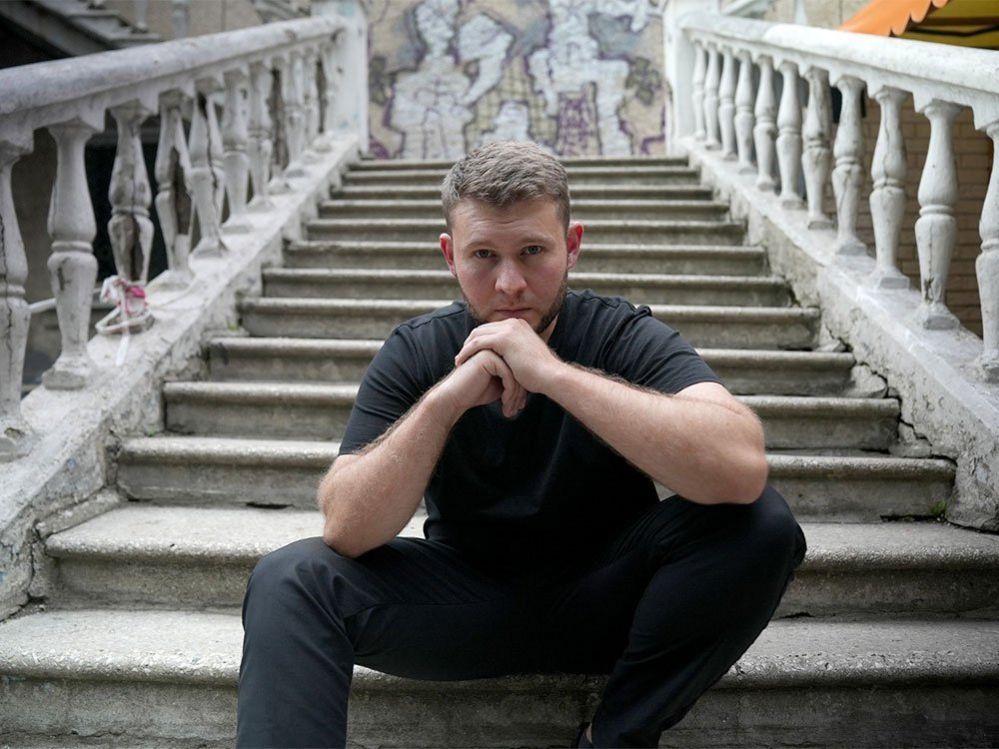
Denys Haiduk, a military surgeon, said guards forced him and the other captives to run with their heads down while under blows during their “reception”, with detainees being hit even after they were on the ground, unable to stand up. Haiduk, who is 29, had helped the wounded at Azovstal and, in his interrogation, he was accused of amputating and castrating Russians in captivity, he told me. He denied it, saying that only Ukrainian fighters had been brought to him.
As he recalled what had happened, I could sense the anger in his voice. Haiduk was pushed to the floor, and given electric shocks with a stun weapon until, he said, the battery ran out. Other captives said guards also used a military phone to give them shocks by connecting its wires to their bodies. “You’re convulsing,” Haiduk said. “If you lift your head up, they start beating you. And that circle never ends.”
Taganrog is also used as a transfer point and, to his surprise, Haiduk was only held there for two days, before his release in a prisoner exchange. As he left, the officers tried to force him to sign a document, declaring that any injury to his body had been accidental. Haiduk refused. He said guards beat and kicked him, and he heard a crack.
Haiduk struggled to breathe, he recalled, and fell into the mattress he was holding. Later, after returning to Ukraine, he was diagnosed with three broken ribs as well as a cardiac contusion – a bruise to the heart muscle caused by trauma.
I asked him why he believed the guards were treating the Ukrainian detainees that way. “Because they can,” he said. “You’re a captive, and they abuse you.” When I asked Seredniak the same question, he gave me a more practical answer: “They beat you to get some information. And then say: ‘It’s to make sure you don’t go back and fight after the swap.'”
Lubinets, the Ukrainian ombudsman, said Russian authorities had created a “system of torture” for Ukrainian captives, typically in detention centres, in Russia and in occupied areas of Ukraine. Ukraine has opened up its facilities to experts; Russia, however, has restricted visits to only some locations. Janowski, from the OHCHR, said Moscow had repeatedly rejected the UN’s requests for access without giving “any legitimate reasons”. With most places closed to outside observers, Lubinets said, “Russian soldiers can do anything with Ukrainian prisoners”.

During his “reception”, Artem Dyblenko, a 40-year-old sergeant major at the 36th Marine Brigade, overheard the guards talking about playing football with the captives. He was intrigued. “What I didn’t know was that we would be the ball,” Dyblenko said. Blindfolded, he was ordered to run, he said, and fell. “There were constant kicks. You did feel like a football.”
Dyblenko told me that, in September, one of his cellmates suffered a heart attack, which he attributed to the constant physical abuse. No-one came to treat him, according to Dyblenko, and the man died, aged 53. Three weeks later, Dyblenko was included in a swap and, in Ukraine, reported the case to the authorities. The body, he said, was returned at the end of last year. “[His son] was given pictures of it,” Dyblenko said, “it was horrifying”. Ukraine acknowledged that bodies were exchanged in December, without giving details of the victims’ identities, or how and where they had died. The man’s son said he was waiting for the result of a DNA test and did not want to comment.
The Media Initiative for Human Rights, a Ukrainian organisation, recorded allegations of at least three deaths at the Taganrog prison, apparently because of torture and lack of food and health care. Mariia Klymyk, one of the group’s investigators, said this was “one the worst places for Ukrainian detainees in Russia”.
She heard accounts of men being taken to interrogation and asked whether they had any children. “If someone says they don’t, they are beaten in the genitals,” Klymyk said, “while the guard says: ‘For prevention of procreation.'” And some Ukrainian soldiers had been put on trial, she said, with the apparent false confessions they had given in custody used as evidence against them.

After almost 12 months in captivity, seven of them in Taganrog, Seredniak was released in a prisoner swap on 6 May, alongside 44 other Ukrainian fighters. He said the date would be celebrated as if it were his second birthday. The same exchange included Serhii Rotchuk, the doctor, who later discovered he had a fracture in his sternum – the breastbone – a condition associated with significant chest trauma, which he blamed on the abuse he had suffered.
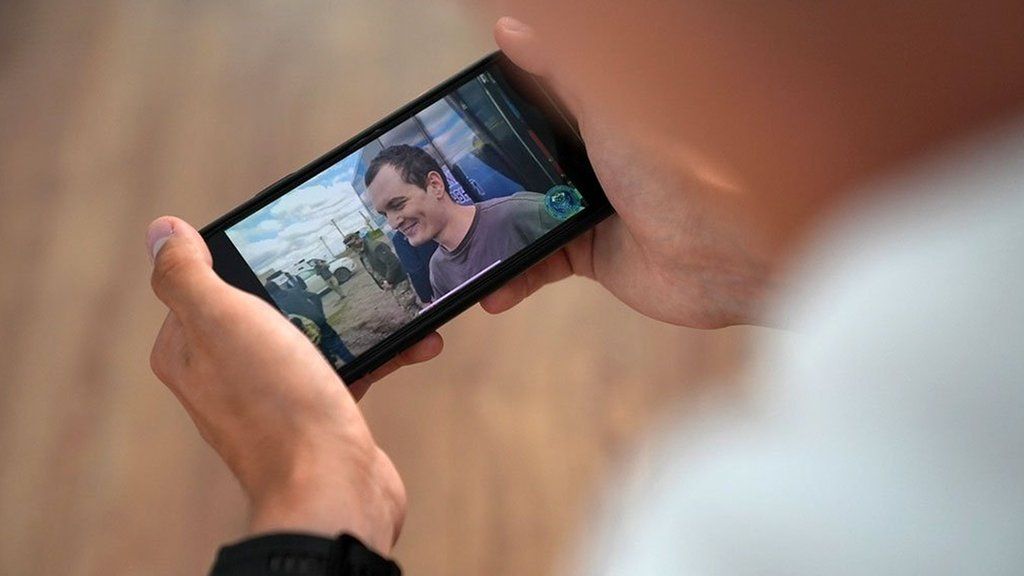
I visited Seredniak four weeks after his return, at a flat in a residential compound on Kyiv’s left bank, between his physical and mental rehabilitation sessions. Doctors had diagnosed him with a broken rib and cysts in the liver and kidney which, they said, were probably caused by the beatings. Seredniak had already regained some of the weight he had lost but still suffered lower back pain and, sometimes, struggled to walk.
On my phone, he watched for the first time a video of his swap, which had been published by the Ukrainian government. The captives were filmed shouting “Slava Ukraini!”, or “Glory to Ukraine”, and being welcomed by a cheering crowd. Pointing at a smiling man, Seredniak said: “This is me!” I could not recognise him. “I was pale, skinny, with no access to sunlight,” he told me. “We were like bats, living in half-light.”
Additional reporting by Daria Sipigina and Lee Durant. Photos by Lee Durant
Comment The Anglo U.S War mongering regime change hypocrits have no right to judge war crimes or torture in particular. Where is Julian Assange ? What are they doing to him ? What about the Middle East or the Northern Ireland 1970s H Blocks ? What about the British involvement in Chilean War Crimes. I worked for the Anglo Chileans. I know what went on there. War is War. Ukraine was deliberately provoked by Anglo U.S led NATO, for control of the Black Sea, more resources to plunder and Russian regime change. Russia is fighting an existential war. Ukrainian troops represent NATO interests whether they know it or not. Vladimir Putin knows it. Finding them heavily armed inside Russian territory , with NATO equipment equipred as saboteurs, is a NATO attack on Russia. Britain leads the charge on Crimea, with the bridge a prime target. We are a whisker away from Nuclear War. Britain’s ruling class has not changed. They value ancient lineage, ancient schools, ancient languages and universities. They have inordinate influence on dangerous fake Irishmen idiots like Joe Biden. The sky is the limit with these power crazed greedy imbeciles who have ensured that their mass education system teaches the cannon and voting fodder less and less about less and less.
R J Cook
August 14th 2023
Ukraine orders evacuation of parts of north-east

By Jaroslav Lukiv
BBC News
Ukraine has ordered the mandatory evacuation of all civilians from 37 settlements in the north-east as Russia steps up its attacks there.
The authorities in the Kupiansk district of the Kharkiv region said they had to act because of “constant Russian shelling” in the area.
A woman was killed by shelling in the district on Thursday, Ukraine said.
Russia says its troops have gained some ground in the area. Ukraine says Russian attacks have been rebuffed.
The comments by the two warring sides have not been independently verified.
In a statement, the Kupiansk district authorities said residents of two towns and 35 villages were being evacuated.
“Do not neglect your safety and the safety of your loved ones!” the authorities said.
They said that civilians were being evacuated to “safe regions” of Ukraine.
A resident in Kivsharivka – one of the villages being evacuated – said she was preparing to leave with her children, while her husband wanted to stay to care for his elderly mother.
“It’s hard to leave them behind,” Anna Koresh, 36, told AFP news agency. “But since it’s getting dangerous it’s important to take the kids to a safe place,” she added.
In its latest briefing, the Russian defence ministry said its assault units in the Kupiansk direction had “improved their position along the front line during offensive operations”.
Ukraine’s military said its forces “successfully repelled” Russian attacks.
But on Thursday evening a woman was killed and a man was injured when a Russian shell hit a house in the village of Podoly, Kupiansk district, Ukrainian officials said.
The evacuation order is not the first for Kupiansk residents.
In March, children and people “with limited mobility” were ordered to evacuate from Kupiansk city because of an increase in Russian shelling.
Kupiansk – an important transport and logistics regional hub – has witnessed fierce fighting since Russian President Vladimir Putin ordered a full-scale invasion of Ukraine on 24 February 2022.
Russian troops seized the city in a matter of days – but Ukrainian forces took back control during a rapid counter-attack last September.
Those advances – and the liberation of Ukraine’s southern city of Kherson – were the most significant front-line changes since Russia withdrew from areas around the capital Kyiv in April.
Also on Thursday, one person was killed in a Russian attack on a “civilian infrastructure” in Ukraine’s southern Zaporizhzhia city, local officials said.
They said another nine people were injured.
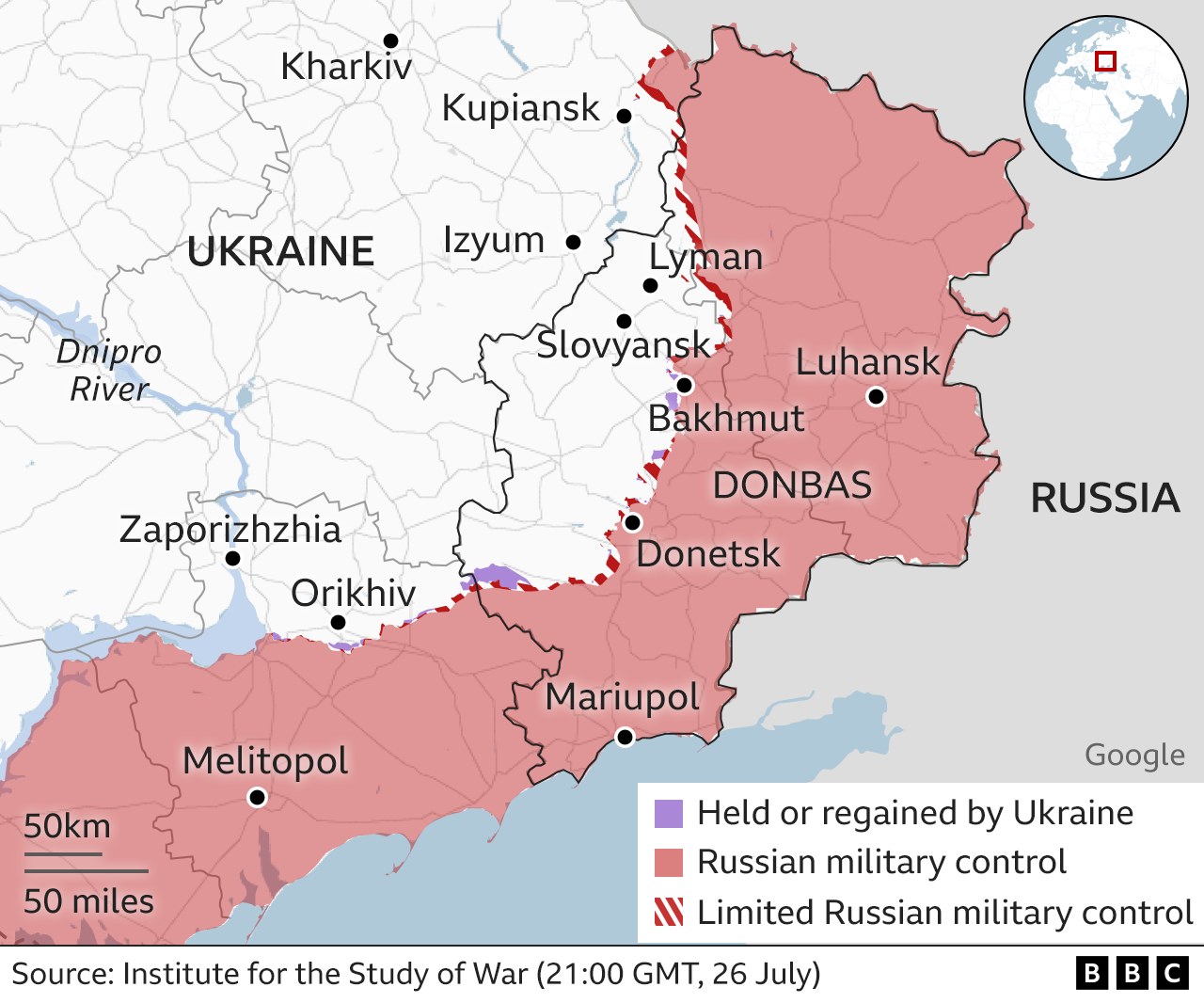
August 13th 2023
Ukraine war: Crimea bridge targeted by missiles, Russia says
Related Topics
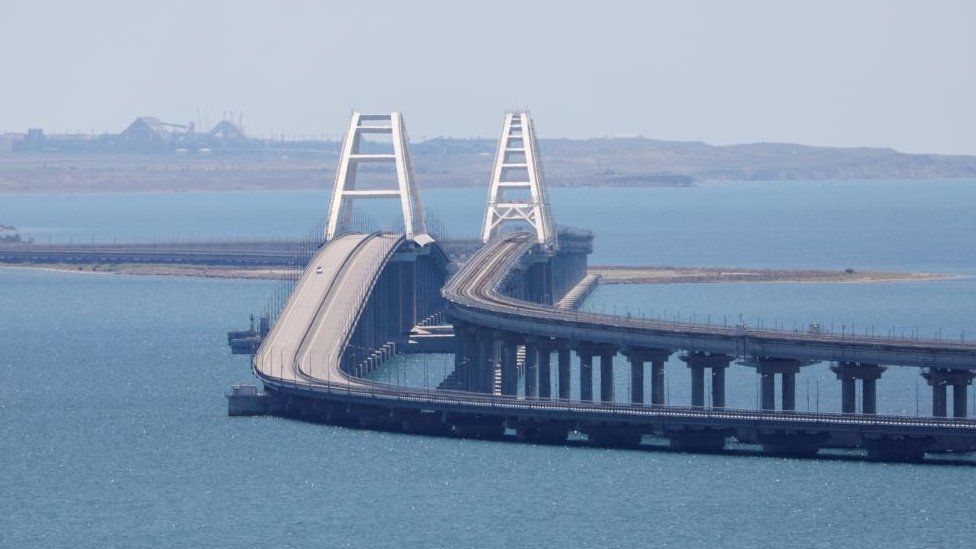
By Antoinette Radford & Graeme Baker
BBC News
Two Ukrainian missiles have targeted a bridge linking Russia to the annexed Crimean peninsula, Moscow says.
Videos on social media show plumes of smoke rising near Kerch bridge. Russia’s defence ministry said S-200 missiles had been used and shot down causing no damage.
Ukraine has not commented on the alleged attack.
There have been at least two other attacks targeting the bridge in the past few months.
The Kerch bridge was opened in 2018 and enables road and rail travel between Russia and Crimea – Ukrainian territory annexed by Russia in 2014.
It is an important resupply route for Russian forces occupying parts of southern Ukraine.
Russia’s defence ministry said that Ukraine had targeted the structure on Saturday at around 13:00 (10:00 GMT).
It identified the missiles used as S-200s – guided, Cold War-era surface-to-air weapons originally designed to destroy enemy aircraft that have apparently been adapted for ground-attack use.
The country’s foreign ministry meanwhile said that “such barbaric actions… will not go unanswered”.
- Who – or what – blew up the Crimean bridge?
- Kerch bridge is hated symbol of Russian occupation
- War in maps: Fighting in south Ukraine intensifies
Crimea’s Russia-appointed governor Sergei Aksyonov later said that a third rocket had been shot down over the Kerch Strait.
Earlier on Saturday, Russia said it had shot down 20 Ukrainian drones near the peninsula.
An adviser to Mr Aksyonov said that traffic was halted and the smoke was an intentional “screen” generated by the military.
While Kyiv has not confirmed the attack, nor the weapons used, it would be the latest in a number of Ukrainian attempts to damage the bridge.
Last month, the Ukrainian website Euromaidan Press claimed that converted S-200 missiles had been used to attack the bridge as well as two military targets in Russia’s Rostov and Bryansk Oblasts.
Also last month, two people died and another was injured when the bridge was struck by explosions.
Kyiv did not officially confirm it carried out the attack, but a source in its security service told BBC Russian it was behind it and that water-based drones had been used.
Ukrainian President Volodymyr Zelensky said afterwards that the bridge was a legitimate military target that supplied Russia’s war effort “with ammunition on a daily basis”.
“Understandably, this is a target for us. And a target that is bringing war, not peace, has to be neutralised,” he added.
An explosion on the bridge in October still remains a mystery.
Footage from the time showed a huge fireball erupting as a number of cars and lorries made their way across the bridge.
The bridge was partially closed and only fully reopened in February.
Kyiv has repeatedly said it plans to retake Crimea and all territories seized by Russia since it launched a full-scale invasion of Ukraine in February 2022.
An apparent increase in military operations around the bridge comes as Kyiv presses its summer offensive against Russian forces in the Ukraine’s east.
Mr Zelensky has conceded that advances have been “slower than desired” as his Western-equipped forces face Russia’s well-prepared defensive lines.
Moscow has also blamed Ukraine for a series of drone attacks on Moscow, including strikes on the Kremlin and a tower block housing government ministries.
While not officially confirming they were Ukrainian operations, Mr Zelensky said that “gradually, the war is returning to the territory of Russia … this is an inevitable, natural and absolutely fair process.”
Meanwhile, Russia continues to attack civilian targets in Ukraine, including deadly missile strikes that destroyed a blood transfusion centre in Kharkiv and a residential area in Zaporizhzhia in the last week.

Related Topics
August 12th 2023
Anglo U.S Elite Led NATO In It For Power, Money & Regime Change.
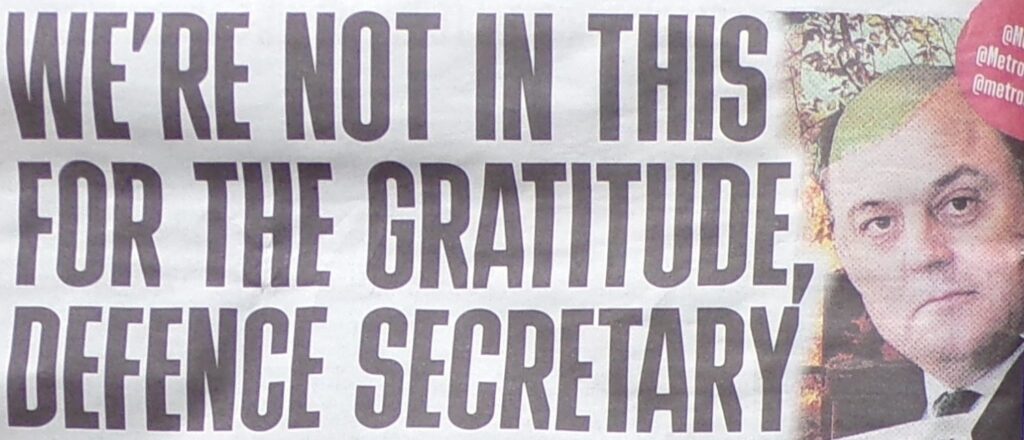
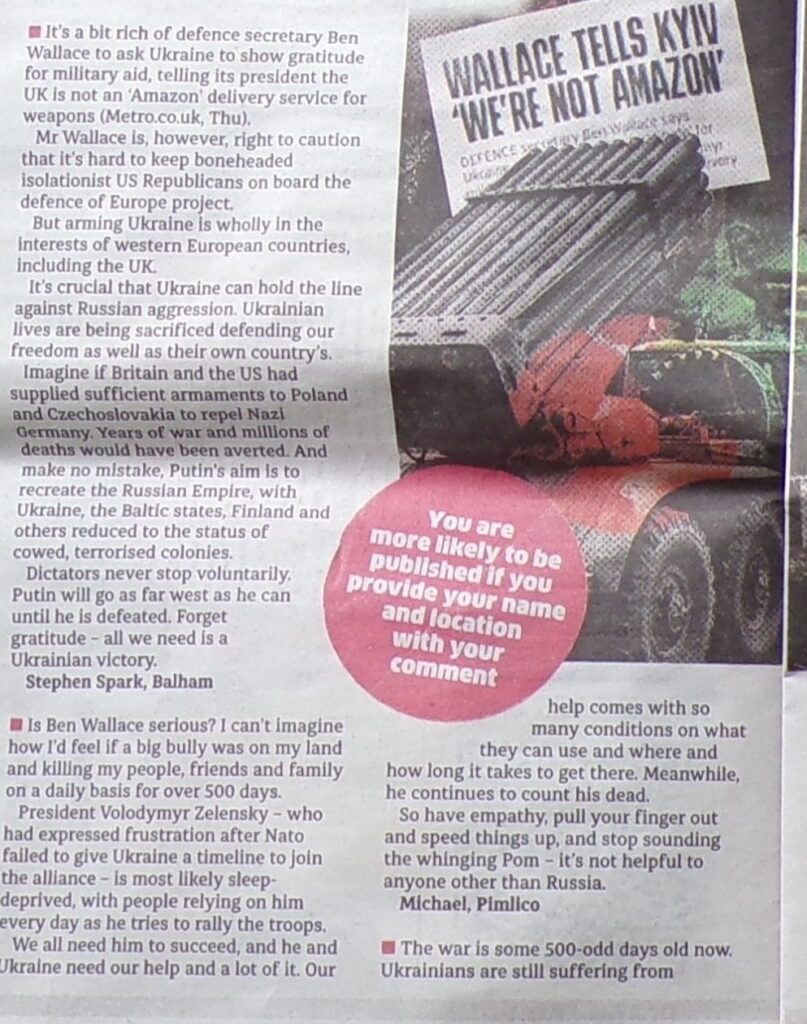
Ukraine war: Zelensky’s government launches anti-corruption drive
- Published
- 27 January
Related Topics
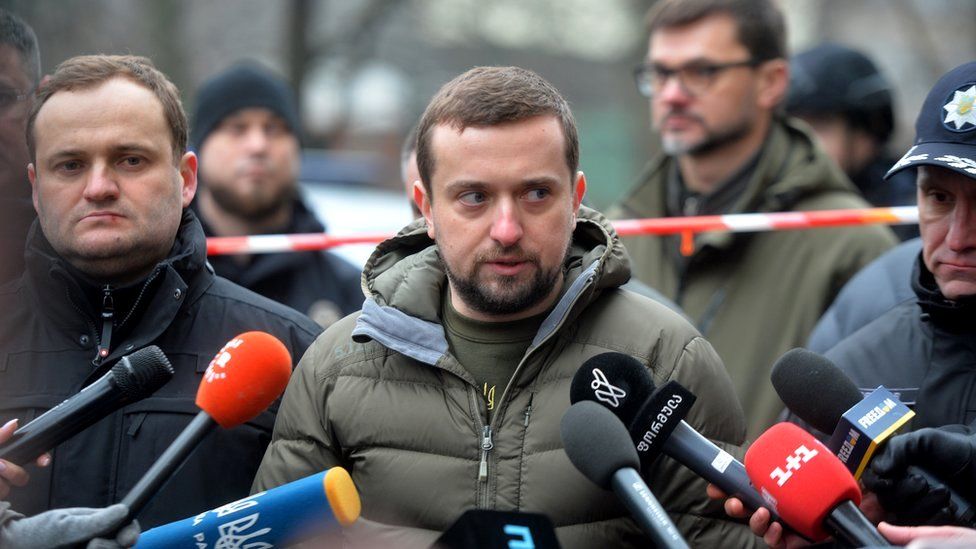
By James Waterhouse
BBC Ukraine correspondent
It’s been a political reshuffle with a difference.
At the time of typing this, 11 officials have either resigned or been sacked as Kyiv tries to tackle government corruption.
It’s led to some politicians in the US calling for aid to Ukraine to be restricted.
President Volodymyr Zelensky is trying to quickly restore public faith, but the allegations are serious, and the timing is bad.
Several claims have surfaced thanks to Mykhaylo Tkach, an investigative journalist for the news website Ukrayinska Pravda.
He has recently reported that the company of a senior official’s personal trainer allegedly received millions of pounds since the full-scale invasion, as well as a story about President Zelensky’s deputy head of office.
Kyrylo Tymoshenko quit two months after Tkach reported that he’d moved his family to the mansion of a well-known property developer.
The journalist also published footage which appeared to show the official driving an expensive Porsche for a few months.
Mr Tymoshenko has denied doing anything wrong.
“Quite often, with MPs and officials, if the source of their money isn’t clear, they register assets to people close to them,” explains Tkach.

“These are signs of non-transparency, at a time when every step of an official should be clear for society.”
The reporter concedes corruption exists in many countries. It’s why he thinks the reaction to it is most important.
From her bakery in Vorzel, near Kyiv, Ivanna is less than impressed with her government being accused of agreeing to pay inflated prices to an unknown firm, a deputy minister allegedly accepting a bribe worth £300,000 ($372,000), and an official’s expensive taste in cars.
“I don’t like it,” she says, while her husband Vyacheslav stirs dough in the back room.
“It would be better for this money to go towards something good for Ukraine.”
She pauses: “We need to replace all those politicians who’ve been there for many years. They’ve got used to it; it feeds them.”
For Ukraine, receiving billions of dollars in military, humanitarian and financial aid brings responsibility and scrutiny.
It also increases the likelihood of money ending up in the wrong hands.
“We are talking about Ukraine’s existence,” says Tkach. “It’s not just some ordinary year for our country. So, I think this wave of resignations, initiated by the president, is an important acknowledgement and necessary action.”
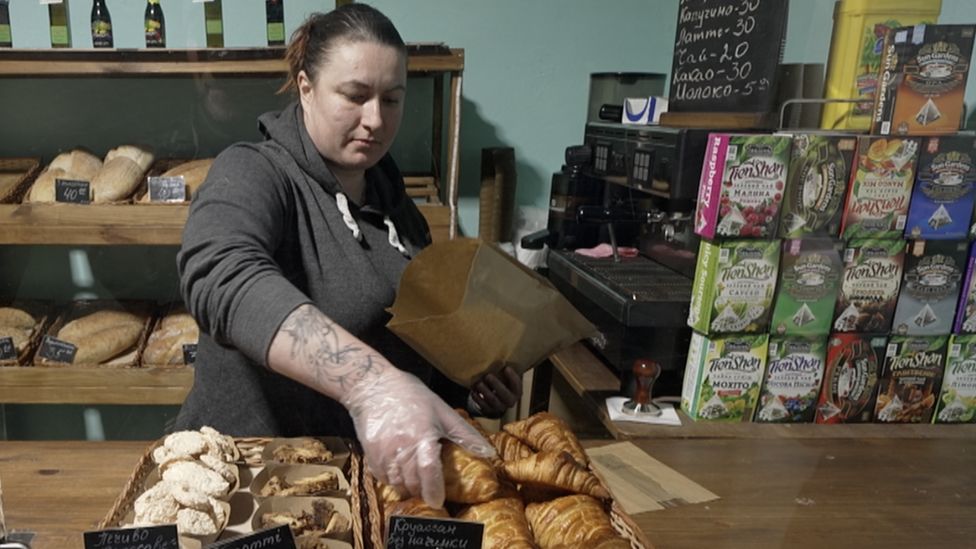
In 2014, a popular revolution toppled the last Moscow-leaning government because people wanted to finally live under a democracy.
Ever since Ukraine declared independence 31 years ago, corruption has plagued its public services and most of all its politics.
Ever since, Ukraine has attempted a series of reforms, notably driven by Russia’s subsequent campaign of aggression towards the country. Change was seen as essential to securing the West’s continued support.
New anti-corruption agencies were then set up, along with new systems for government spending, a new police force, and politicians were forced to disclose their wealth – often with eye-watering confessions.
“We wanted results,” Yaroslav Yurchyshyn tells me. He’s an MP and deputy head of the parliamentary anticorruption committee.
“Yes, we have some leftovers from corruption in the past, but at least now we are not silent about it. The next stop will be prevention.”
BBC
We have some leftovers from corruption in the past, but at least now we are not silent about it
Yaroslav Yurchyshyn
Ukrainian MP
Mr Yurchyshyn believes there’s no better time to expose ministerial wrongdoing, even with Western help being put at risk.
“Western partners understand we have two wars,” he says. “The first is against Russia, then there’s our internal war for the future of Ukraine.”
Before the full-scale Russian invasion of February 2022, Western allies like the European Union and the US weren’t happy with the pace of Kyiv’s efforts to combat corruption.
While it’s not clear what the political damage of the 2023 allegations will be for President Zelensky, his response to them this time has been described as “quick and decisive” by the US.
With more allegations expected to surface, he’ll be hoping other supporters feel the same.
Additional reporting by Hanna Chornous and Siobhan Leahy
August 6th 2023
Ukraine war: Russia hits blood transfusion centre, says Zelensky
Related Topics

By Jaroslav Lukiv
BBC News
A Russian “guided bomb” has hit a blood transfusion centre in north-eastern Ukraine, killing two people and injuring four, Ukrainian officials say.
Volodymyr Zelensky posted an image of the building on fire as a result of Saturday night’s attack around Kupiansk, in the Kharkiv region.
“This war crime alone says everything about Russian aggression,” he said.
Russia has not commented. It has previously denied all allegations of targeting civilians – or war crimes.
The city of Kupiansk and nearby settlements were seized by Russian troops in the first few days of Moscow’s full-scale invasion of Ukraine, launched in February 2022.
The area was liberated during a Ukrainian counter-offensive last September, but comes under missiles and shelling daily.
In a post on social media, Mr Zelensky described the perpetrators as “beasts”.
“Defeating terrorists is a matter of honour for everyone who values life,” he added.
Mr Zelensky did not give details of the casualties. But local officials later posted the same image adding details about the attack on what they described as a non-residential building.
President Zelensky also said that on Saturday Russia separately carried out a missile attack, targeting an aeronautical company run by group Motor Sich in the western Khmelnytskyi region.
On Sunday, Russia’s air defences destroyed a drone as it approached Moscow, the city’s mayor, Sergei Sobyanin, said.
Last week, an office block on a Moscow skyscraper was hit two days in a row by Ukrainian drones, Russian authorities said.
Ukraine has not publicly admitted carrying out such attacks.
Moscow has also accused Ukraine on Saturday of hitting a Russian tanker with 11 crew members in the Black Sea – the second such sea drone attack in as many days.
Russian maritime officials said the engine room of the Sig tanker was damaged in the attack in the Kerch Strait. No-one was injured.
The Kerch Strait connects the Black Sea and the Sea of Azov, separating Crimea – Ukraine’s peninsula annexed by Moscow in 2014 – and Russia’s Taman peninsula.
Ukraine has not publicly commented. But a Ukrainian security service source told the BBC a sea drone had been used.
In another development, the Chonhar road bridge linking mainland Ukraine to Crimea was hit by a Ukrainian missile strike on Sunday, according to Russia’s RIA news agency.
This is the second time Ukrainian missiles have hit the bridge after an earlier attack in June forced it to close for repairs.
Moscow-installed Kherson regional governor Vladimir Saldo wrote on Telegram that another small bridge, connecting the port city of Henichesk and the narrow Arabat Spit on Crimea’s north-east coast, had been shelled.
A civilian driver was hurt and a gas pipeline was damaged, leaving 20,000 people without gas.
https://emp.bbc.co.uk/emp/SMPj/2.50.2/iframe.htmlMedia caption,
Watch the sea drone hitting the tanker, according to Ukraine security sources
Related Topics
- Ukrainian sea drone targets Russian tanker. Video, 00:00:22Ukrainian sea drone targets Russian tanker
- Published1 day ago
0:22
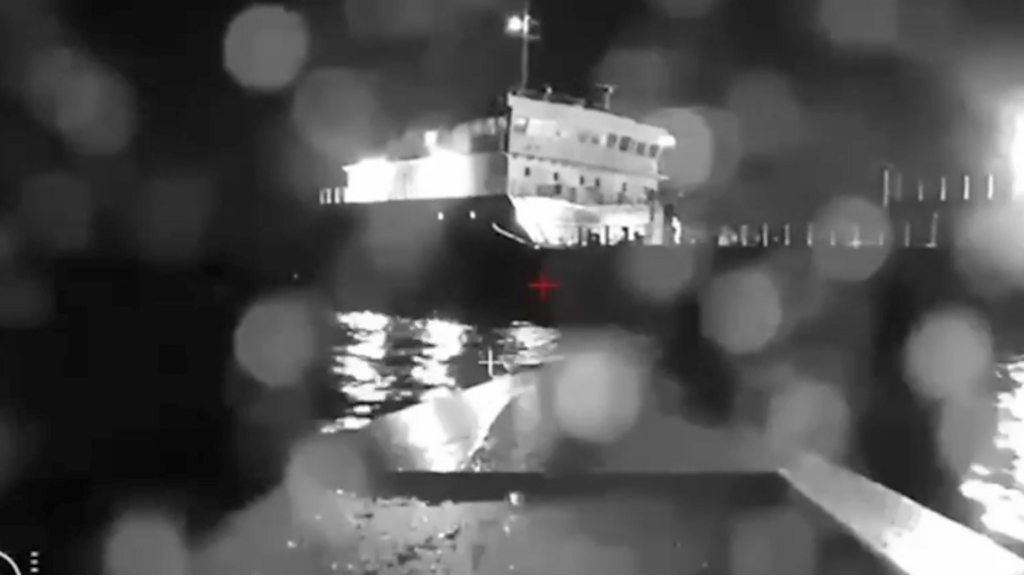
Russian tanker hit in attack near Crimea
- Published1 day ago
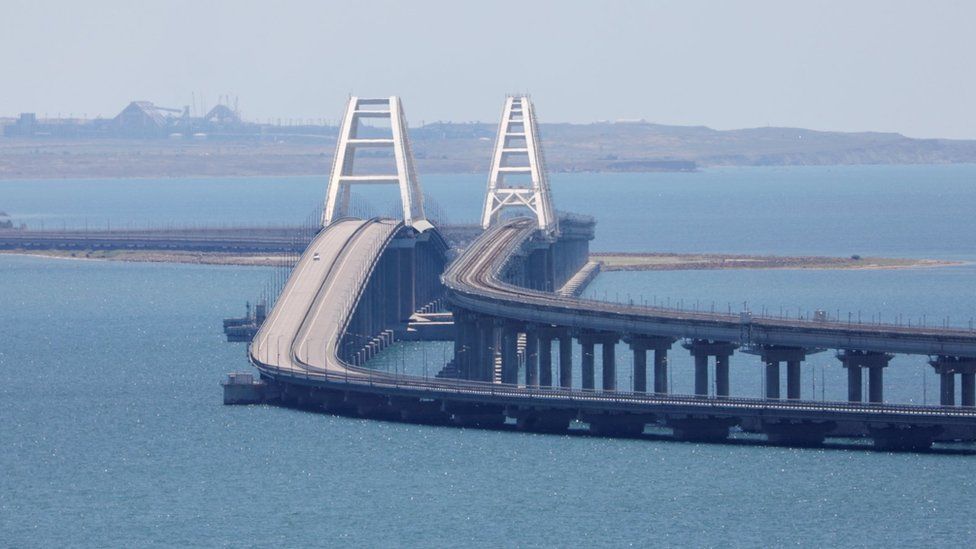
How sea drones are changing the Ukraine conflict
- Published1 day ago
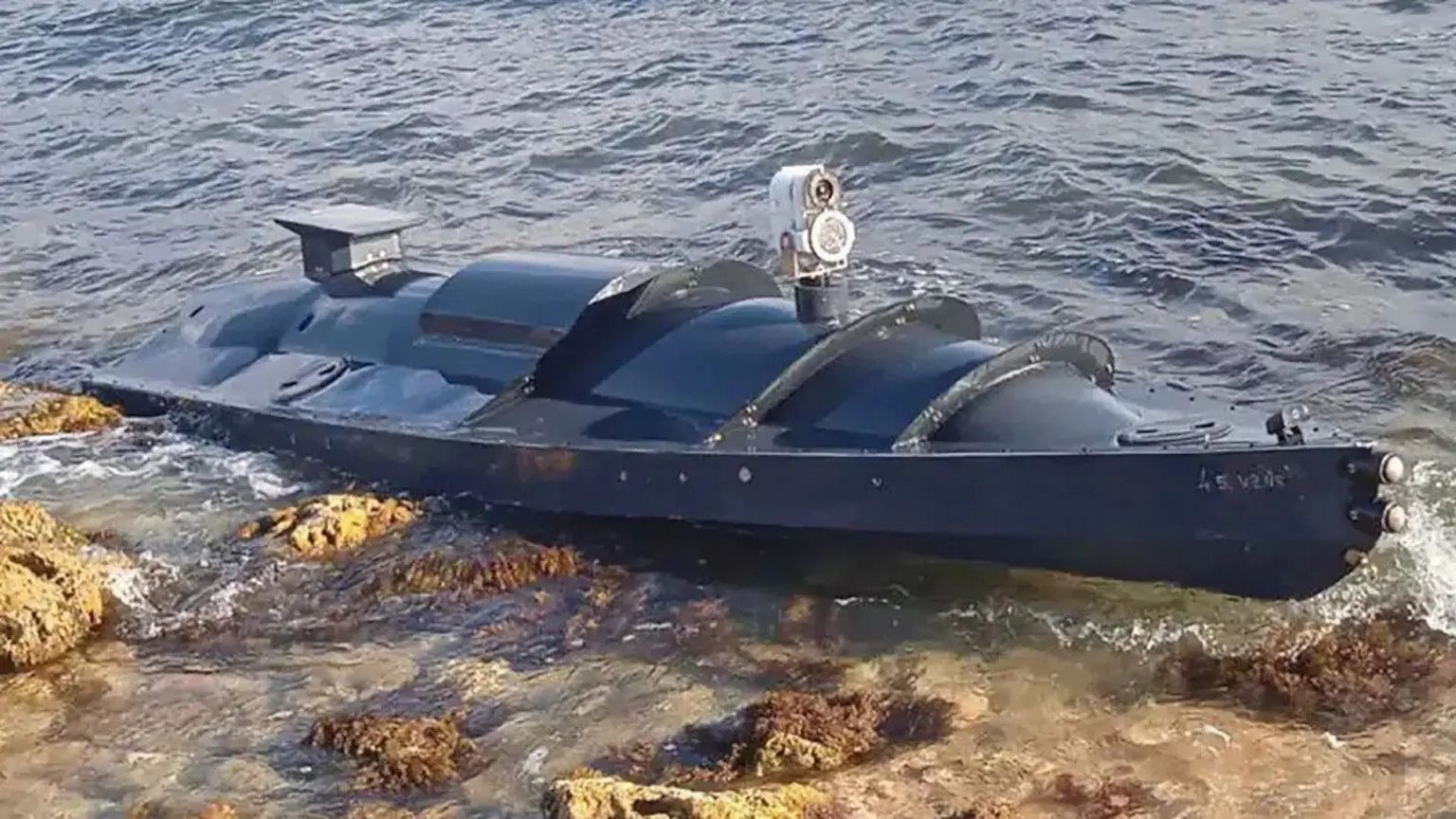
Russia’s new tactic for cutting off Ukraine’s grain
- Published4 days ago
August 4th 2023
Russian ship hit in Novorossiysk, Black Sea drone attack, Ukraine sources say
Related Topics
https://emp.bbc.co.uk/emp/SMPj/2.50.2/iframe.htmlMedia caption,
Watch: Video supplied by Ukraine’s security services shows the drone hitting a Russian vessel
By James Waterhouse in Kyiv & Kathryn Armstrong in London
BBC News
A Russian naval ship has been damaged in a Ukrainian naval drone attack in the Black Sea, Ukrainian sources say.
The assault reportedly occurred near the Russian port of Novorossiysk, which is a major hub for Russian exports.
Russia’s defence ministry said it had repelled a Ukrainian attack on its naval base there which involved two sea drones, but did not admit any damage.
But Ukrainian security service sources say the Olenegorsky Gornyak was hit and suffered a serious breach.
They told the BBC a sea drone was carrying 450kg (992lb) of dynamite when it hit the ship.
Russia made no mention of any damage in its report of the incident.
Sea drones are small, unmanned vessels which operate on or below the water’s surface.
A video sent to the BBC by a source with Ukraine’s security service appears to show the drone approaching a ship thought to be the Olenegorsky Gornyak.
The footage shows a vessel travelling right up to the side of a ship before the feed cuts out, apparently on impact.
Another video is thought to show the ship listing to one side.

The Olenegorsky Gornyak is a landing ship, designed to launch amphibious forces close to shore for beach landings but also to dock and quickly unload cargo at ports.
Any damage to it may interfere with Russia’s efforts to resupply forces fighting in occupied southern Ukraine, although the Russian fleet is unlikely to be significantly impacted.
The Novorossiysk port temporarily suspended any movement of ships following the assault, according to the Caspian Pipeline Consortium, which loads oil on to tankers at the port.
Research by BBC Verify suggests Ukraine has carried out at least 11 attacks with sea drones – targeting military ships and Russia’s naval base in Sevastopol, as well as Novorossiysk harbour in a previous attack.
This is based on announcements by Russian and Ukrainian authorities, and local media reports. Ukrainian defence sources have told CNN that sea drones had also been used in an attack on the Kerch Bridge in Crimea in July.
Friday’s attack comes just a few days after Ukraine revealed the external appearance and some details of what they have described as their “new” weapon – unmanned naval drones.
In fact, Ukraine has been using these drones to attack Russian ships since last year.
The vessels represent a new stage in the evolution of naval warfare, where small, unmanned boats can inflict damage on large ships with powerful weaponry.
This is not the first time Ukraine has tried to hit the Novorossiysk port, and the reasons are obvious.
Around 1.8 million barrels of oil are exported from there every day – around 2% of the global supply.
It is also an important naval base for Moscow.
Clashes in the sea have increased in recent weeks, after Russia abandoned a UN deal that enabled grain to be safely exported between Russia and Ukraine across the water.
Ukrainian ports have been pummelled by Russian drones and Kyiv seems to have been keen to respond.
It is also more willing to admit to strikes involving sea drones than the attacks seen further inside Russia.
Friday’s incident shows “it is possible to effectively carry out some operations which will decrease Russia’s maritime influence, military influence on the Black Sea,” President Zelensky’s adviser Mykhaylo Podolyak told the BBC.
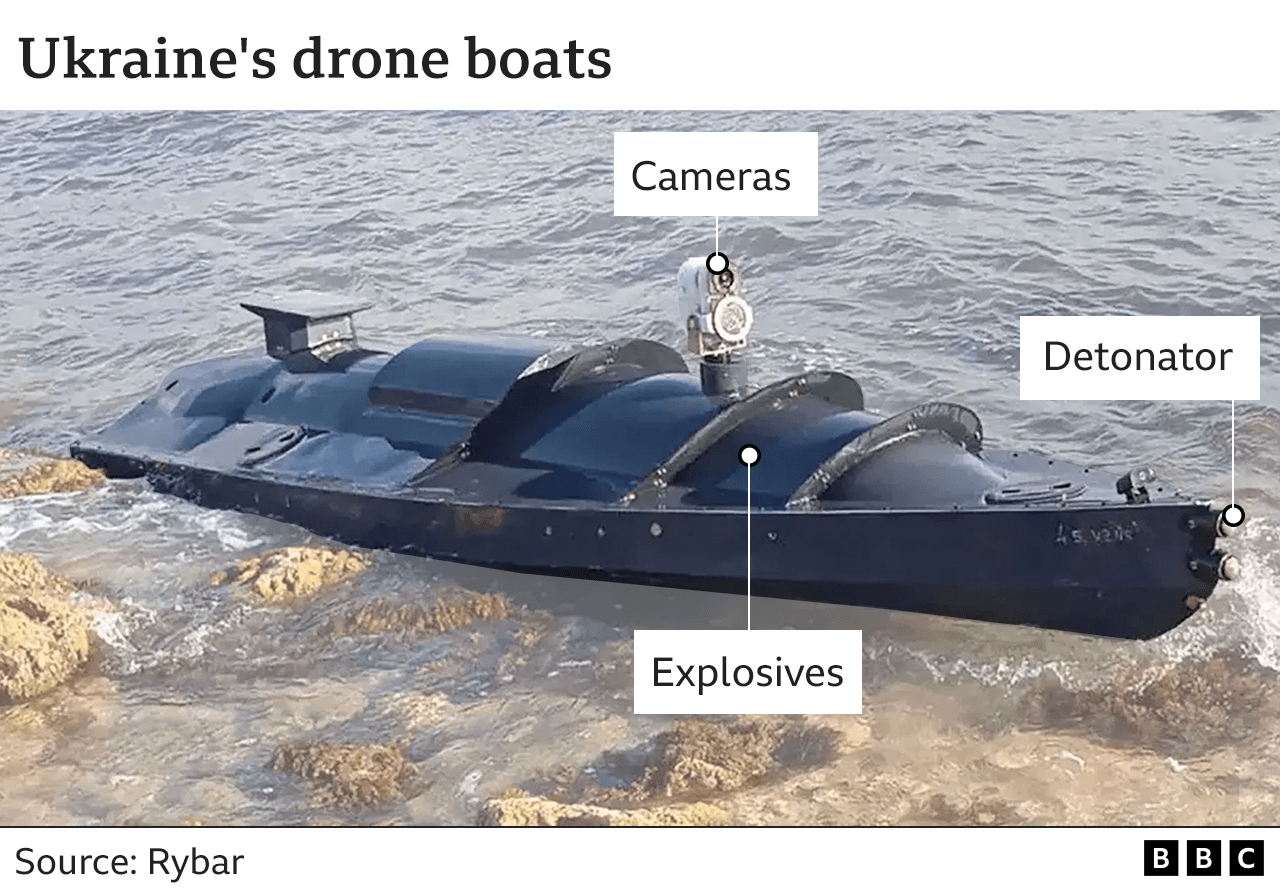
President Zelensky has warned of the war “coming to Russia”, despite suggesting a peace summit could happen “as early as the autumn”.
Neither side appears overly keen to set the conditions for that.
Earlier this week, Russia attacked big Black Sea ports of Odesa and Chornomorsk, where authorities said 60,000 tonnes of grain were destroyed, as well as ports on the River Danube.
Separately on Friday, Russia also said it had downed 10 Ukrainian aerial drones over Crimea.
Additional reporting by BBC Verify and BBC Russian
Related Topics
- WATCH: Moment sea drone approaches Russian ship. Video, 00:00:35WATCH: Moment sea drone approaches Russian ship
0:35
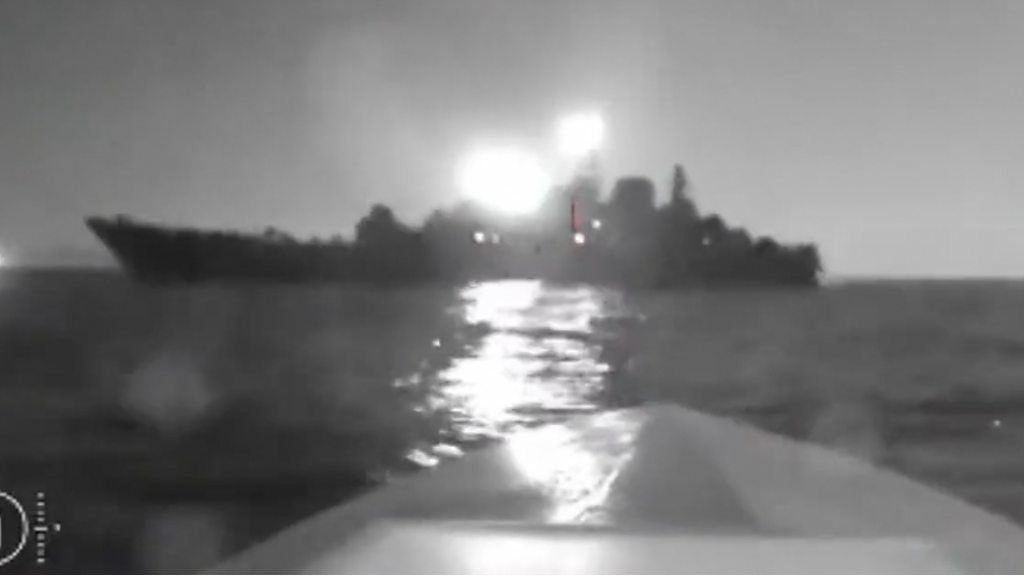
How sea drones are changing the Ukraine conflict

Russia’s new tactic for cutting off Ukraine’s grain
Comment This seething global war is breaking through the earth’s political crust. It is going to get worse. Ukraine was the NATO proxy war flash point.The reality is wider than the desert the world will soon become.
R J Cook
RAF Lossiemouth pilots intercepted 50 Russian aircraft
https://emp.bbc.co.uk/emp/SMPj/2.50.2/iframe.htmlMedia caption,
Watch: RAF jets intercept “zombie” Russian aircraft during Baltic mission
RAF Lossiemouth pilots intercepted 50 Russian aircraft during a four-month mission in the Baltic.
The crew were among personnel from the air station in Moray deployed to Estonia to help patrol Nato airspace.
The pilots’ Typhoon jets were armed during quick-reaction alerts – flights undertaken at a moment’s notice.
The RAF personnel used “zombie” as their codeword for a Russian plane acting suspiciously.
In a 21-day period, the UK pilots intercepted 21 aircraft, including intelligence-gathering planes and long-range bombers.
On Thursday, about 60 members of 140 Expeditionary Air Wing returned to Lossiemouth after handing over the role to the Spanish Air Force.
The RAF mission, codenamed Operation Azotize, came amid heightened tensions between Nato-member countries and Russia over the war in Ukraine.
The Typhoon pilots from IX (Bomber) and 1 (Fighter) squadrons shadowed Russian military aircraft as they flew through international airspace.
The RAF said the Russian crews pose a potential risk to other air traffic because they do not liaise with Nato-controlled regional air traffic agencies, or file flight plans.
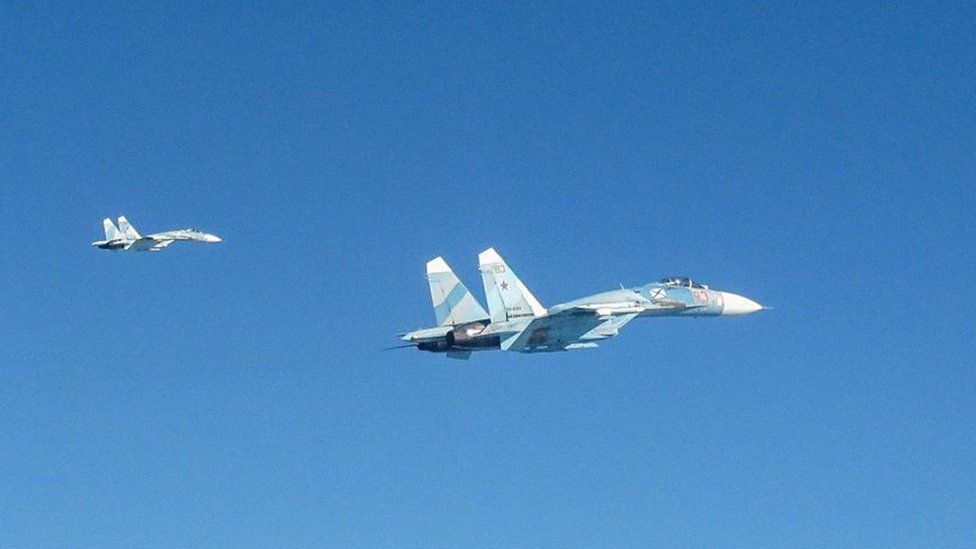
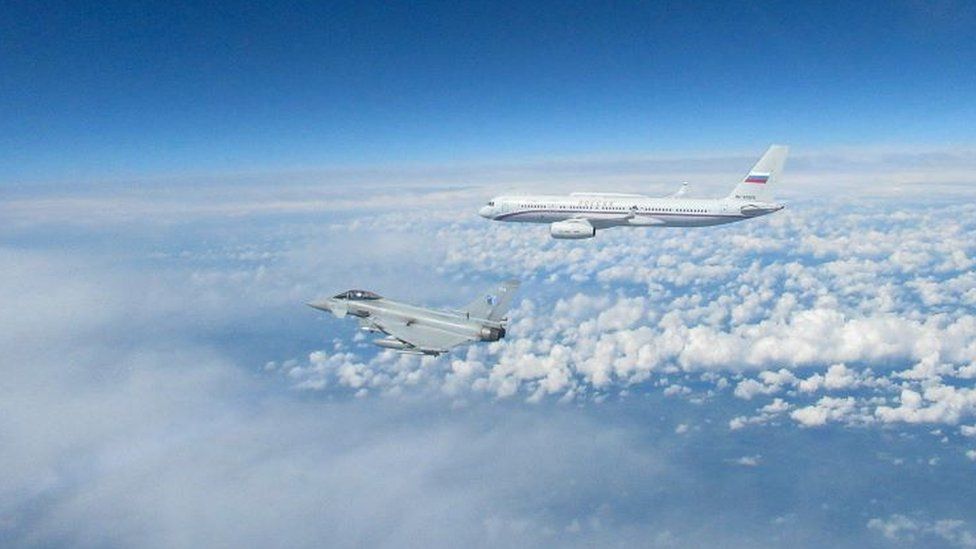
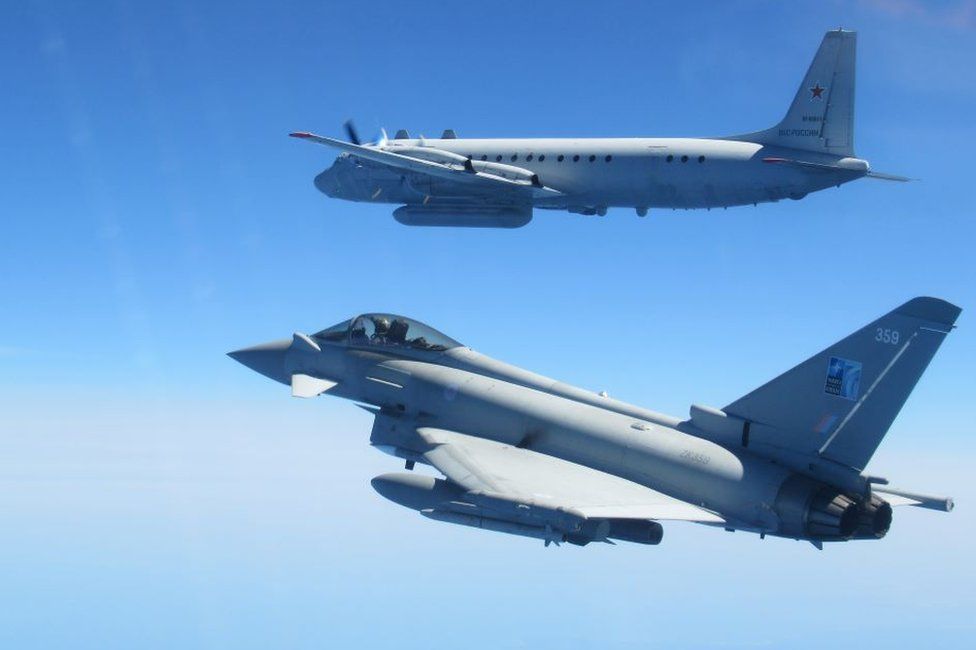
Lossiemouth-based intelligence, operations, logistics and medical staff were also deployed to Estonia’s Amari Air Base, and supported military exercises involving 22 nations, including new Nato member Finland.
Estonia, formerly part of the Russian-led Soviet Union, has been a member of the military alliance since 2004.
The RAF took over the continuing Nato mission in the Baltic from a German squadron.
Defence Secretary Ben Wallace said the Lossiemouth pilots and support personnel had spent months away from their families while policing Nato airspace.
Air and Space Commander Air Marshal Harv Smyth added: “I am extremely proud of the whole force’s hard work and dedication.
“Now that they are back in the UK, their focus will be straight back to providing UK quick-reaction alert, where they will help ensure the safety and integrity of UK airspace, 24 hours a day, 365 days a year.”
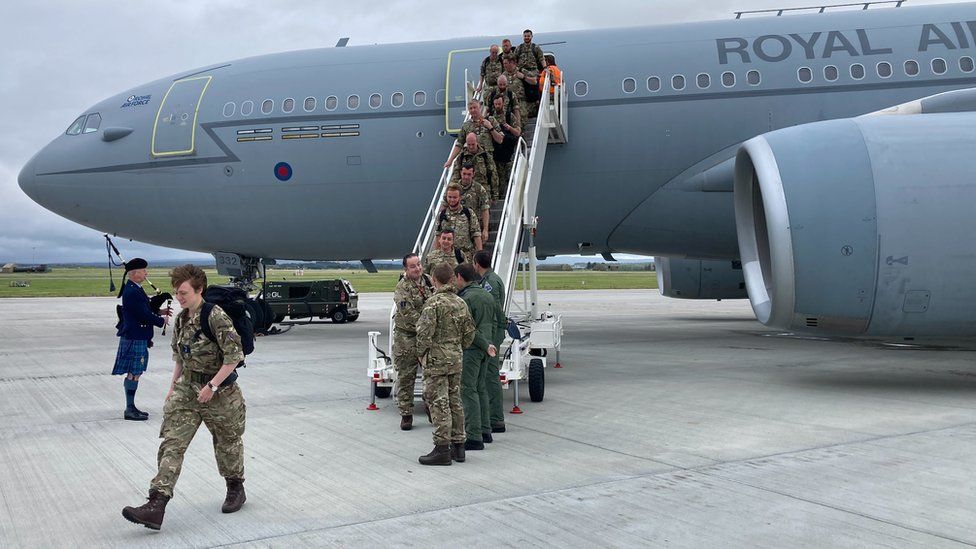
Station Commander Jim Lee welcomed squadron-9 back to Lossiemouth after they had completed the first half of the RAF Nato deployment.
He said: “They were conducting air policing operations in Estonia providing reassurance to our Nato allies in the Baltic states.
“Our typhoon pilots intercepted a variety of Russian aircrafts, ranging from VIP transports to Russian fighters, and they never knew what they were going to see on any given day.
“Intercepted is the military word for it but in reality it’s just about saying if you’re here then we’ll be here too.”
Alexei Navalny: Russian opposition leader’s jail term extended to 19 years
- Published
- 37 minutes ago

By Steve Rosenberg, Russia editor & Ece Goksedef
BBC News, in Melekhovo & London
Imprisoned Russian opposition leader Alexei Navalny has told supporters not to lose the will to resist, after his jail term was extended to 19 years.
Mr Navalny was found guilty of founding and funding an extremist organisation. He denies the charges.
He was already serving a nine-year term for parole violations, fraud and contempt of court. The charges are widely viewed as politically motivated.
The trial was held in a remote penal colony, where he has been since 2021.
The Kremlin’s most vocal critic will serve his time in a “special regime colony”, which Russian state prosecutors had been calling for.
Even more restrictive than a high security colony, such prisons are normally reserved for dangerous criminals, re-offenders and those with life imprisonment.
There he is likely to face greater isolation, with further restrictions on communications with the outside world.
He could also receive fewer visitors than he is used to, including his family and defence team, and may face longer periods of solitary confinement.
After the verdict, in a message to supporters posted for him on X (formerly known as Twitter) Mr Navalny remained defiant. “You, not me, are being frightened and deprived of the will to resist. Putin must not achieve his goal. Do not lose the will to resist,” he wrote.
For this court case the phrase “behind closed doors” felt like an understatement.
Alexei Navalny was tried in the high security prison in which he’s currently incarcerated; the proceedings were closed to the press and the public.
But for the verdict the BBC was allowed into Penal Colony Number 6 in the town of Melekhovo, 150 miles east of Moscow, where a hall was turned into a makeshift courtroom.
Along with other journalists we crammed into a small room dubbed the “press centre” to watch events on a video screen. We weren’t allowed into the makeshift courtroom itself (a prison hall) where the verdict would be announced.
As he entered the courtroom and sat down at a table, Alexei Navalny looked relaxed. For him there was no drama about this situation: in a message posted for him yesterday on social media Russia’s most prominent opposition figure had made it clear he’d been fully expecting a “Stalinist” sentence.
There was a picture on the video screen. But the audio feed from the courtroom was of poor quality and intermittent.
When the judge pronounced Mr Navalny guilty and passed sentence, it wasn’t immediately clear to the journalists watching and listening how long the new prison sentence was.
Later, Mr Navalny himself confirmed the figure, in the social media message posted for him.
“Nineteen years in a special regime colony. The figure doesn’t mean anything. I fully understand that, like many political prisoners my sentence is for life. Life is measured either by my lifespan or that of the regime.”
- Alexei Navalny: Russia’s jailed but vociferous Putin critic
- Navalny and Russia’s arsenal of exotic poisons
The new sentence “raises serious concerns about judicial harassment and instrumentalisation of the court system for political purposes in Russia,” UN human rights chief Volker Turk said in a statement.
“Putin is trying to frighten as many Alexei supporters as he can”, Mr Navalny’s press secretary Kira Yarmysh said of his sentencing.
“We have to put all our efforts in trying to get rid of Putin, and this will mean that Alexei will be free,” she added.
For more than a decade, Mr Navalny sought to expose corruption at the heart of Russian power. His video investigations have received tens of millions of views online.
A charismatic campaigner, he seemed to be the only Russian opposition leader capable of mobilising people in large numbers across Russia to take part in anti-government protests.
But in 2020, he was poisoned in Siberia by what Western laboratories later confirmed to be a nerve agent.
A later report by the investigative outlet Bellingcat and Russian news site The Insider implicated several agents of Russia’s internal security service, the FSB, in the attack.
After recovering from the attack, Mr Navalny returned to Russia in 2021 despite warnings that he could face arrest. He was immediately arrested upon arrival at Moscow’s Vnukovo airport.
Comment The Anglo Americans never talk about war crimes whistle blower Julian Assange who was forced into political asylum in London’s Ecuador Embassy before U.S organised regime change to get him thrrown into the dreadful oblivion of the Britain’s Victorian Penal system. Then there was Chelsea Manning and young U.S National Guardsman idealist Jake Txeira.. The pompous BBC is a major part of the western propagamda system. Navalny is no Assange. He is a traitor and spy in the pay of MI6.
R J Cook
August 1st 2023
More drones coming, Ukraine tells Russia after skyscraper hit
Related Video and Audio
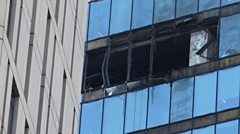
Video 1 minute 11 seconds
Video 1 minute 11 seconds1:11
Play video Does an attack on Moscow change Russia’s view of the war? from BBCDoes an attack on Moscow change Russia’s view of the war?
- BBC
Summary
- A skyscraper in Moscow has been attacked by a drone for the second time in two days
- Ukraine’s presidential adviser Mykhailo Podolyak says there will be “more unidentified drones, more collapse, more civil conflicts”
- “Moscow is rapidly getting used to a full-fledged war,” he adds
- The skyscraper is home to three Russian government teams – staff have been told to work at home
- Russia’s defence ministry blames Ukraine for the drone strikes – but Kyiv has not officially commented
- Russia also says it destroyed three Ukrainian unmanned boats that were trying to attack two Russian ships in the Black Sea
In pictures: Kharkiv attack
Two floors of a college dormitory have been damaged in overnight drone strikes in the city of Kharkiv, north-eastern Ukraine. Ukrainian authorities have blamed Moscow and said Russian drones had hit populated areas in Ukraine’s second largest city.

July 30th 2023
Zelensky after Moscow drone attack: War coming back to Russia
By James Waterhouse in Kyiv & James Gregory in London
BBC News
Ukraine’s President Volodymyr Zelensky has warned war is coming back to Russia after a drone attack on the capital Moscow.
Mr Zelensky said attacks on Russian territory were an “inevitable, natural and absolutely fair process” of the war between the two countries.
Russia’s defence ministry said three Ukrainian drones were downed on Sunday, with two crashing into offices.
Vnukovo Airport, southwest of the city centre, was also briefly shut.
The drone attack in the early hours of Sunday is the latest that Moscow has blamed on Kyiv.
And in a video address on Sunday from the western Ukrainian city of Ivano-Frankivsk, Mr Zelensky said that Ukraine was getting stronger.
“Today is the 522nd day of the so-called ‘Special Military Operation’, which the Russian leadership thought would last a couple of weeks,” he said.
“Gradually, the war is returning to the territory of Russia – to its symbolic centres and military bases, and this is an inevitable, natural and absolutely fair process.”
This characterisation is certainly a level up from Kyiv’s normal approach of not admitting responsibility for attacks inside Russia.
It may be far from a confession, but President Zelensky clearly feels confident enough to pile on the pressure, and not just on the Kremlin.
Drone attacks like these are also an opportunity for him to address the Russian population, the majority of whom appear to believe Moscow’s invasion is just and righteous.
If they connect explosions close to home with what’s going on in Ukraine, as per Mr Zelensky’s suggestion, it makes it that bit harder for Vladimir Putin to justify his invasion, which he is only looking to expand.
- Putin says he does not reject peace talks on Ukraine war
- Ukraine trying to frighten Russians – Putin
Officials said there were no injuries following the drone attack, and the city’s mayor Sergei Sobyanin said the facades of two office buildings were slightly damaged.
Photos from the scene show that several windows have been damaged at the corner of the buildings, with debris scattered on the ground below.
One eyewitness, who only gave her first name as Liya, told Reuters news agency she could see fire and smoke.
“We heard an explosion and it was like a wave, everyone jumped,” she said.
“Then there was a lot of smoke and you couldn’t see anything. From above, you could see fire.”
Flights were briefly suspended from Vnukovo Airport, southwest of the city centre, and incoming planes were redirected to other airports.
In a statement, the defence ministry said the “attempted terrorist attack” had been “thwarted”.

Moscow, located about 500km (310 miles) from the Ukrainian border, has rarely been targeted since Russia launched its full-scale invasion of Ukraine in February 2022.
But Russia has accused Ukraine of launching a series of drone strikes on its territory in recent months, including several on the capital.
The most notable was in May, when Russia claimed Ukraine used two drones to attack the Kremlin – the heart of the city. Ukraine denied attacking the Kremlin or targeting President Vladimir Putin.
Russia’s defence ministry says Ukraine also carried out an overnight drone attack on Crimea – territory which was annexed by Russia in 2014. Officials say 16 drones were destroyed and a further nine were suppressed, Tass news agency reports.
Meanwhile, Ukrainian officials say a Russian missile attack on the city of Sumy, in the north east of the country, has left one person dead and five injured.
A building was destroyed in an explosion at about 20:00 local time (17:00 GMT), according to public broadcaster Suspilne.
Officials also say two people were killed in the southern city of Zaporizhzhia on Saturday.
Comment
There are the idiots and ignorant happy on their moralising high plain, deluded and deluding others that this is not all about Anglo U.S NATO led regime change war on Russia. Africa is a big issue in this war. So is the Middle East. Hence the craving for control of the Black Sea and NATO issues with Syria and Iran. Vladimir’s Putin’s offerings for negotiations are appeasement. Zelensky is an actor and opporunist chosen as front man for this violation of the Minsk Agreement. There would be no war without NATO. So Russia either surrenders to stop more attacks or attacks NATO. The maths is simple.
R J Cook
All The Criminals – R J Cook
Comment Russia will have to intensify its front line activity if it is to deter NATO. Unless Russia makes clear absolute threatening statements to NATO and elite media this agony will go on and on in third gear. It is as simple as that. NATO is an aggressive pernicious force for the planet eating global elite who lead it. It is a block on freedom within a progressive caring balanced just world order. Politically correct western dogma and backward looking religious bigotry are a terrible and expanding support to the NATO cause.. Lies, deceit, corruption, and greed rules the western way. ‘All the criminals in their coats and their ties , are free to drink Martinis and watch the sun rise’ – Bob Dylan ( Huuricane ).

R J Cook & Sons 1996.
Ukraine war: Putin says Russia does not reject peace talks
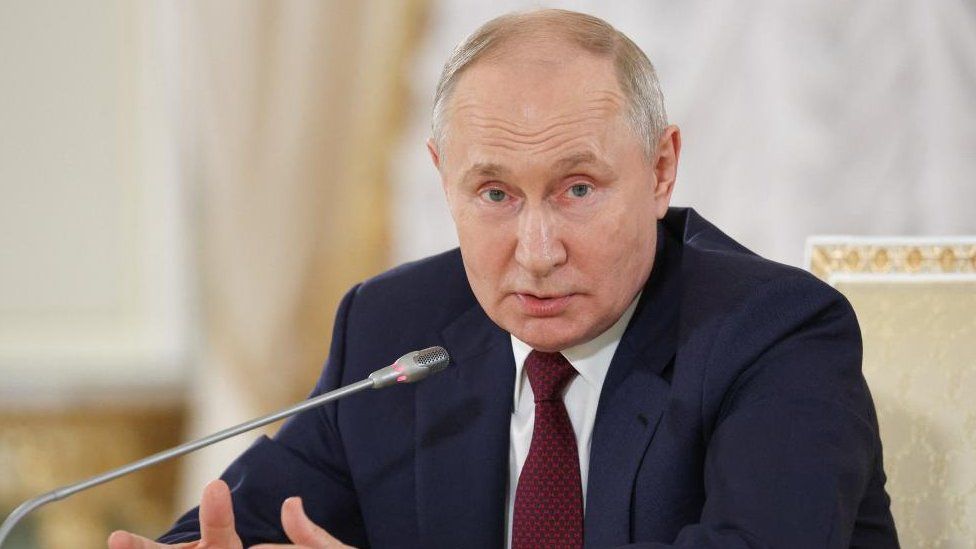
By Marita Moloney
BBC News
Russian President Vladimir Putin has said he does not reject the idea of peace talks on Ukraine.
Speaking after meeting African leaders in St Petersburg, he said African and Chinese initiatives could serve as a basis for finding peace.
President Putin also said it was hard to implement a ceasefire when the Ukrainian army was on the offensive.
Ukraine and Russia have previously said they will not come to the negotiating table without certain preconditions.
Kyiv says it will not concede any territory but Moscow says Kyiv must accept its country’s “new territorial reality”. Russia invaded its neighbour last year and is occupying territory in the country’s south and east.
Mr Putin told the late-night press conference on Saturday that there were no plans to intensify action on the Ukrainian front for now.
He also defended the arrest of critical voices, claiming some people were harming Russia from inside.
Criticism of Moscow’s invasion of Ukraine is outlawed and most prominent opposition members are behind bars or in exile.
In the wide-ranging briefing, the Russian president also told reporters that Moscow carried out some “preventive strikes” after an explosion on a Crimean bridge earlier this month.
Following the bridge incident – which left two people dead – Mr Putin vowed to respond to what he claimed was a “terrorist” act by Ukraine. Kyiv did not officially say it was responsible for the blast on the bridge, which links the occupied peninsula to Russia.
The Russia-Africa summit comes after an African contingent including leaders and representatives from seven countries met Ukraine’s President Volodymyr Zelensky and Mr Putin last month.
- What did African leaders’ Ukraine mission achieve?
- War in maps: Fighting in south Ukraine intensifies
In the north-eastern Ukrainian city of Sumy, one person was killed and five others injured after a rocket attack, the country’s interior ministry said.
The ministry said on Telegram that a Russian missile hit an educational institution on Saturday evening. The BBC has not verified this information.
Elsewhere, two people were killed and another was injured after a missile hit “an open area” in the southern Ukrainian city of Zaporizhzhia on Saturday, an official said.
Anatoliy Kurtiev, secretary of the city council, said the blast wave caused by the “enemy missile” blew out apartment windows and damaged an educational institution and supermarket.
Russia said two office blocks were damaged in a drone attack on Moscow in the early hours of Sunday.
The city’s mayor Sergei Sobyanin said no one was injured in the attack, which he blamed on Ukraine.
The airspace over Moscow was temporarily closed but Vnukovo Airport has since reopened.
President Zelensky has been visiting Ukrainian special forces near Bakhmut, the city where some of the fiercest fighting of the war has been taking place.
Ukrainian authorities have said Kyiv’s troops are gradually moving forward near the eastern city, which Russian forces seized in May.
July 29th 2023
Dnipro: Russian missiles hit apartment block and security service building
Related Topics
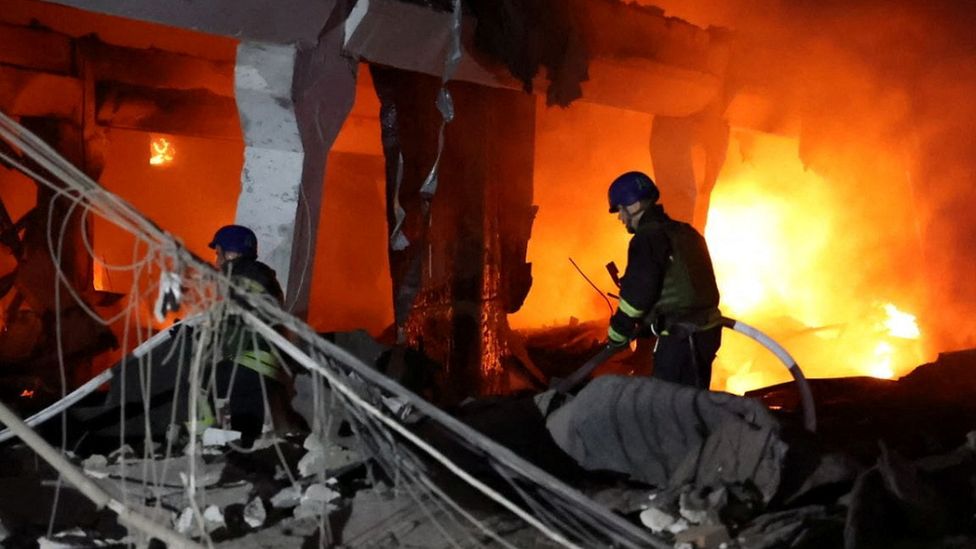
By Marita Moloney
BBC News
At least nine people have been injured including two children after missiles hit two buildings in the eastern Ukrainian city of Dnipro, officials say.
A BBC team on the ground confirmed the top floor of a large residential tower block was almost completely destroyed in the strike on Friday evening.
A building belonging to Ukraine’s security services (SBU) was also hit, President Volodymyr Zelensky says.
He blamed “Russian missile terror”.
Mr Zelensky posted a video on Telegram showing smoke rising from damaged buildings and a fire at street level.
He said he had convened emergency meetings with the SBU, interior ministry, emergency services and local officials following the incident.
Regional head Serhiy Lysak said that two children, aged 14 and 17, were among the injured. He added that they were being treated at home.
No deaths have been reported following the strike, which happened at 20:30 local time (17:30 GMT) according to Mr Lysak.
The latest strike was the third time the SBU building had been targeted by Russia, according to Dnipro Mayor Borys Filatov.
Both buildings were largely empty, he said, adding that the residential building had recently been completed and units were being put up for sale.
It comes after Russia said on Friday it had intercepted two Ukrainian missiles over its southern Rostov region, bordering Ukraine.
Moscow said 15 people were hurt by debris falling in the southern port city of Taganrog.

The Russian defence ministry said the first S-200 missile was aimed at “residential infrastructure” in the city of around 250,000 people.
Shortly after, it said it downed a second S-200 missile near the city of Azov, with debris falling in an unpopulated area.
Rostov region Governor Vasily Golubev said 15 people suffered “light injuries” from shards in an explosion near the “Chekhov Garden” cafe in central Taganrog.
Taganrog is located on the coast of the Sea of Azov and about 25 miles (40km) from the border with Ukraine.
The city is also on a road leading to the port city of Mariupol, the strategic port city devastated by Russian shelling.
Comment The BBC moralising along with all their jingoistic published comments is nauseating in my view. This site comes with a virus and unsafe warning in my native U.K – a country run for and by the super rich and rampamt bourgeois feminists. Only the U.K authorities, notably police, read it here. The feminists are obsessed with ‘keeping women safe’,. ’empowerment’ and castrating men or turning them gay. They are perfect cover for this ugly NATO proxy war for regime change, raping the land and fighting to maintain global dominance.
The BBC is the world’s leading propogandist. The masses have bought into the myths of the past world wars, Dunkirk, monarchy and a colourful heroic empire. So we read judgements like the BBC bulletin above. NATO’s victories and aspirations are not mine. They are devious megalomaniacs. Zelensky is one of too many profiteering from the slaughter and pollution that they will push to the limit to satisfy their insatiable greed. Africa and the Middle East are also very big issues. Russia offers development in those areas. NATO exists to keep chosen dictators in power, exploit the resources and the cheap ethnic labour taking to the sea in small boats for a ‘better life’in European Nirvana.’
R J Cook
July 28th 2023
Ukraine moves Christmas Day in snub to Russia
Related Topics
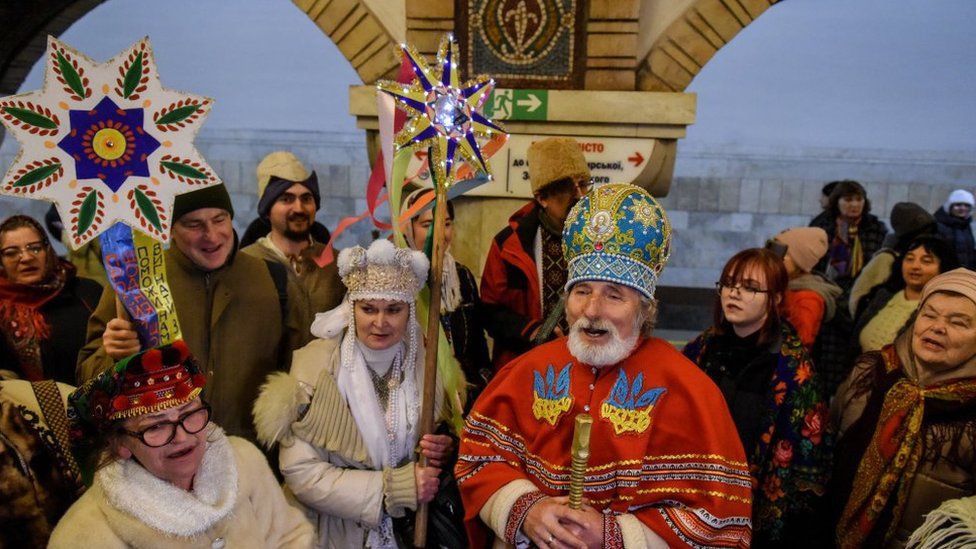
By Jaroslav Lukiv
BBC News
Ukraine has moved its official Christmas Day state holiday from 7 January to 25 December, the latest move aimed at distancing itself from Russia.
President Volodymyr Zelensky signed into law a parliamentary bill that aimed to “abandon the Russian heritage of imposing Christmas celebrations”.
In recent years, Kyiv has been cutting religious, cultural and other ties with Russia, aligning itself with the West.
This process escalated following Russia’s full-scale invasion in 2022.
Mr Zelensky signed the bill on Friday – two weeks after it had been passed by Ukrainian lawmakers.
The legislation also moves another two state holidays, Day of Ukrainian Statehood, from 28 July to 15 July, and the Defenders’ Day, which commemorates armed forces veterans, from 14 October to 1 October.
Moscow has so far made no public comments on the issue.
For centuries, first imperial Russia and then the Moscow-dominated Soviet Union had tried – but always failed – to totally control Ukraine.
This included the imposed authority of the Russian Orthodox Church (ROC) over Ukraine’s churches.
But in 2019, the recently formed Orthodox Church of Ukraine (OCU) was granted independence by Ecumenical Patriarch Bartholomew, the spiritual leader of Orthodox Christians worldwide.
The move provoked a furious response in the ROC, which is openly defending President Vladimir Putin’s invasion of Ukraine.
Until this year, the OCU – like several other Orthodox churches, including the ROC – celebrated Christmas Day on 7 January, in line with the Julian calendar.
But the OCU has now officially switched to the more-precise Gregorian calendar used in most parts of the world.
In recent years many Ukrainian worshippers have been joining the OCU, and the majority of them are now likely to be celebrating Christmas on 25 December.
There will also be those marking Christmas twice.
At the same time, millions still follow the Ukrainian Orthodox Church (UOC), the other established branch with parishes all over the country.
The UOC has not commented on the latest developments.
It officially declared a split from Moscow in 2022 – but a number of its clerics have recently been prosecuted for pro-Russian activities.
The UOC says there is no evidence to support the charges of collaboration.
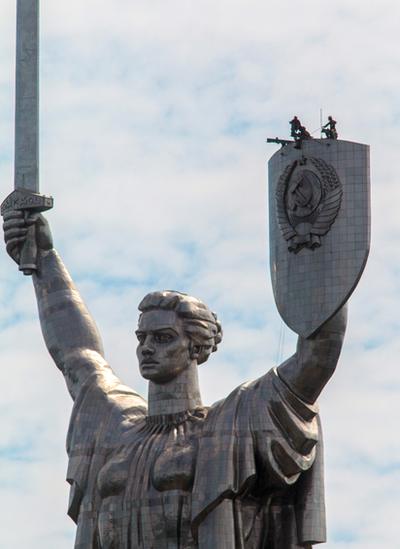
Ukraine’s decision to move Christmas is the latest step by the country to distance itself from its north-eastern neighbour.
Cities and villages all over Ukraine have recently seen renaming of their streets linked to Russian and Soviet historical figures.
Similarly, a number of monuments have been taken down, and Russian films made after 2014 banned in Ukraine.
Those measures followed Russia’s illegal annexation of Ukraine’s southern Crimea peninsula in March 2014.
Comment Who cares about Christmas Day in western world of fake Christianity ? Jesus wasn’t a Christian. He was a critic of his native Judaism, executed because of it. Christianity was a political invention, notably Roman Catholicism and the Islamic spin off – followed by the expedient Protestantism. Religion is paradoxically a force for hypocrisy and evil. The NATO proxy war on Russia is about violence, slaughter, waste ,pollution , slaughter, grief and greed. The world needs to get past religion. If Ukraine loves the west so much it so much , its’ inhabitants will know that Christmas Day is about waste, useless presents,over eating, hypocrisy and alcoholism.
12 percent of the world’s Christians wait until January 7 to celebrate Christmas. Orthodox Christmas is celebrated by approximately 260 million people worldwide, both in majority-Orthodox countries in Eastern Europe, like Russia and Greece, and in communities in Ethiopia, Egypt, and elsewhere. Zelensky is Jewish. On Nittel Nacht – otherwise known to the world as Christmas Eve – Hasidic Jews believe that evil inclinations are at full force. In order to prevent any damages that may be caused from such phenomena, they abstain from learning Torah. These Jews celebrate Christmas in January.
While the rest of the world enjoys their after-Christmas sales, in the Holy Land, two more Christmas holidays are yet to come. The Holy Land is unique in celebrating Christmas three times Dec. 25 (Catholics and Protestants), Jan. 6 (Orthodox) and Jan. 19 (Armenian Orthodox only in Jerusalem)– more than any other place in the world.
R J Cook
June 25th 2023
Ukraine war: Russia expands pool of men eligible for call-up
Related Topics
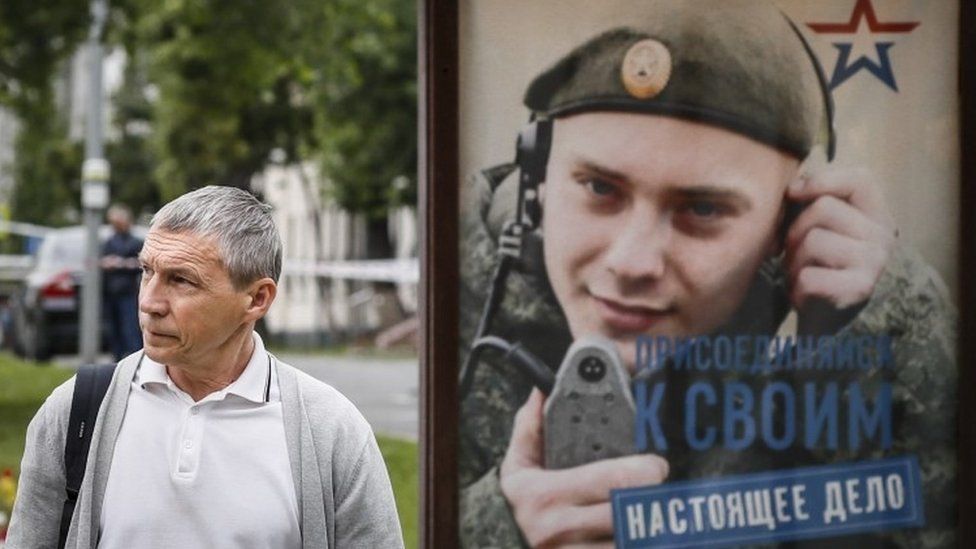
By Robert Greenall
BBC News
Russia is raising the maximum age at which men can be conscripted from 27 to 30, making more of them liable to serve in the armed forces.
The change was passed by the lower house of parliament on Tuesday.
It still needs to approved by the upper house and by President Vladimir Putin, but this is seen as a formality.
The package of measures comes as Moscow seeks to boost troop numbers to defend territory gained in its invasion of Ukraine last year.
Russia is thought to have sustained heavy casualties in nearly a year-and-a-half of fighting, but the Defence Ministry is reluctant to release figures.
Last autumn, the government announced a mobilisation of 300,000 reservists, but as a result, tens of thousands of men left Russia.
In a separate measure last week, the maximum age at which reservists can be called up was raised, meaning some men will now be considered available for military service until they are 55.
The State Duma passed the conscription bill in its second and third readings. Once signed, it is due to come into force on 1 January next year.
All men of conscription age are expected to serve a year of compulsory military service.
The latest measures go further than the Defence Ministry’s original proposal, which sought to change the conscription age range from 18-27 to 21-30. The lower age limit will continue to be 18.
“The wording of the draft law changed because the demographic situation is serious and affects the volume of the mobilisation resource,” Andrei Kartapolov, head of the Duma’s defence affairs committee, told Interfax news agency.
He added that “many lads want to go and serve at 18”.
The draft law also bans men from leaving the country from the day of their call-up. Since April, conscription papers can be issued online instead of in person.
In addition, men who fail to report for conscription will be liable for fines of up to 30,000 roubles ($332), a tenfold increase.
Comment BBC is a leading Stat Propogandist across the world. The U.K elite needs this greedy war. Their masses are paying for it while they get the profit. R J Cook.
Related Topics
July 24th 2023
Ukraine war: Russia hits Odesa after killing grain deal
By James Waterhouse
BBC Ukraine Correspondent, Odesa
The Ukraine Grain Deal. 22 July 2022 – 17 July 2023.
A short life, with its flaws, but the only diplomatic light in the darkness of Russia’s invasion.
It had allowed Ukraine to export its grain to the world through the Black Sea.
A third less than normal, but still 33 million tonnes. However, in recent months, its health had deteriorated.
Russia was accused of slowing the route with naval blockades and long inspections, and the deal finally succumbed.
Last week saw Moscow’s official withdrawal. Russia then launched a wave of missile strikes on ports it once promised to leave alone.
EXPLAINED: What was the Ukraine grain deal?
One site destroyed was a grain terminal owned by one of Ukraine’s biggest producers, Kernel. Officials say more than 60,000 tonnes of grain has been destroyed in the past week.
“We stopped our exports for the first two to three months of the war,” explains Yevhen Osypov, Kernel’s CEO.
“The prices of oil and grain went up by 50%, and you can see the same happening again now.”
While global grain supplies seem to be stable for now, global markets saw the price of grain rise by 8% within a day of Russia pulling out – the highest daily rise since its full-scale invasion of Ukraine in February last year.
Russian President Vladimir Putin now says his country “is capable of replacing the Ukrainian grain both on a commercial and free-of-charge basis, especially as we expect another record harvest this year”.
In an article published on the Kremlin’s website ahead of this week’s Russia-Africa summit, President Putin wrote that “Russia will continue its energetic efforts to provide supplies of grain, food products, fertilisers and other goods to Africa”.
Both Russia and Ukraine are among the world’s leading grain exporters.
Both Russia and Ukraine are among the world’s leading grain exporters.
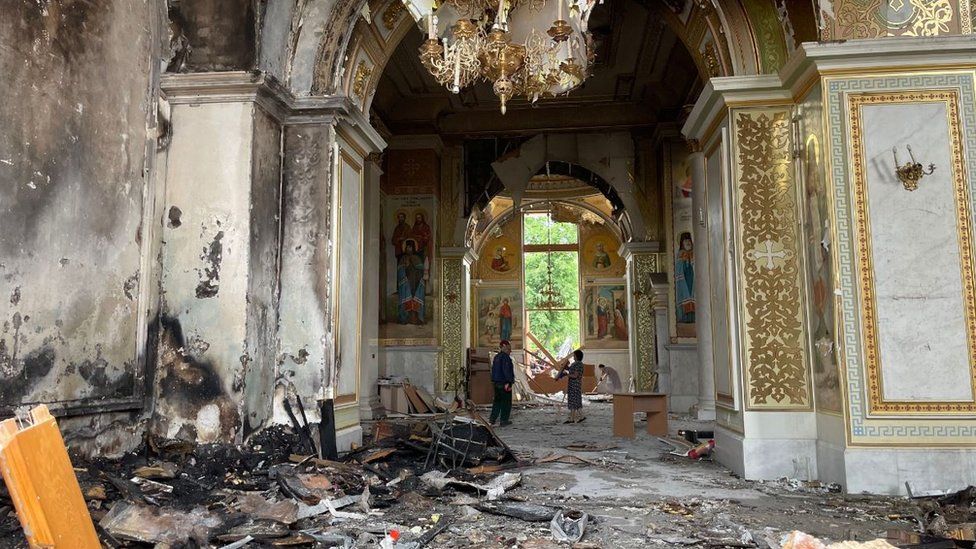
The Kremlin had earlier agreed not to target port infrastructure in three locations in the region, but that diplomatic shield is no more.
With damaged ports, no agreed corridor through the Black Sea and Russia controlling most of the coastline, Mr Osypov believes Ukraine’s grain export capacity will drop by a further 50%.
“It’s a huge challenge for our farmers because they’ll have to sell their products 20% below cost,” says Mr Osypov, who predicts there will be fewer people in the future working less land.
The death of the grain deal extends well beyond Odesa’s ports. The city’s mayor Gennady Trukhanov thinks Moscow just wants to show nothing will be exported without them, and he’s right.
“The most terrible thing is that in order to achieve their goal, they’ve attacked innocent people,” he says.

You’re left in little doubt over the scale of Ukrainian grain production when standing 40 metres high on top of a silo in the central Poltava region.
The plant we’re in can hold 120,000 tonnes. It’s around a third full, and while Ukraine is unable to export through the Black Sea, it will keep filling up.
The site is surrounded by an endless agricultural expanse.
This is a country which can’t suddenly stop producing grain. It has to go somewhere – or at least that’s the hope.
“We feel there is a need for us to harvest as much grain as possible,” says Yulia, a lab technician at Kernel, as she pours samples into a pipe.
Before the birth of the grain deal, tens of millions of people from some of the world’s poorest countries were at risk of starvation because of Ukraine’s inability to export it.
Twelve months later, that risk has returned.
“The Russians probably don’t understand what hunger is,” says Yulia. “People are starving, there’s a large supply, but they can’t get it for no reason.”
July 22nd 2023
Cluster bombs: Ukraine using munitions ‘effectively’, says US
Related Topics
The White House has confirmed that Ukraine is using US cluster munitions against Russian forces in the country.
National Security Spokesman John Kirby said initial feedback suggested they were being used “effectively” on Russian defensive positions and operations.
The munitions scatter multiple bomblets and are banned by more than 100 states due to their threat to civilians.
The US agreed to supply them to boost Ukrainian ammunition supplies.
Ukraine has promised the munitions will only be used to dislodge concentrations of Russian enemy soldiers.
“They are using them appropriately,” Mr Kirby said. “They’re using them effectively and they are actually having an impact on Russia’s defensive formations and Russia’s defensive manoeuvring. I think I can leave it at that.”
The US decided to send cluster bombs after Ukraine warned that it was running out of ammunition during its summer counter-offensive, which has been slower and more costly than many had hoped.
President Joe Biden called the decision “very difficult”, while its allies the UK, Canada, New Zealand and Spain opposed their use.
The vast majority sent are artillery shells with a lower than 2.35% “dud rate”, a reference to the percentage of bomblets which do not explode immediately and can remain a threat for years.
The weapons are effective when used against troops in trenches and fortified positions, as they render large areas too dangerous to move around in until cleared.
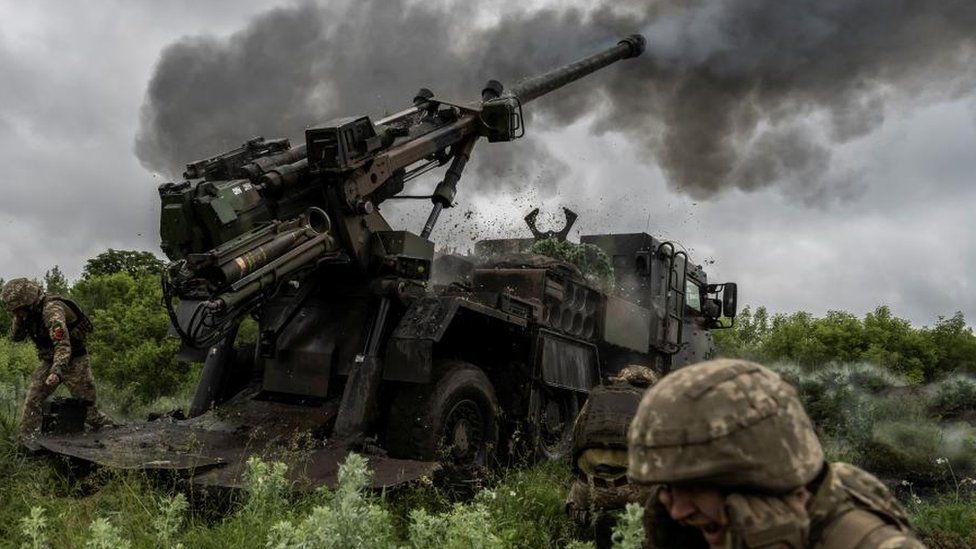
Russia has used similar cluster munitions in Ukraine since it launched its full-scale invasion last year, including in civilian areas.
Reacting to the US decision to send the weapons, Russian President Vladimir Putin said his country had similar stockpiles and they would be used “if they are used against us”.
Oleksandr Syrskyi, the Ukrainian general in charge of operations in the country’s east, told the BBC last week that his forces needed the weapons to “inflict maximum damage on enemy infantry”.
- No fast results in offensive, warns Ukrainian commander
- Why is US giving Ukraine ‘abhorrent’ weapons?
“We’d like to get very fast results, but in reality it’s practically impossible. The more infantry who die here, the more their relatives back in Russia will ask their government ‘why?'”
He added however that cluster munitions would not “solve all our problems”.
He also acknowledged that their use was controversial, but added: “If the Russians didn’t use them, perhaps conscience would not allow us to do it too.”
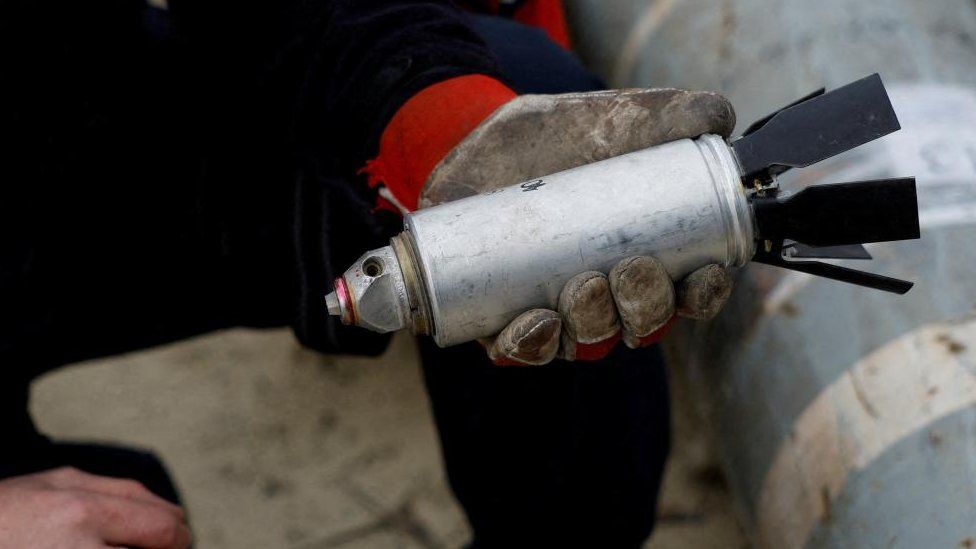
Related Topics
U.S Elite Runs Western Style Democracy & World War III – Headline By R J Cook.
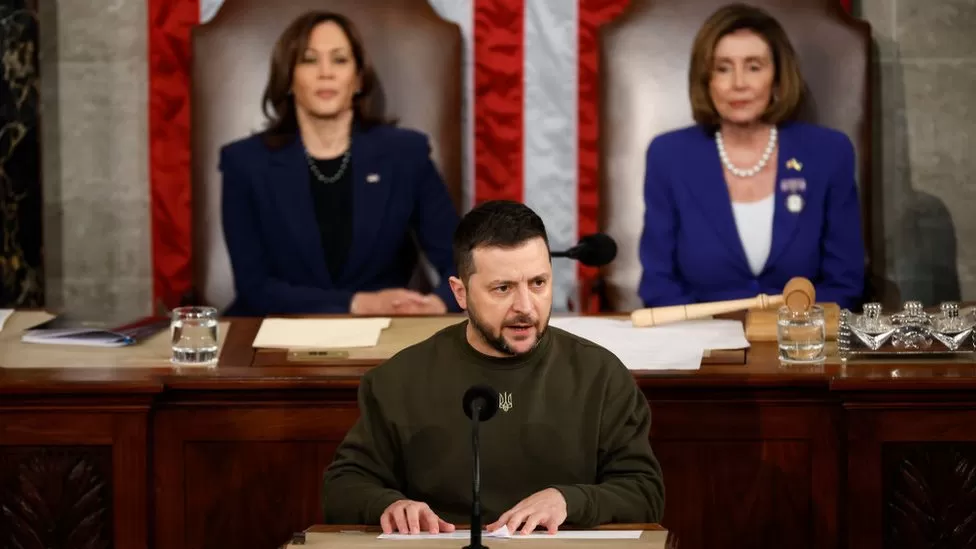
By Gordon Corera
Security correspondent, BBC News
The rarefied setting of Aspen, Colorado, with its mountain views and manicured lawns, is a world away from the minefields and trenches of Ukraine’s front-line, but for a few days this past week the two places were connected.
Every year, the Aspen Security Forum plays host to the influential elite who shape America’s relationship with the wider world.
And this time, upper-most in the minds of policymakers and think-tankers were questions about the progress of the war in Ukraine.
President Volodymyr Zelensky even made an appearance – showing up remotely on a vast screen in the auditorium – to express thanks and ask for more help, an acknowledgement that this is a critical period in which much seems to lie in the balance.
And arriving in Aspen off the back of three weeks in Ukraine, I found a nervousness not far beneath the surface about not just the pace of Ukraine’s current counter-offensive but also about America’s long-term commitment.
Ukraine is a month into its counter-offensive and it is clear that it’s proving, as one speaker put it, a “hard slog” with often just a few metres of ground taken each day.
The first question to President Zelensky was why things were going slower than expected. He patiently explained that the launch of the counter-offensive had been delayed because of a lack of weapons, ammunition and training and that this had given Russia a chance to lay more mines and improve its defences.
But, he said to reassure those that might be growing worried, the moment when actions would “gain pace” was approaching.

Ukraine relies on US military aid – and you can glimpse tension over what has been given and when.
Where President Zelensky in Aspen renewed his call for more, US National Security Adviser Jake Sullivan barely an hour or two later said that US military advisers do not believe F-16 fighter jets would play a significant role in current operations.
Other Americans who have been closely involved in the weapons supply also privately say that Ukraine has what it needs for the current counter-offensive and re-arming them again to the same extent in the future may not be so easy. For that reason the next period on the battlefield will be pivotal.
The war may look slow but it is not a stalemate – or at least not yet.
Ukraine is still probing to find a weakness in Russia’s defences so it can then apply the forces it has held in reserve in the hope of making a significant breakthrough.
If that works, then Ukraine could be in a strong position. But if they cannot break through, then talk of a stalemate may be more accurate and lead to difficult conversations.
And war is a battle of wills and of staying power as well as of weapons and ammunition.
At Aspen and in Kyiv, intelligence officials and diplomats are keen to draw attention to signs that the pressure is beginning to tell within Russia.
That was most evident in Wagner boss Yevgeny Prigozhin’s mutiny a month ago with his complaints about the failures of Moscow’s military leadership. Other generals have been sacked amid reports of low morale and frustrations among Russian troops and their commanders.
- Putin may still seek revenge on Wagner boss – CIA chief
- What is Russia’s Wagner group, and where are its fighters?
Both Ukrainian and American officials are keen to highlight those fissures and suggest they may deepen.
In Ukraine, there is a clear sense of determination from a population that has suffered and that wants to regain the territory that Russia has taken. No one appears in the mood to talk about negotiations or compromise.
Still, there are hints of cracks in Western support.
Members of the US Congress spoke openly at Aspen of how their constituents could not place Ukraine on a map and questioned the scale of the financial commitment.
Seventy Republicans in Congress had voted to end future assistance to Ukraine a week earlier – more than many expected. In the Republican primary to pick a presidential candidate, saying money should be spent in the US and not abroad makes for an easy applause line.
The looming shadow of Donald Trump also hung over Aspen with questions about what his possible re-election would mean not just for Ukraine but for America’s position in the world and relationship with its allies.
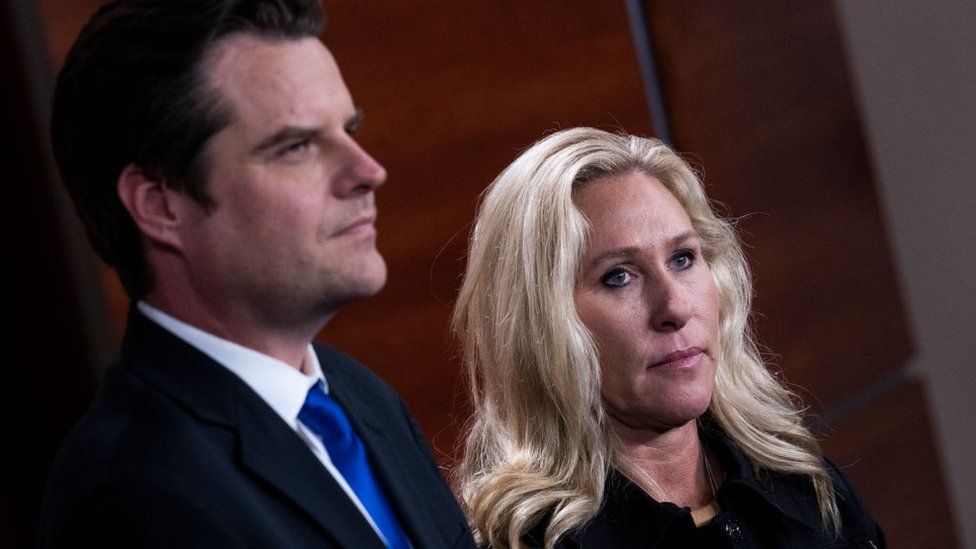
America’s allies are aware – and privately express their concerns – about the risks of support for Ukraine eroding, especially as the US heads into an election next year.
UK defence secretary Ben Wallace caused a stir at the Nato summit when he talked of Ukraine’s need to show more gratitude.
What he seemed to mean was that Ukraine needed to be more mindful of the debates in Washington DC, especially after President Zelensky’s tweet criticising the lack of a clear path to Nato membership.
The UK’s foreign secretary, James Cleverly, travelled to Aspen to make his case.
“We must not allow ourselves to be seduced by the Russian propaganda that this is somehow a stalemate,” he told the audience.
His message was that the US needs to be less defensive about its support for Ukraine and to do more to make that case, including to its own public.
All of that suggests that there is an understanding in both Ukraine and amongst the Aspen elite that the next few weeks and months will be pivotal.
They are likely to determine whether Ukraine can break through militarily, whether cracks in Russia deepen and whether Western – and particularly American – support holds up.
Related Topics
July 20th 2023
Russia Responds Having Linked U.K To Wagner Conspiracy –
By R J Cook
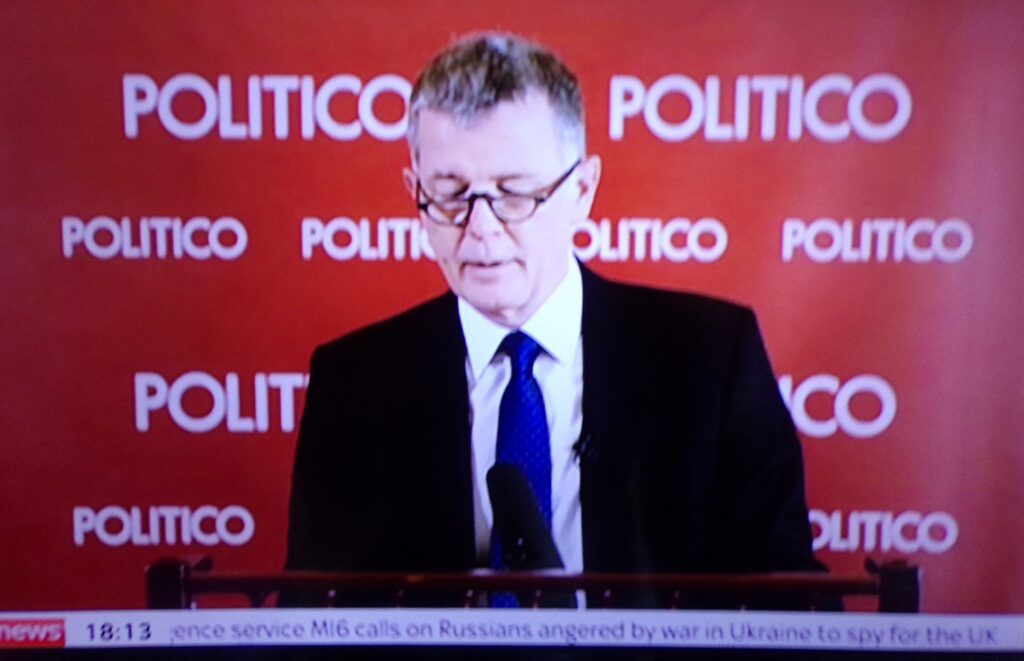
News that British Diplomats are facing the same restrictions on movements as their U.S counterparts comes as no surprise to me. It surprises me that both country’s diplomats were not booted out at the start of the conflict. Vladimir Putin’s government seems to be in denial about being at war with those key NATO countries that would like to bury him alive. Sir Richard Moore , head of the Secret Intelligence Service ( aka MI6 ) used the media yesterday appealing for ‘disillusioned Russians’ to become spies for the U.K and NATO. Vladimir Putin has linked the Wagner mutiny and Kerch Bridge War Crime.
Britain led the charge for NATO’s proxy war on Russia. They have been actively working for Russian regime change since Liddell- Hart planned the shooting of Russian Revoltion mastermind Lenin. Britain has been an elitist class divided unjust country since the Norman invasion in 1066.
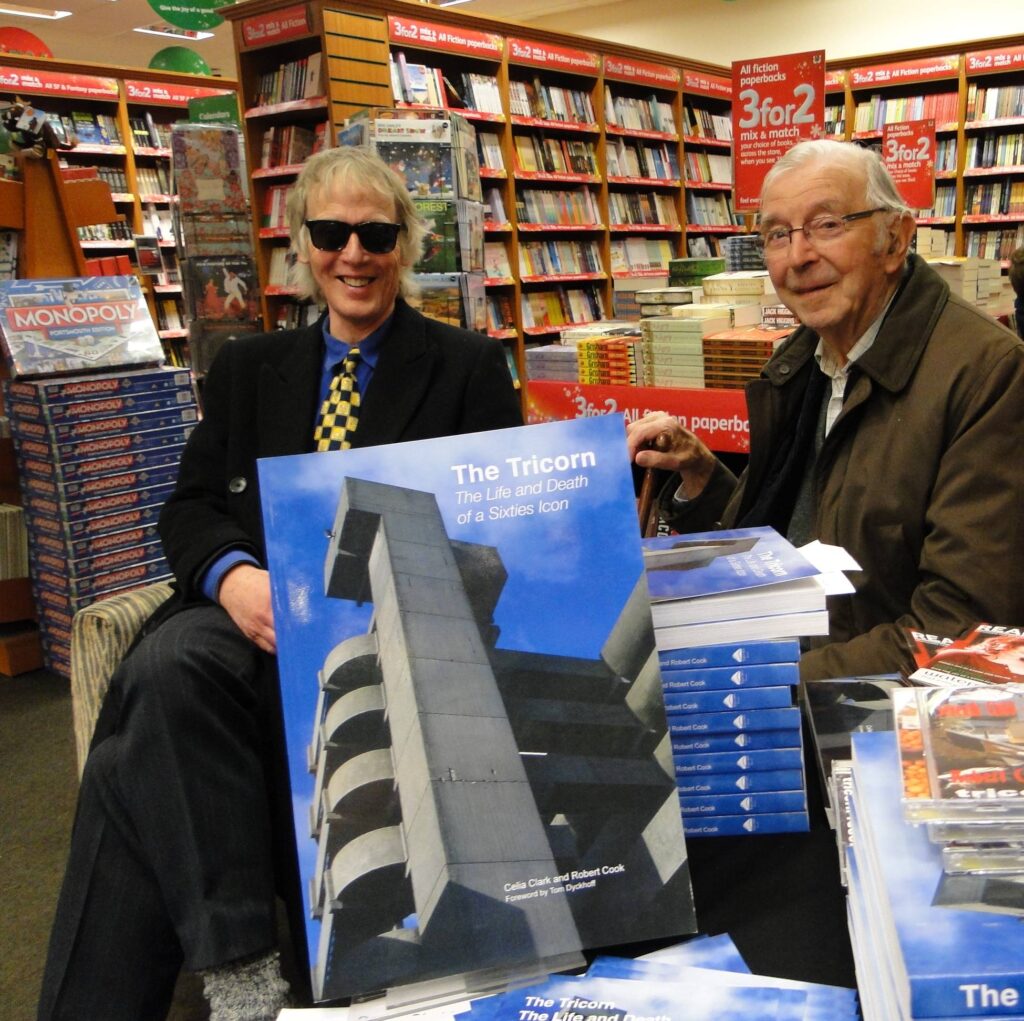
R J Cook
July 19th 2023
Long-Range Missiles? Special Op? Regardless, Crimean Air Base Blasts Are A ‘Real Quandary’ For Russia
The Russian Defense Ministry said in a statement at the time that the detonation of aviation ammunition caused the explosions, without clarifying who or what triggered the detonation.
Ukrainian officials have avoided publicly claiming responsibility, but unidentified Ukrainian officials have told U.S. media that their armed forces were responsible for the explosions, and analysts said satellite imagery pointed to a likely attack by Ukrainian forces.
The article hailed as “successful” the efforts of the Ukrainian armed forces in recent weeks to “physically transfer fighting” to the territory of Crimea, which Russia illegally annexed in 2014 and has used to stage attacks on Ukraine.
Live Briefing: Russia’s Invasion Of Ukraine
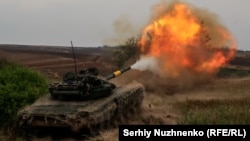
RFE/RL’s Live Briefing gives you all of the latest developments on Russia’s full-scale invasion, Kyiv’s counteroffensive, Western military aid, global reaction, and the plight of civilians. For all of RFE/RL’s coverage of the war in Ukraine, click here.
“We are talking about a series of successful missile strikes on the enemy’s Crimean air bases, first of all, on the Saky airfield,” Zaluzhniy and Zabrodskiy said in the article.
They added that the task of the Ukrainian military in 2023 “is to make these feelings sharper, more natural, and quite tangible for the Russians and in other occupied territories.”
Zaluzhniy and Zabrodskiy said that Russian officials and the population were willing to support the war in part because it is a “distant” conflict that doesn’t threaten their lives.
The attack on Crimea was a prime example, they said.
“Thanks to this distance, Russian citizens don’t really painfully grasp the losses, failures, and most importantly, the cost of this war in all its understandings,” they said.
The authors added that Ukraine didn’t so much need quantity as quality weapons from Western allies. If the West would supply weapons with longer ranges, then Ukraine could bring the impact of the war closer to Russia, they said.
The United States has supplied Kyiv with sophisticated long-range missile systems on the condition that Ukraine not use them to hit targets inside Russia.
With reporting by AFP, Reuters, and dpa
Comment Those of us who know history rather than the polemical drivel pumped out in the west, know that Crimea is Russian territory. Russia needs to take this very seriously. U.S satellites told Ukraine where to aim. Anglo U.S led Nato are at war with Russia. I know that NATO set up this war which is all about elite power and regime change. Would be Churchill Big Boris led the charge with would be warrior Ben Wallace for war over Crimea and shutting down Nordstream 2. The latest idiocy over gas for Europe is imports from Argentina. As I keep writing, this war is about the global rich in an age when there has never been so much money in so few corrupt greedy hands. They call this western style democracy. The Russians quite reasonably don’t like this excuse for civilisation. If the wealthy fake white liberal lefties want mass immigration into Europe and the U.S, then these rich posers need to accept global socialism instead of this ‘make it up as you go along’ crisis management with ever more bullying spying police ,laws and state manufactured fear to keep the population down.

R J Cook
July18th 2023
A Bridge Too Far by R J Cook
Russia blames Britain for orchestrating Kyiv’s admitted terrorist attack on Kerch Bridge connecting a highway to the Crimean Peninsula. Three Ukrainian media outlets quoted unnamed sources as saying Ukraine’s domestic security agency and navy were behind Monday’s incident on the Crimean Bridge, adding that they had used sea-borne drones to attack it. Some voices in Russia are calling for a revenge attack on Tower Bridge
Russia’s Investigative Committee said Kyiv was behind the “attack” and opened a terrorism case, Ukraine has not officially confirmed nor denied involvement and its military has suggested Moscow could be responsible.
Kerch Bridge is a major supply artery for Russian troops fighting in Ukraine and was previously bombed in October. Logically Russia will have to retaliate with major force if they are not to lose ground in NATO’s proxy war where these hypocrites claim the moral high ground their elite media pumping out slick , smooth and condescending propaganda to their masses who just cannot connect this jingoistic war as the real reason interest rates and the so called cost of living crisis created to pay for it.
A 14-year-old girl, Angelina, was seriously injured after multiple reports of explosions on the bridge, while her parents, Alexei and Nataliya, both died.
It came as Russia said it will suspend the pact that has allowed the safe Black Sea export of grain from Ukraine later today. Russia said exports can resume as soon as they are allowed to resume fertiliser exports vital to world food production. Greedy Power Mad Anglo U.S NATO and EU fat cat megalomaniacs would see all us lower orders starve to death or perish in a nuclear mushroom cloud first. This latest display of Ukraine and NATO arrogance may be a bridge too far.
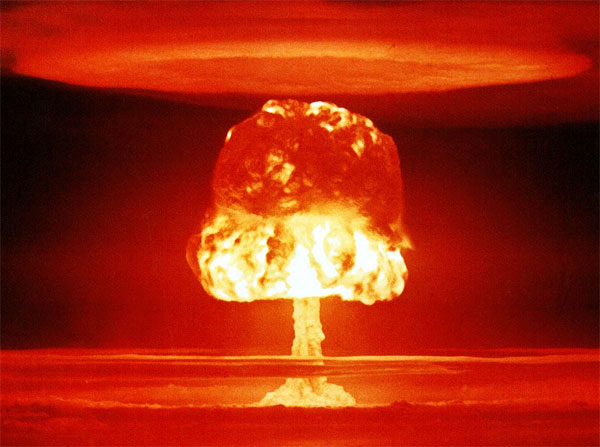
R J Cook – July 17th 2023.
‘Illegal structures’ are ‘necessarily short lived’ – Zelensky’s aide
Ukrainian President Volodymyr Zelensky’s aide Mykhailo Podolyak appears to have made a thinly-veiled reference to the Kerch bridge on social media
.
“Any illegal structures used to deliver Russian instruments of mass murder are necessarily short-lived – regardless of the reasons for the destruction,” he posted on Twitter after the incident at the bridge.
Comment We are all temporary structures Zelensky, even you. Eighty per cent of Ukrainians have lost loved ones to this carnage in the ludicrous names of freedom and democracy. The money power grabbing regime are moving on to the 18 and 19 year old male population. It’s interesting in this age of so called gender / sexual equality that only males were forced to remain in the country to face consciption in this vile NATO provoked proxy war against Russia. NATO boss Jens Stoltenberg has been head hunted for Norway’s National Bank and Zelensky has reached billionaire status. War profiteering is rampant across Europe. Eastern Europe is being depopulated. Ukrainian female refugees in the U.K are demanding leave to remain as citizens. The Western ruling elite see a great opportunity to move in an ever growing African and Asian Muslims overpopulation. They had a big plan ready in the run up to this war.

R J Cook 1955
From The BBC – Britain’s State Broadcaster
Last October’s devastating explosion on the bridge came as Ukraine was pressuring Russian forces to abandon the city of Kherson.
https://www.bbc.co.uk/news/live/world-europe-66219127
Now Kyiv wants to make life as difficult as possible for Russian forces occupying areas south of the Dnipro River.
Logistics hubs across the south have been repeatedly hit using long range weapons supplied by Ukraine’s western backers.
If, as seems likely, Kyiv was behind this latest attack on the Kerch Bridge, it should be seen in the context of Ukraine’s wider effort to liberate areas of the south occupied during last year’s full-scale Russian invasion.
Beyond that, Moscow knows that Kyiv would dearly love to take back the Crimean peninsula, invaded and annexed by Russia in 2014.
For Ukrainians, the Kerch bridge, inaugurated by Russia’s President Vladimir Putin in 2018 amid great fanfare, is a hated symbol of Russian occupation.
Last October’s explosion, which briefly crippled its road and rail lines, was greeted with euphoria across Ukraine.
Summary
- Two people have died in an attack on the bridge linking the occupied Crimean peninsula to Russia
- Explosions were reported – the Russian-installed head of Crimea’s parliament blames Ukraine’s “terrorist regime”
- A source in Ukraine’s security service tells BBC Russian it was behind the attack, and that surface drones were used
- The road section of the bridge is closed but trains are running on the railway section
- The bridge was opened in 2018 and enables road and rail travel between Russia and Crimea
- In October last year, it was partially closed following a major explosion, before fully reopening in February
- Meanwhile, Ukraine claims it has retaken 210 square km (81 square miles) of territory since its counter-offensive began
July 15th 2023
Biden nibbles on frightened young girl during trip to Finland, weirding out Twitter users
Video footage shows little girl squirming to avoid kiss from Biden
President Biden appeared to nibble at the shoulder of a startled little girl during his departure from Helsinki on Thursday.
A video of the incident, which took place as the president greeted embassy staff members and their families before he boarded Air Force One at Helsinki-Vantaan International Airport, shows Biden leaning into a young girl and placing his mouth on her shoulder as he nibbled lightly.
The little girl — who appeared frightened during the experience — later turned her head when Biden, who will turn 81 in November, tried to give her a peck on the head.
Footage from the incident quickly made the rounds on social media, where several users blasted the president for his peculiar conduct.
WATCH:
“This has got to be Biden’s creepiest moment yet with a child,” Caleb Hull, a conservative operative, said of the footage. “All Biden has to do is not do this and he can’t,” he added in a separate tweet.
Republican operative Greg Price joked that Biden is “now confusing babies with ice cream cones.”
Responding to the footage in a tweet, Donald Trump Jr. wrote, “Biden should be in a nursing home, not leading the free world.”
“Biden is creepy AF. Why would anyone put their mouth on another person’s child like this? This is peak, disgusting pedo behavior,” political comedian Tim Young noted in a tweet.
“Keep your kids away from Joe Biden. Gross,” Young added in a video about the incident.
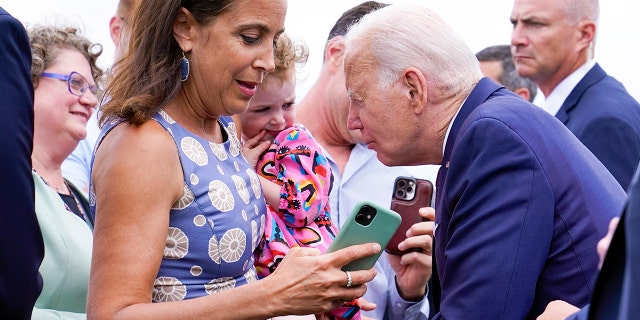
President Biden talks to a child before boarding Air Force One at Helsinki-Vantaan International Airport in Helsinki on Thursday. (AP Photo/Susan Walsh)
“Biden pretended to bite the back of this little girl today in Finland,” another person wrote in a tweet. “She was, clearly, scared and not amused.”
The eyebrow-raising behavior from the president came as he concluded a five-day trip to Europe, where he participated in a Lithuanian summit to shore up support for Ukraine amid its war with Russia and showcase Finland’s NATO membership.
BIDEN TANGLES WITH REPORTER WHO QUESTIONS US COMMITMENT TO NATO: ‘NO ONE CAN GUARANTEE THE FUTURE’

President Biden addresses a joint press conference with Finland’s president after the U.S.-Nordic leaders summit in Helsinki on Thursday. (ALESSANDRO RAMPAZZO/AFP via Getty Images)
During the trip, Biden committed multiple speaking gaffes, which included confusing Russia and Ukraine, as well as their leaders.
While speaking to the NATO summit in Vilnius, Lithuania on Wednesday, Biden referred to Ukrainian President Volodymyr Zelenskyy as “Vladmir,” seemingly confusing Zelenskyy with Russian President Vladimir Putin.
Appearing to not realize his mistake, Biden went on to say he “shouldn’t be so familiar,” and referred to Zelenskyy as “Mr. Zelenskyy.”
Putin and Zelenskyy each hold a different version of the same name, with “Volodymyr” being the most commonly used version in Ukraine.
At a later speaking event following the summit, Biden confused the two nations, referring to Ukraine as Russia.
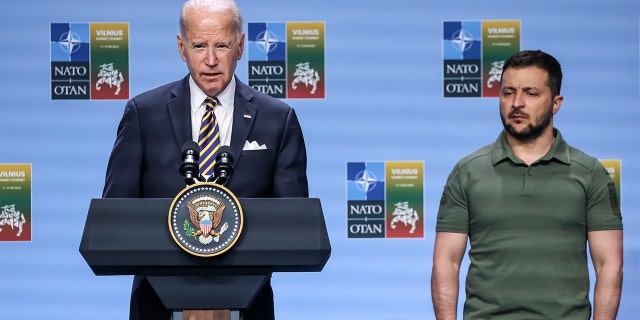
President Biden gives his remarks as Ukrainian President Volodomyr Zelensky stands on the side during G7 Declaration of Joint Support for Ukraine during the high level NATO summit at Litexpo Conference Centre in Vilnius, Lithuania, on Wednesday. (Dominika Zarzycka/NurPhoto via Getty Images)
“Russia could end this war tomorrow by withdrawing its forces from Ukraine and recognizing its international borders and ceasing its attacks — its inhumane attacks — on Russia – I mean by Russia on Ukraine,” Biden said, correcting himself.
President Biden appeared to nibble at the shoulder of a startled little girl during his departure from Helsinki on Thursday.
A video of the incident, which took place as the president greeted embassy staff members and their families before he boarded Air Force One at Helsinki-Vantaan International Airport, shows Biden leaning into a young girl and placing his mouth on her shoulder as he nibbled lightly.
The little girl — who appeared frightened during the experience — later turned her head when Biden, who will turn 81 in November, tried to give her a peck on the head.
Footage from the incident quickly made the rounds on social media, where several users blasted the president for his peculiar conduct.
WATCH:
“This has got to be Biden’s creepiest moment yet with a child,” Caleb Hull, a conservative operative, said of the footage. “All Biden has to do is not do this and he can’t,” he added in a separate tweet.
Republican operative Greg Price joked that Biden is “now confusing babies with ice cream cones.”
Responding to the footage in a tweet, Donald Trump Jr. wrote, “Biden should be in a nursing home, not leading the free world.”
“Biden is creepy AF. Why would anyone put their mouth on another person’s child like this? This is peak, disgusting pedo behavior,” political comedian Tim Young noted in a tweet.
“Keep your kids away from Joe Biden. Gross,” Young added in a video about the incident.

President Biden talks to a child before boarding Air Force One at Helsinki-Vantaan International Airport in Helsinki on Thursday. (AP Photo/Susan Walsh)
“Biden pretended to bite the back of this little girl today in Finland,” another person wrote in a tweet. “She was, clearly, scared and not amused.”
The eyebrow-raising behavior from the president came as he concluded a five-day trip to Europe, where he participated in a Lithuanian summit to shore up support for Ukraine amid its war with Russia and showcase Finland’s NATO membership.
BIDEN TANGLES WITH REPORTER WHO QUESTIONS US COMMITMENT TO NATO: ‘NO ONE CAN GUARANTEE THE FUTURE’

President Biden addresses a joint press conference with Finland’s president after the U.S.-Nordic leaders summit in Helsinki on Thursday. (ALESSANDRO RAMPAZZO/AFP via Getty Images)
During the trip, Biden committed multiple speaking gaffes, which included confusing Russia and Ukraine, as well as their leaders.
While speaking to the NATO summit in Vilnius, Lithuania on Wednesday, Biden referred to Ukrainian President Volodymyr Zelenskyy as “Vladmir,” seemingly confusing Zelenskyy with Russian President Vladimir Putin.
Appearing to not realize his mistake, Biden went on to say he “shouldn’t be so familiar,” and referred to Zelenskyy as “Mr. Zelenskyy.”
Putin and Zelenskyy each hold a different version of the same name, with “Volodymyr” being the most commonly used version in Ukraine.
At a later speaking event following the summit, Biden confused the two nations, referring to Ukraine as Russia.

President Biden gives his remarks as Ukrainian President Volodomyr Zelensky stands on the side during G7 Declaration of Joint Support for Ukraine during the high level NATO summit at Litexpo Conference Centre in Vilnius, Lithuania, on Wednesday. (Dominika Zarzycka/NurPhoto via Getty Images)
“Russia could end this war tomorrow by withdrawing its forces from Ukraine and recognizing its international borders and ceasing its attacks — its inhumane attacks — on Russia – I mean by Russia on Ukraine,” Biden said, correcting himself.
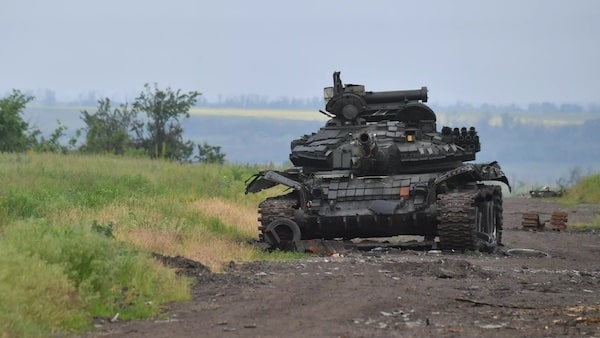
Ukrainian counteroffensive’s second week ends in failure
By Scott Ritter (Posted Jun 19, 2023)
Originally published: Internationalist 360° on June 17, 2023 (more by Internationalist 360°)
State Repression, Strategy, WarEurope, Russia, UkraineNewswireNorth Atlantic Treaty Organization (NATO), Russia-Ukraine War
Operation enters the second week of Ukraine’s long-awaited and highly touted counteroffensive, some basic conclusions can be drawn even though the fighting continues, and will continue to rage, for some time to come.
First and foremost, the counteroffensive gambit has failed. While there is still considerable combat strength left in the Ukrainian military, including more than 75% of the NATO-trained and -equipped 60,000-strong cohort Ukraine had assembled in the past eight months, fundamentally flawed assumptions about the quality of the force on which Ukraine and its NATO allies had placed their collective hopes for victory over Russia have been exposed. In short, Ukraine lacks the military capacity to overcome Russian defenses.
Ukraine’s most elite assault brigades, equipped with the latest Western military technology, failed to advance out of what Russian defensive doctrine calls the “cover” line of defense—the buffer that is designed to channel and disrupt an attacking force prior to reaching the “main” line of defense.
Ukrainian casualties were extremely heavy, with Russia achieving a 10:1 kill ratio in terms of manpower, which is unsustainable from the Ukrainian perspective. The reasons for the Ukrainian failure are fundamental in nature, meaning that they cannot be overcome as things currently stand and, as such, the Ukrainian military has zero chance of success, no matter how hard they press subsequent attacks.
First and foremost is the quality of the Russian defenses, especially in terms of the barrier network (minefields, obstacles, and trenches) which, when combined with the tenacity of the Russian defender and the overwhelming superiority Russia enjoys in terms of fire support (both artillery and air-delivered), is the reason the Ukrainians are unable to advance beyond the “cover” layer of the Russian defenses. Ukrainian equipment and tactics are insufficient to the task of breaching the Russian obstacle barriers in any meaningful manner, dooming the attacking forces to be destroyed piecemeal by Russian artillery and air strikes, as well as local counterattacks mounted by Russian special forces.
Besides the poor tactics and equipment deficiencies (yes, the Leopard tanks and Bradley fighting vehicles were not the miracle weapons Ukraine and its Western supporters had hyped them up to be), the Ukrainians are paying the price for Russia’s impressive suppression of enemy air defense (SEAD) campaign that has been ongoing for many weeks now. Russia has not only neutralized Ukraine’s ability to defend strategic targets far beyond the front lines, but also to project any meaningful air defense capability into the actual zone of conflict. This, combined with the lack of any viable air force, leaves the attacking Ukrainian ground forces exposed to the full weight of Russian air power.
Russian fixed-wing aircraft have been able to deliver precision-guided munitions with deadly effect to the assembly areas used by Ukraine to gather their attacking forces prior to committing them to the battlefield. It is estimated that between 25-30% of Ukraine’s casualties occur from these strikes. Russian helicopters can use their anti-tank guided missiles (ATGMs) with lethal effect on Ukrainian forces operating in the zone of contact, and Russian loitering munitions (i.e., “kamikaze drones”) have taken a heavy toll of Ukrainian forces as well. Unless Ukraine can reassert some semblance of air defense onto the battlefield, both in the rear areas as well as the frontlines, and sortie its own air power capable of challenging Russian air superiority over the battlefield, then no amount of courage and tactical innovation on the part of the Ukrainian ground forces will alter the deadly calculus of war that currently prevails today.
One of the many tragedies of the ongoing Ukrainian-Russian conflict is the fact that much of what Ukraine does on the battlefield is dictated not by military necessity, but rather political imperative. The recently concluded months-long Battle for Artemovsk (Bakhmut) is a case in point, where Ukrainian President Zelensky insisted on pouring manpower and equipment into a battle for a town that most military experts believed to hold minimal strategic military value. The geography, however, did not dictate the scope and scale of the battle, but rather the perception of Ukrainian defensive tenacity, and as a result between 60-75.000 Ukrainian soldiers lost their lives in what was a losing effort.
Similarly, the Ukrainian army is being asked to make what amounts to a suicide attack against well-prepared Russian defenses under conditions which, as detailed earlier, can only result in a decisive Ukrainian defeat. This time, the culprit is Ukraine’s NATO allies who, on the eve of their annual summit, are desperate for any sign that the multi-billion-dollar investment they have collectively made in the Ukrainian military can pay even the most rudimentary dividends. For this reason, NATO will continue to pressure Ukraine to double down on defeat, pressing the Russians offensively even though any gains, if in fact any can be had, would be pyrrhic in nature and unsustainable over the long run.
The reality is that when NATO gathers in Vilnius on July 11, the Russians will be well into the process of destroying the third Ukrainian army built by NATO. The first was assembled during the buffer provided by the diplomatic “sham” of the Minsk Accords, from 2015-2022. Some 260,000 strong, this force was largely destroyed by June of 2022. The second army, consisting of some 80,000 newly trained and equipped Ukrainian soldiers backed by thousands of foreign mercenaries, the direct result of tens of billions of dollars of military aid provided by NATO, was able to launch the successful Ukrainian counterattack in the fall of 2022, before being decimated in the positional war that followed (including the Bakhmut slaughter).
The 60,000-strong 12-brigade Ukrainian counterattack force currently operating against the Russians, again the result of tens of billions of dollars in military equipment (including modern Western tanks, artillery, and infantry fighting vehicles), will most probably be destroyed, or facing imminent destruction, by the time the NATO summit convenes. The primary question facing NATO is does it have the political, economic, and military capacity to raise a fourth Ukrainian army, and after its demise, a fifth, sixth, and more?
NATO is politically committed to waging a proxy conflict with Russia “to the last Ukrainian.” This tragic reality means that, regardless of the battlefield reality that exists in Ukraine, NATO will continue to push Ukraine to sacrifice its manpower in a fruitless struggle against Russia for the simple fact that NATO is unwilling to willingly lose political face at home and abroad.
However, this political will does not automatically mean that NATO will be able to sustain this objective either economically or militarily.
While recent statements made by US General Mark Miley, the Chairman of the Joint Chiefs of Staff, indicate that there are tens of thousands of Ukrainian soldiers in the US/NATO training “pipeline”, and that the US/NATO is assembling equipment sufficient to equip these soldiers, they will not be ready for combat for several months yet—long after the third Ukrainian army has met its fate on the field of battle.
Miley spoke of new air defense systems for Ukraine, and other NATO officials speak of the possibility of providing Ukraine with (old) F-16 aircraft. New air defense systems, however, cannot in and of themselves alter a military reality imposed by Russia on Ukraine through its strategic SEAD victory. Ukraine will simply continue a losing struggle against Russian air power. The same holds true of any F-16 fighters that might be provided to Ukraine—too little, too late, and in any event incapable of achieving a meaningful battlefield result.
In Vilnius, NATO will be confronted with the reality of its impotency as a military alliance when it comes to countering Russia in Ukraine. Any military analyst of any competence will know that, as things currently stand, Ukraine simply cannot prevail over Russia. NATO illusions of a “frozen conflict” that seem to drive their insane desire to arm Ukraine to infinity and beyond, moreover, are driven by fundamentally flawed assessments regarding Russian economic competence and capacity, Russian military proficiency, and the will of the Russian people to sustain this conflict.
Here is the root cause of NATO’s strategic failure in Ukraine—a complete lack of understanding about the reality of Russia today. Russia will be able to out-produce NATO from a standpoint of military technology until which time NATO nations fully transition into a wartime economy, something NATO nations neither have the political will nor economic means to accomplish.
The Russian military has largely overcome the deficiencies which plagued it in the initial phases of the Special Military Operation, and the Russia armed forces assemble in the Special Military Operation zone are highly trained, well-equipped, and properly trained for the tasks they have been assigned. Moreover, the Russian nation has rallied around the leadership of Russian President Vladimir Putin in an overwhelming fashion, united in the belief that the proxy war NATO is waging against Russia in Ukraine is existential in nature and, as such, one that Russia cannot lose.
NATO will not alter course in the immediate period following the Vilnius summit—there is simply too much political momentum in place to bring about any meaningful alteration of the current trajectory in Ukraine. But neither will NATO produce a winning formula in Ukraine. Rather, NATO will continue to pursue little more than a variation of an existing theme—to arm Ukraine so that it can fight as long as it is capable of sustaining the fight.
This short-sighted posture will result in the inevitable military collapse of Ukraine, probably sometime between late summer/early fall of this year. When this happens, NATO will be left scrambling to construct some sort of face-saving mechanism to salvage its weakened geopolitical position vis-à-vis Russia. What that will look like is unknown at this time. But one thing is for certain—because NATO refuses to consider an off-ramp from the Ukrainian conflict today, there will be no future for Ukraine tomorrow. NATO political pride will be the downfall and destruction of the Ukrainian nation, its military, and its people.
Monthly Review does not necessarily adhere to all of the views conveyed in articles republished at MR Online. Our goal is to share a variety of left perspectives that we think our readers will find interesting or useful. —Eds.
About Scott Ritter
Scott Ritter is a former U.S. Marine Corps intelligence officer who served in the former Soviet Union implementing arms control treaties, in the Persian Gulf during Operation Desert Storm and in Iraq overseeing the disarmament of WMD. His most recent book is Disarmament in the Time of Perestroika, published by Clarity Press.
North Atlantic Treaty Organization (NATO)Russia-Ukraine War
Trump charges: why ‘unprecedented’?
Also by Scott Ritter
- Ukrainian counteroffensive’s second week ends in failure by Scott Ritter June 19, 2023
- Why Britain’s Uranium ammo decision a big deal by Scott Ritter March 27, 2023
- A Lexicon for disaster by Scott Ritter December 21, 2022
- Merkel reveals West’s duplicity by Scott Ritter December 07, 2022
Monthly Review Essays
- Ruy Mauro Marini’s Contribution to the Political Economy of ImperialismTorkil LauesenIn “The Dialectics of Dependency,” Ruy Mauro Marini developed a theory of dependency and unequal exchange that is still invaluable today.
Lost & Found
- The Political Tragedy of Capitalist RuleHarry MagdoffSociety is made up of parts that work together, sometimes more and sometimes less successfully, to produce its livelihood and reproduce itself.
July 14th 2023
G7 to announce long-term Ukraine security package at Nato summit
Related Topics

By James Landale & Oliver Slow
BBC News, Vilnius and London
G7 members are expected to ratify a wide-ranging security pact with Ukraine at the Nato summit on Wednesday.
But they stopped short of providing a timeframe for Kyiv to join the security alliance, provoking the anger of President Volodymyr Zelensky.
The security arrangement will include defence equipment, training and intelligence sharing.
And UK Prime Minister Rishi Sunak said it would send a “strong signal” to Russian President Vladimir Putin.
The security arrangement with Ukraine comes after its President Volodymyr Zelensky raged against Nato’s reluctance to offer Kyiv a timeframe for joining the alliance.
G7 leaders will sign the declaration in Vilnius on Wednesday on the side-lines of the second day of a Nato defence summit.
Speaking ahead of a meeting with President Zelensky on Wednesday, Mr Sunak said Kyiv’s allies were ramping up their “formal arrangements to protect Ukraine for the long term”.
“We can never see a repeat of what has happened in Ukraine and this declaration reaffirms our commitment to ensure it is never left vulnerable to the kind of brutality Russia has inflicted on it again,” he said.
British officials said the UK had played a leading role in the agreement involving G7 partners Canada, France, Germany, Italy, Japan and the US. More details are expected on Wednesday.
US President Joe Biden earlier suggested a model for Ukraine similar to his country’s agreement with Israel. Under that deal, Washington has committed to providing $3.8bn (£2.9bn) in military aid per year over a decade.
But unlike Nato membership – this does not include a clause to come to the target nation’s aid during a time of attack.
The G7 announcement comes after Nato said Ukraine could join the military alliance “when allies agree and conditions are met” – a delay Mr Zelensky has called “absurd”.
Kyiv accepts it cannot join Nato while it is at war with Russia but wants to join as soon as possible after fighting ends.
Addressing crowds in the Lithuanian capital on Tuesday, Mr Zelensky said: “Nato will give Ukraine security – Ukraine will make the alliance stronger.”
He also presented a battle flag from the destroyed city of Bakhmut – the site of the longest, and possibly bloodiest, battle in Russia’s invasion of Ukraine.
Mr Zelensky had earlier tweeted that “uncertainty is weakness”, and said the lack of an agreed timeframe meant his country’s eventual membership could become a bargaining chip.
- Ukraine wants more than warm words over joining Nato
- Nato looks for unity over war in Ukraine
- What is Nato and why is Sweden joining?
Nato might not have said when and how Ukraine might join the alliance, but diplomats emphasised that they had set out a clear path to membership, with the onerous application process shortened significantly.
They said they had recognised that Ukraine’s army was increasingly “interoperable” and more “politically integrated” with Nato forces, and promised continue supporting reforms to Ukraine’s democracy and security sector.
Diplomats also highlighted the creation of a new Nato-Ukraine Council, meeting on Wednesday for the first time, which will give Kyiv the right to summon meetings of the whole alliance.
Some member states fear near-automatic membership for Ukraine could give Russia an incentive to both escalate and prolong the war.
In the past, Western security pledges failed to deter two Russian invasions. Nato allies hope a third round will be robust and explicit enough to persuade the Kremlin that further aggression would be too costly.
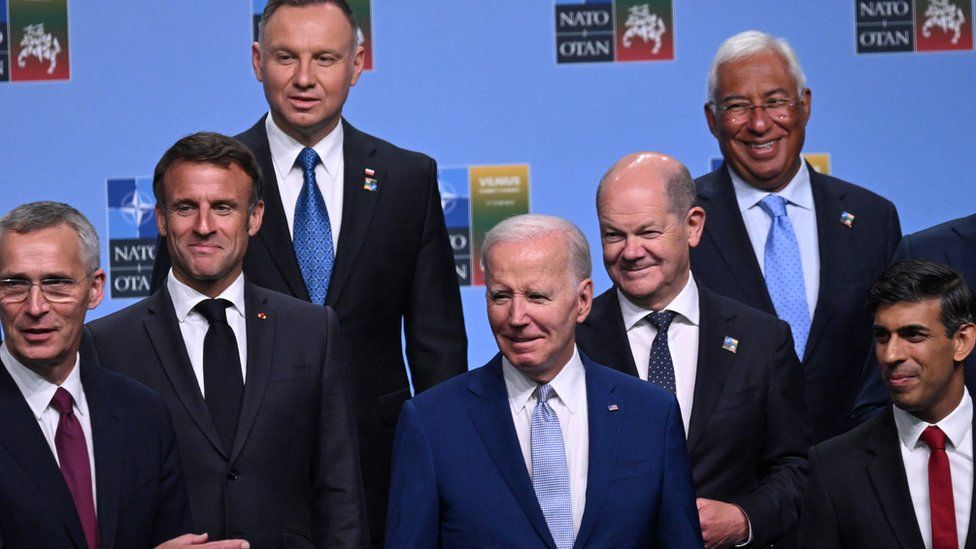
A series of military packages for Ukraine were also announced at the summit on Tuesday.
A coalition of 11 nations will start training Ukrainian pilots to fly US-made F-16 fighter jets at a centre to be set up in Romania in August, officials said.
In May the US gave the go-ahead for its Western allies to supply Ukraine with advanced jets, including the long sought F-16s – a significant upgrade on the Soviet-era planes it is currently using.
Ukraine had repeatedly lobbied its Western allies to provide jets to help with its recently-begun counter-offensive aiming to retake territory seized by Russia.
However experts say the training of Ukrainian pilots to fly and operate Western jets will take some time.
In addition to the G7 security pact, the UK has announced plans to deliver more than 70 combat and logistics vehicles to Ukraine, aimed at boosting its counteroffensive operation.
Comment Anglo U.S led NATO will lead Europe to hell fire before they will ever abate their lust for Ukraine and Russia’s massive respources, along with control of the Baltic and Arctic region. China appears to be asleep as NATO aims to break down their back door. These grotesque hypocrits choose what passes for war crimes. Their rules based western order is NATO’s elite rules basis. If NATO wins this not so proxy war they will double down on Iran and Syria. Trecherous Turkey with their new U.S F16 jet fighters will handle the backstabbing if Erdogan wants his power and privileges to continue.

R.J Cook
Nato membership for Ukraine a key question at Vilnius summit
Related Topics
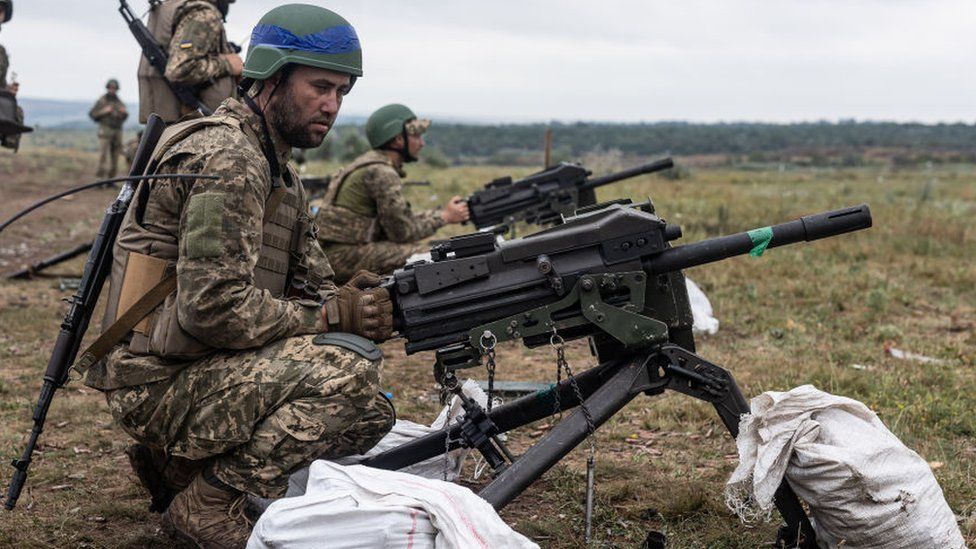
By Gordon Corera
Security correspondent, Kyiv
Out in a dense forest in central Ukraine, troops from a Ukrainian artillery battery are training before heading out to the front lines.
For some it will be a return to the fight, for others it will be their first time – as they replace those who have been injured or killed.
Firing at targets in a clearing with AK-47 rifles, they are careful to conserve ammunition. And it is not just training camps where supplies are low.
“We have enough fighting spirit to win, of course. Unfortunately, we currently do not have enough weapons,” Roman, their commander, tells me. “The main thing is to have enough ammunition.”
Out on the front lines they are having to economise, he explains. “This is not a secret. The amount of ammunition that the enemy uses daily is at least five times higher than the amount of ammunition that we use.”
Supplies from allies have been essential for Ukraine in this war. For Roman and other soldiers, the Nato summit in Vilnius is a crucial moment to ensure they have what they need to continue the fight.
The widespread expectation is that new weapons will be promised at the summit, as well as more supplies of ammunition. The US decision to provide cluster munitions from existing stockpiles last week was partly to act as a stop-gap before new artillery supplies are ready.
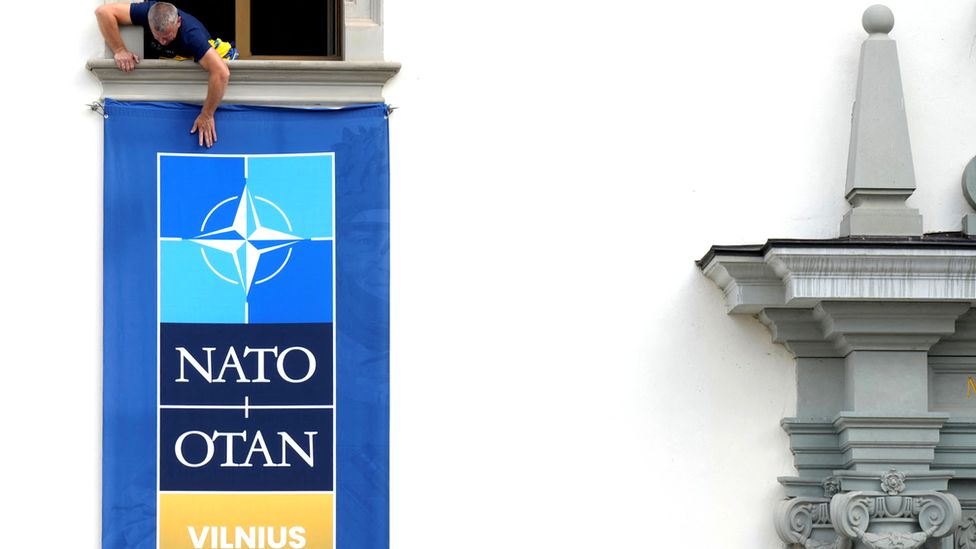
But viewed from Ukraine the summit is about much more than just weapons and ammunition – it is about what type of commitment the country will be offered when it comes to joining the alliance.
Ukraine has been knocking at Nato’s door for years. What it wants is more than just positive noises and a feeling of being left in a permanent waiting room.
At the core of Nato is Article 5, which sets out that an attack on one member is an attack on all. This principle of collective defence could offer protection for Ukraine, but – almost everyone agrees – is very difficult to put in place when a country is already at war.
“We believe that it is long overdue to invite Ukraine to Nato,” Oleg Nikolenko, a spokesperson for Ukraine’s foreign affairs minister, says.
“An invitation to join Nato does not mean an immediate membership in Nato. We are cognizant of the fact that as long as the war goes on, Ukraine won’t be able to join Nato. But we are talking about the invitation and setting the clear timeframe for this to happen.”
The 2008 Nato summit in Bucharest casts a long shadow. Ukraine, along with Georgia, was told membership was on the cards in the future – but with no clear path and no expectation that it would be anytime soon.
That angered Russia but without offering any protection in return. Georgia was attacked in 2008 by Russia, and Ukraine attacked too – first in 2014 and then in 2022. Many of those US officials involved in the decision in Bucharest now acknowledge it was a mistake.
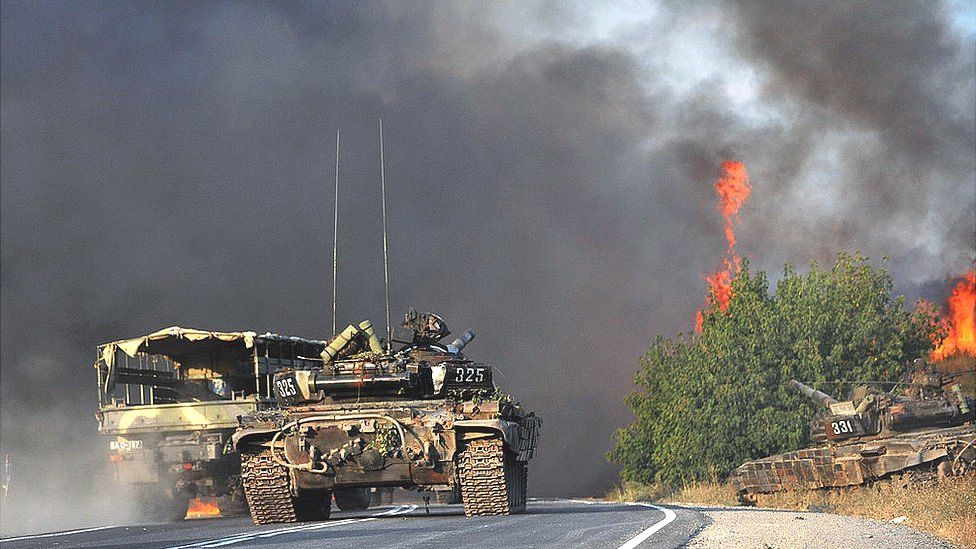
This time Ukraine wants greater clarity and concrete assurances. The exact nature and timetable of any commitment could have real consequences for the war. For instance, offering membership only when the war is over might encourage Russia to maintain a low level conflict to stall membership, some analysts argue.
But there are existing Nato members who are cautious about offering too much to Ukraine now. They fear this could draw Nato closer to war with Russia.
That is a view that is met with some annoyance in Ukraine.
“Let’s be honest: for a long time, Nato has been paying too much attention to whether Russia will allow them to do anything,” Mykhailo Podolyak, an adviser to the office of the President of Ukraine, told me when I visited his heavily guarded office in the centre of the capital.
“Nato must say unequivocally that there are no more preconditions for this related to Russian threats.”
Ukrainians view membership as a way to end the war by deterring Russia rather than escalating it. They acknowledge, as US President Joe Biden has made clear in recent days, that Ukraine needs to make the reforms that any prospective member has to undertake.
But they argue that Nato was set up to confront Moscow in the Cold War and yet it is now Ukraine which is effectively fighting on Nato’s behalf, defending its eastern flank against Russia with its soldiers and civilians dying every day.
BBC
Nato has been paying too much attention to whether Russia will allow them to do anything
Mykhailo Podolyak
Adviser to Ukrainian president
For many in Kyiv, the focus by some inside the alliance on the risks of an invitation are a mistake. What, they ask, are the risks of not acting?
In public, Ukrainian officials are careful to sound optimistic and not to enter into any discussion of the consequences if they receive only vague promises and looser “security guarantees”. They do not want to sound ungrateful for the weapons and ammunition they still need right now.
But privately officials worry that in the long term a failure to bring Ukraine into closer alignment with the West will be used by Moscow to push a narrative within the country that Ukraine has been let down and the West cannot be trusted. People could feel betrayed, one senior official told me.
Without formal membership, the fear is the West could tire of supplying the weapons and ammunition Ukraine needs as the war grinds on. That is something Vladimir Putin and Russia is counting on.
So in Kyiv do they worry about that?
“I have a counter question: what does it mean to be tired of supporting Ukraine?” presidential adviser Mykhailo Podolyak remarks when I put that question to him.
“This means that democracy does not know how to defend itself. And that any authoritarian country, if it has a capacity to fight, will always win.”
Comment Zelensky will get himself and the NATO world much more than warm words at this rate.
R J Cook
July 13th 2023
Будущее яркое. Будущее оранжевое.

So What ? Biden’s Election Pledge To The People. The Future’s Bright. The Future’s Orange.
‘My fellow Americans, I have a dream that most of you are created equally stupid. I do not need to fool all of you people all of the time because you fool yourself. We got rid of Trump the secret Russian by dumping all those votes and punished him for being too sexy. Now we have me and war, and its getting better and bigger revery day. It is going to cost you a lot, maybe your lives. We are the Democrats and this is a democracy so you have no choice. Don’t wory about me and my privileged kind. We have got our massive well stocked well equiped fall out shelters. Our good Democrazy Governance will continue and rule the world.’ President Creepy Joe Biden.
Washington CNN —
Russia has been thwarting US-made mobile rocket systems in Ukraine more frequently in recent months, using electronic jammers to throw off its GPS guided targeting system to cause rockets to miss their targets, multiple people briefed on the matter told CNN.
Ukrainian military officials, with the US’ help, have had to come up with a variety of different workarounds as it continues to use the High Mobility Artillery Rocket System (HIMARS) which has been perhaps the most revered and feared piece of weaponry in Ukraine’s fight.
The medium-range rocket systems were hailed as a game changer in the conflict and have played a key role since the moment they arrived in Ukraine last summer, including in last year’s offensive that allowed Ukraine to take back significant swaths of territory from Russia.
But in recent months, the systems have been rendered increasingly less effective by the Russians’ intensive blocking, five US, British and Ukrainian sources tell CNN, forcing US and Ukrainian officials to find ways to tweak the HIMARS’ software to counter the evolving Russian jamming efforts.

What we know about the murky drone attack on the Kremlin – and the questions that remain
“It is a constant cat-and-mouse game” of finding a countermeasure to the jamming, a Pentagon official said, only to then have the Russians counteract that countermeasure. And it is not clear how sustainable that game is in the long term.
With a major Ukrainian counteroffensive expected to start very soon and Ukraine’s reliance on HIMARS, solutions are even more of a priority so that Ukrainian troops can make significant headway.
“It’s one thing to be able to hold the Russians off where they are right now. It’s another thing to drive them out,” retired US Army Brig. Gen. Steven Anderson told CNN. “They’re dug in, they’ve been there for a year.”
Ukraine needs to keep ‘HIMARS in the game’
HIMARS “have been extremely important,” he added. “They have to be able to keep those HIMARS in the game and keep using them to be able to make effective deep strikes.”
Ukraine has received 18 American HIMARS to date and the US has committed to sending 20 more. Other NATO allies have donated 10 Multiple Launch Rocket Systems, according to the State Department.
The routine announcements from the Biden administration of hundreds of millions of dollars of military aid for Ukraine, including one on Wednesday, regularly include HIMARS munitions, called GMLRs, as a top item, though notably the exact number is not revealed.
The US has also helped the Ukrainians locate the Russian jammers and destroy them – a “high priority” effort, according to a secret Pentagon document that was part of a trove allegedly leaked by Airman Jack Teixeira.

Analysis: Cross-border attacks as Russia and Ukraine seek to weaken each other ahead of expected offensive
“We will continue to advocate/recommend that those jammers are disrupted/destroyed,” the document says, “to the maximum extent possible.”
GPS jamming can affect other “smart” US munitions like the precision-guided Excalibur artillery shells fired from Howitzers and air-dropped bombs called JDAMs. The leaked Pentagon document described the JDAMS as being particularly susceptible to the disruption.
A US official confirmed that the US has been advising the Ukrainians on how to identify and destroy Russian jammers since there are a limited number of ways to modify HIMARS and their rockets.
Pentagon official downplays impact of jamming efforts
A senior Pentagon official downplayed the impact of the interference, telling CNN that on Monday Ukrainian forces fired 18 rockets without issue, about the daily rate of the past few weeks. The official declined to comment on the broader impact of the jamming. HIMARS are manufactured by Lockheed Martin, which deferred questions on jamming to the US government.
Electronic warfare is carried out by both sides, up and down the front line where there is heavy drone activity used for surveillance and in partnership with artillery targeting. The hardware can also be mounted on or around whatever might be targeted.
Depending on the location and strength of the jamming, a rocket can still launch and result in a successful strike with significant damage. In addition to GPS guidance, the rockets have inertial navigation systems that are not susceptible and remain accurate, though not as precise as when guided by GPS coordinates.

Ukrainian president says he learned of Pentagon leak from news reports
Widespread Russian jamming can have drawbacks for their own forces as well, impacting their ability to communicate and operate.
But even when they do function, the HIMARS have increasingly been missing targets, said one Ukrainian source briefed by drone operators on the frontlines.
One drone pilot on the Eastern front described the jamming of the mobile HIMARS as “significant,” according to the source, something he hadn’t seen in his area before last November, several months after the HIMARS first arrived in Ukraine at the beginning of the summer.
Another drone operator in the southern Kherson region claimed to the source that the effectiveness of HIMARS was down dramatically while cautioning that they’re still very necessary and relied on but no longer as dominant as they once were.
For nearly a year, the HIMARS system has been the longest-range rocket system Ukraine has, allowing troops to fire up to six rockets in quick succession at Russian positions as far as 50 miles away. With an accuracy of around 10 feet, the 200-pound warheads have taken out logistics hubs, ammunition depots, command posts and communication nodes, among other targets.
They were also instrumental in helping Ukraine retake significant amounts of territory in the south and northeast last fall, and as of February, Ukraine had expended approximately 9,500 HIMARS rockets, according to a daily update from the time reviewed by CNN.
‘Constant tweaking’
A US official familiar with the workarounds said they include updates to the software on both the targeting system software as well the rockets.
The senior Pentagon official described it as: “constant tweaking to get them to stay effective,” adding that updates had been made as recently as this week.
“If their jamming gets more sophisticated, then your countermeasures have to get more sophisticated,” a British official agreed.
Russia’s use of electronic warfare has not been nearly as widespread as expected when Russia first invaded but they have made use of it since the beginning of the war. It’s a routine part of modern warfare that can be cheap and easy to implement. It’s expected, so the focus is on ways to “dilute” the impact, the official said.
But with Russian units largely stalled on the Ukrainian frontlines and stuck in defensive positions, Russian forces have made increasing use of their jamming systems to counteract the HIMARS, sources said.
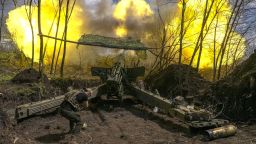
As Ukraine prepares counteroffensive, Russia appears in disarray
A separate but related problem for Ukraine is that the Russians have been moving some of their equipment further back and out of reach of the HIMARS systems, which have a range of about 50 miles.
While the rocket systems are capable of firing longer-range missiles called ATACMS – which can reach targets over 185 miles away – the US has resisted providing them to Ukraine both because the missiles are in limited supply and because the US is worried Russia would see them as too provocative.
The British official acknowledged that since HIMARS were first introduced, the requirements, the training and supplementary equipment has changed as Russia’s electronic interference has evolved.
“Jamming is like the weather or the terrain, it’s something that happens that you have to deal with,” the official said. Still, he added, HIMARS remains a “highly useful piece of kit.”
July 12th 2023
Medvedev accuses NATO of risking World War III
Russia’s former Prime Minister Dmitry Medvedev has accused NATO of bringing World War Three closer by giving Ukraine military aid.
Medvedev said the Western alliance’s new support package to Ukraine would not deter Moscow from achieving the goals of its invasion.
“The completely crazy West could not come up with anything else. In fact, it’s a dead end. World War Three is getting closer,” he commented on the first day of the NATO summit via Telegram.
The West’s pledge to support Kyiv includes large supplies of advanced arms and ammunition.
Russia denounced Western involvement in a “special military operation” in Ukraine.
“What does all this mean for us? Everything is obvious. The special military operation will continue with the same goals,” Medvedev said.
Russian Defence Minister Sergei Shoigu said Moscow will use “similar” weapons if the US supplies cluster bombs to Ukraine – a statement Medvedev echoed on Tuesday.
He said Moscow should now use “inhumane weapons” hinting Kyiv had already been using them on the front lines.
Both warring sides have repeatedly accused each other of using cluster munitions during the course of the war.
Comment NATO was created specifically to block Russia. Biden and Zelensky have agreed that Ukraine will join NATO. Billionaire Zelensky has told ‘his people’ that this will make his people safe. Northern Europe is now western militarised and Erdogan has joined the club. Oily overpaid U.K Chancellor Jeremy Hunt has told his masses that they must suffer while the elite keep bonuses and benefit from lower class taxpayer bail outs. This is socialism for the rich. Security services are labelling us dissidents as right wing terrorists. Where has the Covid Terror conveniently gone ? China will be next and needs to get as close to Russia as possible. Thay is if they don’t want the western ‘rules based’ New World Order to strangle them.
China is next on the list.
R J Cook
July 11th 2023
Nimo Omer |
| Good morning.Today, Nato members are gathered in Vilnius, Lithuania’s capital, for their annual summit. Before Russia’s invasion of Ukraine, the military alliance seemed to have lost a lot of its purpose, and was desperately seeking relevance. Now, thanks to the threat posed by the Kremlin, it has been revitalised. The agenda is packed and the goal is to try to create common ground and settle the conflicting goals and desires of its members, as well as making key decisions on the war in Ukraine and redefining what the future of a relationship between Russia and Nato might look like.Will Ukraine finally get clarity on when it will join Nato? Will member states increase their defence spending? Will Joe Biden give Erdoğan fighter jets despite a lack of congressional approval? These are just some of the questions that will be hashed out in the coming 48 hours. |
| In depth: What’s at stake as world leaders descend on Vilnius |
 |
| When will Ukraine become a Nato member?Ukraine has been trying to become a Nato member for years, but Putin made it clear that if the alliance were to cultivate closer ties with Ukraine – let alone admit it as a member – there would be significant consequences.And then the invasion happened. Nato has, for the last year and a half, been helping Ukraine by supplying equipment, money and training – but immediate membership has never been less likely, even though Kyiv formally requested a fast track accession last September.The reasons are pretty simple. Nato’s core Article 5 collective defence principle, which means that an attack on one member state is an attack on all members, would effectively result in a global war. “[Nato] would actually have to be sending troops, possibly ground troops, into battle. That’s why they can’t do it now,” Patrick says.So – if not now, when? One alternative route, supported by a number of Nato members is that Ukraine could be given a fast track in the same way that Finland has. “This would mean that when the war is over, Ukraine would automatically be allowed to join on the basis that most of its weaponry will be compatible with Nato and that it will be in tune with how Nato thinks and operates,” Patrick says. However, from the latest reports on the last-minute talks before the summit starts today, the expectation is that Nato members will not set clear preconditions for Ukraine’s membership.Some have argued that giving Ukraine a clear timeline almost incentivises Russia to keep the war going to stop that from happening. Others have said that framing Ukraine’s Nato membership like this effectively gives Putin a veto.The US and Germany want to tread even more carefully in case of further antagonising Putin, who has been paranoid about Nato expanding eastward towards Russia’s border. “A lot of it ultimately comes down to a dispute about what will be the future relationship between the west and Russia once this war ends,” says Patrick.Security guarantees for UkraineOutside of membership, another key part of the summit will be the question of security guarantees for Ukraine as the war grinds on. “There’s going to be an extension of what’s already happening but put on a longer timeframe,” Patrick says. Nato will continue to supply arms, particularly weaponry that is compatible with Nato, and there will also likely be some kind of joint production of ammunition and weaponry between Ukraine and Nato members.“The value of the security guarantees will depend on how specific they are and, as far as I can see, they’re still being worked out even though we’re on the eve of the summit,” Patrick adds.Sweden joining Nato |
 |
| Ukraine is not the only country wanting member status – Sweden has been trying to join the alliance since the start of Russia’s invasion, ending decades of neutrality and military non-alignment. Most of the members had no objections. However, for the past year, Turkey’s President Recep Tayyip Erdoğan has stood in the way of Sweden’s accession, alleging that the country is housing Kurdish separatist “terrorist” groups, in particular the militant Kurdistan Workers’ party (PKK).Things were further complicated when Erdoğan threw in fresh demands that the EU renew talks with Turkey to finally get a seat at the EU table – where there is no enthusiasm to allow Turkey to join. “Erdoğan is the kind of guy who looks for leverage and traction. He saw that if he vetoed Sweden’s membership he would have a bargaining chip, which he didn’t have hitherto,” Patrick says.For a while, it really looked the stalemate between Turkey and Sweden would remain. However, after last-ditch talks last night, Erdoğan finally agreed to set aside his veto and support Sweden’s accession. This leaves Hungary as the last country standing in the way, thoughits prime minister, Viktor Orbán, has implied he will move soon.Money mattersUkraine and Sweden are just two of a plethora of topics that leaders will have to go through. There is a lot of discussion to be had about the amount of support the eastern flank of Nato will receive. “The feeling is that the security situation in Poland may have changed as a result of the Wagner group installing themselves in Belarus, so there’s quite a push by the Poles to get more support,” Patrick says.And then there is the small question of budgets and spending. In 2014, members agreed to move towards spending 2% of their GDP on defence by 2024. As that deadline approaches, leaders in Vilnius will agree to make 2% the floor – rather than the ceiling – of spending. “In reality, there’s still a lot of Nato member states that have not reached 2% but will soon,” Patrick adds.Nato allies have 48 hours to settle divisions and disparate goals, all the while the conflict continues. “The leaders have ended up with a global blancmange of issues,” Patrick concludes. “Trying to get them all sorted and aligned at the same time is really hard.” |
July 10th 2023
| NATO was set up in the aftermath of World War II for several purposes, among them ensuring a European war could not happen again and keeping the Soviet Union at bay. Seventy years later, French President Emmanuel Macron declared it brain dead — out of date and out of touch.Russia’s invasion of Ukraine may have given the alliance a new lease of life as it responds to the most devastating land war in Europe since those times. It’s bulking up its military presence on Europe’s eastern flank, funneling weapons and expertise to Kyiv and providing a forum for renewed conversations about European-wide defense.Key Reading: Solidarity or Squabbling: Five Things to Watch at NATO’s Summit Biden’s Cluster Munitions to Ukraine Fuel Concern for Democrats Biden, Erdogan Speak as US Seeks Deal on Sweden’s NATO Bid China Looms Large as NATO Allies Debate Expanded Role in AsiaIndeed Macron now says Russian President Vladimir Putin has “revived” the North Atlantic Treaty Organization with “the worst of electroshocks” — hundreds of thousands of people have been killed and wounded and millions displaced in Europe’s biggest refugee crisis in the past eight decades. Ukraine will certainly be front of mind when alliance leaders including US President Joe Biden meet this week in Lithuania.But questions remain about its long term utility, where the biggest challenge for NATO may not be Putin but a rising power much further from Europe’s shores — China.Some NATO members recognize this. There are efforts to bring leaders from the Asia-Pacific region into the conversation, with several attending the summit. And NATO is more willing to display a military presence — if mostly confined to joint drills — closer to China.But keeping NATO fit for purpose is no easy task. Some members are wary of stretching its geographic footprint given the challenges on the continent itself.  There have also been concerns about pitching an alliance with a defensive remit into a broader tussle for influence between the US and China. NATO probably does need to engage because China’s expanding clout is a question for Europe, too. But some fret it risks becoming a vehicle for US foreign policy.NATO has become a household name again as it helps marshal Ukraine’s allies against Russia. And the conversation about China is for all sorts of reasons at a nascent stage.Still, it’s a crucial one when thinking about where NATO will be, and needs to be, a decade from now. — Rosalind Mathieson There have also been concerns about pitching an alliance with a defensive remit into a broader tussle for influence between the US and China. NATO probably does need to engage because China’s expanding clout is a question for Europe, too. But some fret it risks becoming a vehicle for US foreign policy.NATO has become a household name again as it helps marshal Ukraine’s allies against Russia. And the conversation about China is for all sorts of reasons at a nascent stage.Still, it’s a crucial one when thinking about where NATO will be, and needs to be, a decade from now. — Rosalind Mathieson |
 German and Lithuanian soldiers during NATO exercise Griffin Storm on June 26. Photographer: Andrey Rudakov/BloombergCheck out the latest Washington Edition newsletter. You can sign up to get it in your inbox every weekday.And if you are enjoying this newsletter, sign up here. German and Lithuanian soldiers during NATO exercise Griffin Storm on June 26. Photographer: Andrey Rudakov/BloombergCheck out the latest Washington Edition newsletter. You can sign up to get it in your inbox every weekday.And if you are enjoying this newsletter, sign up here. |
| Global Headlines |
| Europe’s defense contractors — flooded with demands for everything from ammunition to shoulder-launched missiles and combat vehicles — face a dilemma almost 18 months into the war in Ukraine. Do they gamble on expanding production, assuming the war and tensions with Russia will last indefinitely? Or do they hold back until they get long-term commitments from governments that have spent decades cutting their defense budgets?Russia’s top military commander was shown on state television today for the first time since the abortive mutiny by Wagner mercenaries aimed at ousting him. Follow our Ukraine Recap for the latest coverage of the war.Two days of meetings between Treasury Secretary Janet Yellen and top officials in Beijing suggested there’s hope the US and China can set guardrails to contain the damage from their intensifying rivalry. Yellen repeatedly sought to emphasize that deep and broad bilateral economic relations are a good thing, a message that may ease concern among US allies that Washington is aiming to fragment the global economy between an American and a Chinese bloc.A group of Chinese female economists and entrepreneurs who dined with Yellen have been blasted by online nationalists for betraying their country by interacting with the US official. |
Comment China needs to wake up. NATO failed with the coup. Ultimately they will do anything to cower and achieve regime change in Russia. China has not supported its ally, so is paving the way for its own encirclement. NATO wants Asia.
R J Cook
July 9th 2023
War in Ukraine: Biden flies to UK amid concern over cluster bombs
Related Topics
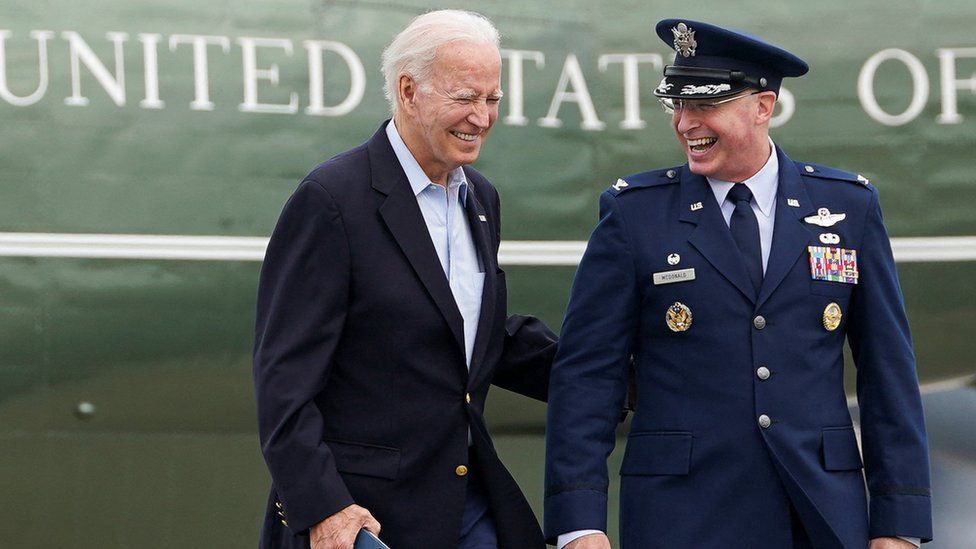
By Kathryn Armstrong
BBC News
US President Joe Biden is heading to Europe ahead of a Nato summit after several allies questioned his decision to send cluster bombs to Ukraine.
The UK and Canada are among those who voiced concern about supplying the bombs, which are widely banned because of the danger they pose to civilians.
The US says they are needed because Ukraine’s weapon stocks are dwindling.
Mr Biden will arrive first in the UK, on Sunday evening, before heading to Lithuania for this week’s Nato summit.
On Monday, he will meet British Prime Minister Rishi Sunak to discuss various issues, including the war in Ukraine. He will also meet King Charles for the first time since the King was crowned.
Members of Nato – a military alliance of 31 Western nations – will then meet in Vilnius on Tuesday and Wednesday.
Finland will attend its first summit since joining in April. Plans from Sweden to follow suit have been blocked by Turkey, which accuses it of harbouring terrorists.
Mr Biden is expected to seek further support from Mr Sunak to help broker a deal with Turkey.
The matter is also expected to be on Nato’s agenda in Lithuania – along with boosting ammunition stockpiles and reviewing defence plans.
Ukraine harbours its own ambitions of joining Nato. But speaking to CNN before his trip, Mr Biden said this could not happen until the war was over – in line with the alliance’s long-standing policy.
Citing Nato’s mutual defence pact, Mr Biden pointed out that members undertake to protect “every inch” of each other’s territory – meaning that “if the war is going on, then we’re all in war”.
Ukrainian President Volodymyr Zelensky has previously accepted this position, while requesting a “signal” that his country will be able to join the alliance when the war is over. He is expected to attend this week’s summit.

A potentially awkward visit

This is, potentially, an awkward visit coming at a critical time for the US-led Nato alliance.
President Biden may not have intended to cause offence by skipping King Charles’ coronation in May, but his absence was noted.
Then there is the business over who should be the next secretary general of Nato. The UK and the Baltic states favoured the British Defence Secretary, Ben Wallace, who has been instrumental in galvanising Western support for Ukraine.
But without US backing, that’s a non-starter – and Mr Biden instead appears to favour the former German defence minister and European Commission head, Ursula von der Leyen.
And there is also the row over cluster bombs. The UK is among 123 nations to ban these weapons which can cause indiscriminate harm to civilians.
But the US is going ahead, in the heat of international criticism, in supplying them to Ukraine as its forces struggle to break through Russia’s defences in the south of Ukraine.
But Mr Biden’s stopover in Britain is so brief that any cracks in the transatlantic alliance are likely to be smoothed over by warm handshakes and ample protocol.

On Friday, the US confirmed it was complying with a Ukrainian request to send cluster bombs – and was doing so as part of a military aid package worth $800m (£626m).
Mr Biden told CNN it had been a “very difficult decision” but that he had eventually acted because “the Ukrainians are running out of ammunition”.
But a number of Nato allies quickly distanced themselves from the decision.
Mr Sunak did not directly criticise his US counterpart. But he made clear that the UK was one of 123 countries that had signed up to the Convention on Cluster Munitions – an international treaty which bans the production or use of the weapons.
Canada and Spain – Nato members, like the US and UK – also stated their opposition to the weapons, as did New Zealand, a Nato partner.
“No to cluster bombs and yes to the legitimate defence of Ukraine, which we understand should not be carried out with cluster bombs,” Spain’s Defence Minister Margarita Robles said.
But Germany, another signatory of the treaty and Nato member, said that while it would not provide such weapons to Ukraine, it understood the American position.
Cluster bombs typically release lots of smaller bomblets that can kill indiscriminately over a wide area.
One of the concerns surrounding their supply is their failure – or dud – rate. Unexploded bomblets can linger on the ground for years and then indiscriminately detonate.
Ukraine has promised the weapons will not be used in civilian areas and will monitor and report on their use, but Russia dismissed these assurances as “not worth anything”.
Comment It is nice to see that Joe Biden thinks this is something to smile about. His son Hunter and proxy Zelensky have made a fortune out of this war for Hypocrisy. I am sick of hearing about what is wrong with Russia. It is what is wrong with the west, especially war rabble rouser Britain tbat bothers me. At least Biden missed the grotesque King Charles Coronation. The dredful patronising militaristic monarchy defines this class divided wealth obsessed fake democracy. I would rather have Vladimir Putin that this sham state of ‘freedoms.’
Frank Gardner is the only U.K Foreign affairs correspondent worth listeming to. He paid a high price for doing the job properly and has my respect for what little that is worth in Police State Britain.
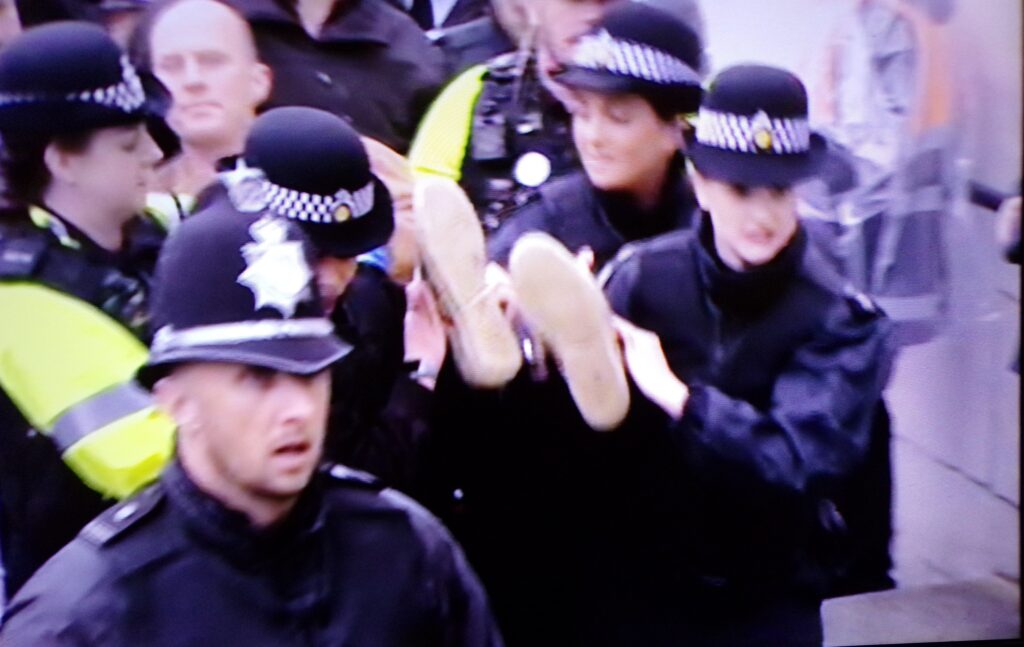
R J Cook
R J Cook
July 8th 2023
In Depth
Are we heading for World War Three?
Analysts warn this may be ‘one of the most dangerous periods in human history’
12 Jun 2023

The Indo-Pacific and Ukraine are not the only potential flashpoint involving major powers around the globe
Illustrated/Getty Images
Killing More Efficiently Thanks To U.S.
Marta Hurtado, speaking for the UN human rights office, said cluster bombs on Friday: “The use of such munitions should stop immediately and not be used in any place.”
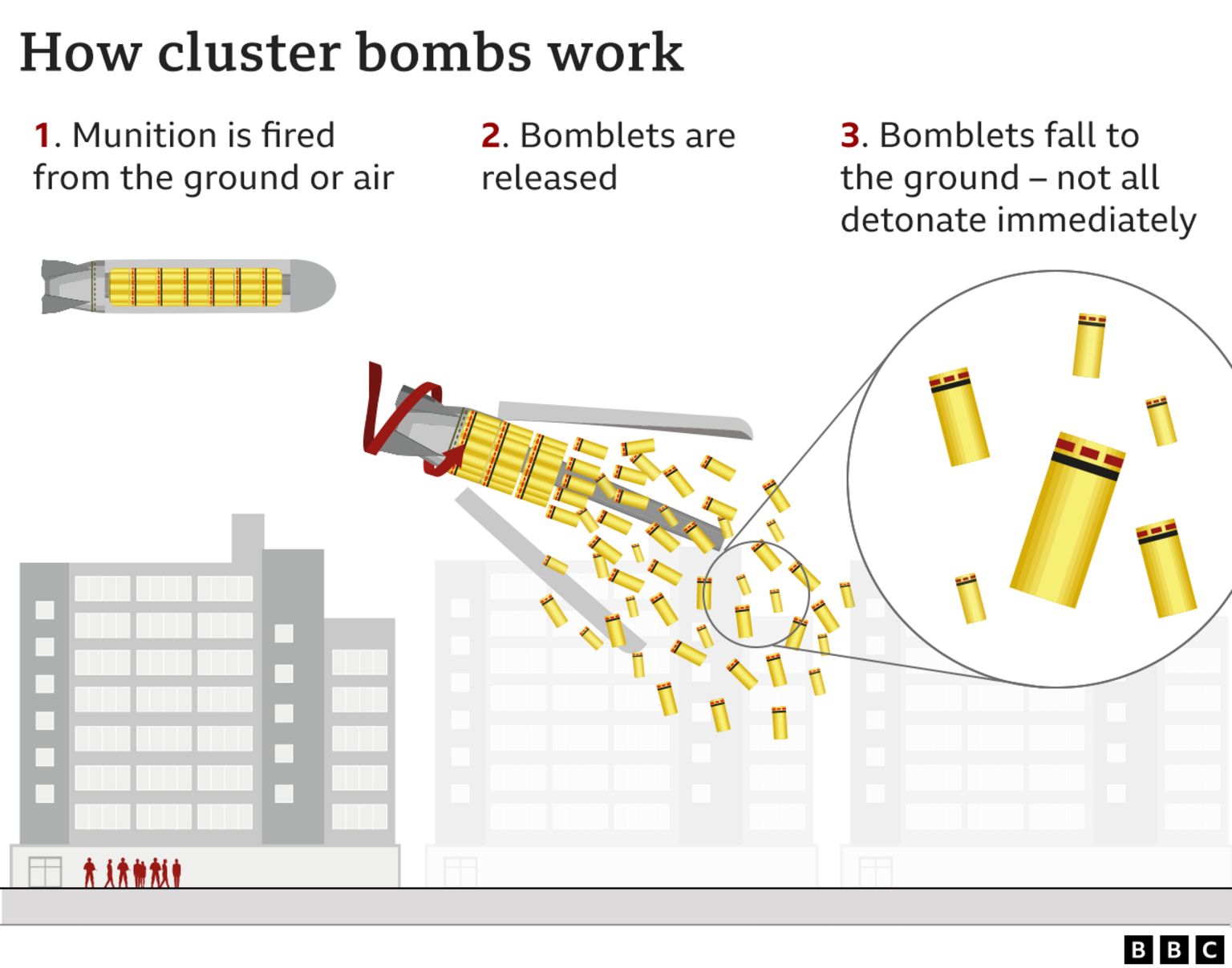
Russia’s ambassador to the US criticised Mr Biden’s decision.
“The cruelty and cynicism with which Washington has approached the issue of transferring lethal weapons to Kyiv is striking,” Anatoly Antonov was quoted as saying by Tass news agency.
“Now, by the fault of the US, there will be a risk for many years that innocent civilians will be blown up by submunitions that have failed.”
Russian President Vladimir Putin has previously accused the US and its allies of fighting an expanding proxy war in Ukraine.
But Ukrainian President Volodymyr Zelensky thanked the US president for “a timely, broad and much-needed” military aid package worth $800m (£626m).
He tweeted that it would “bring Ukraine closer to victory over the enemy, and democracy to victory over dictatorship”.
Ukraine’s counter-offensive, which began last month, is grinding on in the eastern Donetsk and south-eastern Zaporizhzhia regions.
Last week, Ukraine’s military commander-in-chief Valery Zaluzhny said the campaign had been hampered by a lack of adequate firepower, and expressed frustration with the slow deliveries of weapons promised by the West.
Pentagon spokesman Colin Kahl said giving Ukraine cluster munitions would let “the Russians know that the Ukrainians are going to stay in the game” when it comes to the war.
Human rights groups criticised the decision, with Amnesty International saying cluster munitions pose “a grave threat to civilian lives, even long after the conflict has ended”.
The US Cluster Munition Coalition, which is part of an international civil society campaign working to eradicate the weapons, said they would cause “greater suffering, today and for decades to come”.
Reaction from US lawmakers on Capitol Hill to the decision to send cluster munitions to Ukraine has been mixed, with some Democrats labelling the decision “alarming” and “a terrible mistake”.
Adam Smith, a Washington Democrat on the House Armed Services Committee, had a different view – telling the BBC the White House had made the “right call”.
“Making sure that the Ukrainians can retake their territory is one of the most important things we can do to help reduce civilian casualties,” he said.
In a joint statement, Republican leaders on the House and Senate foreign affairs committees said the Democratic president’s move would allow Ukraine’s forces “to target and eliminate Russian forces more efficiently”.
July 7th 2023
New $44 Billion Package From U.S.A To Escalate NATO Proxy Greed Regime Change War On Russia – R J Cook
US plans to send controversial cluster munitions to Ukraine
By Madeline Halpert
BBC News, New York
The US will send Ukraine a cluster munitions package to help in its counteroffensive against Russia.
The White House said it had postponed the decision for as long as it could because of the risk of civilian harm from such unexploded ordnance.
Ukraine has been asking for the weapons for months amid an ammunition shortage.
Cluster munitions – which are banned by more than 100 countries – are a class of weapon that contain multiple explosive bomblets called submunitions.
US President Joe Biden said in a cable TV interview that it was “a very difficult decision on my part” to send the bombs.
“I discussed this with our allies,” he told CNN, “I discussed this with our friends up on the [Capitol] Hill.”
He said he had decided to send the munitions because “the Ukrainians are running out of ammunition”.
Mr Biden could face questions from allies about the matter at a Nato summit in Lithuania next week.
National Security Adviser Jake Sullivan told Friday’s daily White House briefing: “We recognise the cluster munitions create a risk of civilian harm from unexploded ordnance.
“This is why we’ve deferred the decision for as long as we could.”
He added: “Ukraine would not be using these munitions in some foreign land. This is their country they’re defending.”
Mr Sullivan said Ukraine was running out of artillery and needed “a bridge of supplies” while the US ramps up domestic production.
“We will not leave Ukraine defenceless at any point in this conflict period,” he said.
Comment Anglo U.S Power Crazed Hypocrit NATO just must have Ukraine. The lower orders believe this has nothing to do with record inflation, impossible prices, more poverty and misery as U.K and Europe’s lower classes pay the price. Germany has suffered serious job losses as they have lost a major trading partner in Russia. Meanwhile companies like Tesco , utilities and banks are making record profits. Bonuses have never been higher. Police are on high alert to keep the population down and protecr the rich.

R J Cook 1955
July 3rd 2023
Ukraine war: The lethal minefields holding up Kyiv’s counter-offensive
Related Topics
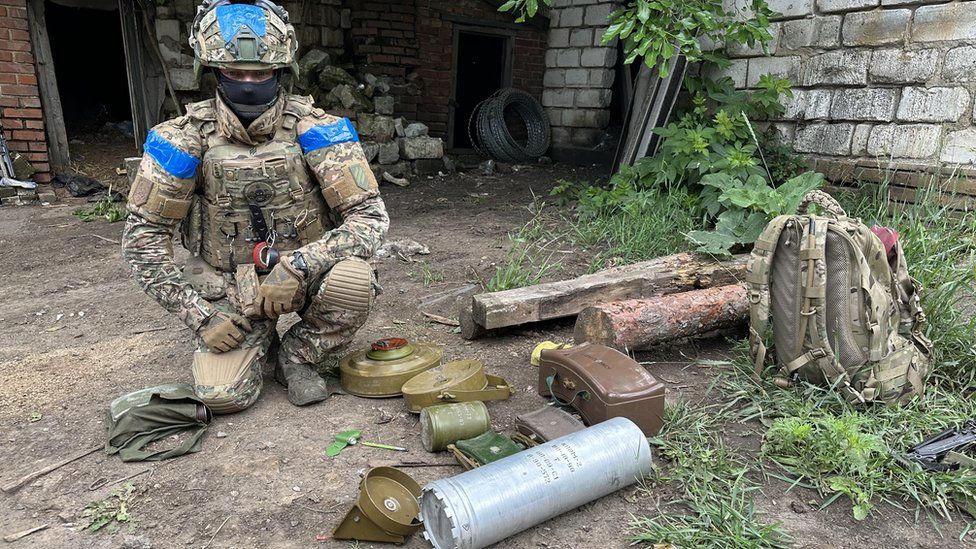
By Andrew Harding
BBC News, in Predtechyne and Neskuchnoye, Donbas
A Ukrainian soldier drags himself through the long grass, one leg trailing limply behind him. Seconds later, a flash of bright orange and a cloud of white smoke mark the spot, just a few metres away, where yet another land mine has been triggered.
As a second badly wounded soldier pulls himself up on to the relative safety of a nearby armoured personnel carrier – arms flailing like a swimmer trying to cling onto a lifeboat – a thick smudge of dark red blood marks his agonising progress.
All this was captured, live, last week, by a Ukrainian army drone hovering overhead on the frontlines south of the Donbas city of Bakhmut. From above, the cratered minefield looked like it was covered in a haphazard rash of dark brown crop circles.
“Mines are terrifying. They scare me more than anything else,” said Artyom, a 36-year-old soldier from Ukraine’s 108th Territorial Defence Brigade. Two days earlier, two of his colleagues had stood on “petals” – small, green, anti-personnel mines – that had recently been scattered across a field by Russian rockets.
“Our guys were experienced. But it’s hard to have eyes everywhere. Both have leg amputations. One leg each. We have [mine] injuries after every fight,” said Artyom, a trained sapper, explaining that the rockets enable Russian forces to plant new mines in places that have already been liberated and cleared by Ukrainian forces.
As Ukraine’s long-anticipated counterattack has not yet achieved the sort of speed and momentum that some had hoped for – including President Volodymyr Zelensky who admitted it was “slower than desired”. A range of soldiers we’ve spoken to on different sections of the frontline have blamed Russian minefields for at least part of that delay.
“Of course, it slows down the movement of troops,” said the commander of a nine-man sapper squad with the call sign Dill. He’d just finished a de-mining mission on the nearby frontlines to the east of the tiny, ruined village of Predtechyne, outside Bakhmut. He laid out an array of deactivated Russian mines on the ground beneath a tree, taking care to make sure he could not be spotted by Russian drones overhead.
“The enemy has no mercy for their own soldiers. They’re used as cannon fodder. But we’re trying to move forwards with the minimum of casualties,” said the Lieutenant Serhii Tyshenko from the 3rd Assault Brigade, speaking from the shelter of a nearby bunker.
Some three hours’ drive further south, across a succession of lop-sided pontoon bridges, Ukrainian sappers crouched by the side of a cratered road, carefully deactivating a powerful anti-personnel Claymore mine that had been hidden near an electricity pole, poised to send shrapnel into infantry or vehicles.
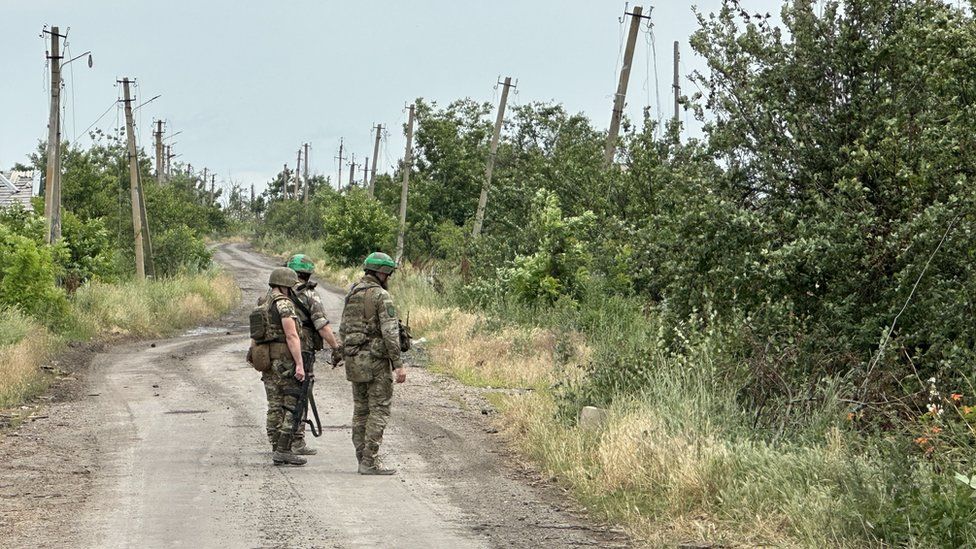
“I hate this job,” said Artyom, a red-bearded former garage mechanic, moments after he’d finished making the mine safe. There was a whistle, then a boom as a Russian artillery shell hit the fields nearby.
Over the lip of a nearby hill, Ukrainian infantry were slowly advancing southwards beyond the newly captured village of Rivnopil. Artyom’s anger was not just a response to the dangers of minefields, but to the “sly” mentality that he felt must lie behind the act of laying mines and boobytraps, rather than fighting your enemy “man to man”.
Later, in their temporary base in a cottage several kilometres away, the soldiers expressed frustration about a lack of mine-clearing equipment, and a shortage of sappers – four of whom had been injured in recent weeks.
But then Artyom showed us a large antenna and brought out a laptop to begin playing recordings of what he said were recent radio intercepts of Russian soldiers. The expletive-ridden messages appeared to indicate a degree of chaos and low morale.
“Our kamikaze drone hit [our own] car. We have one dead, another injured. Get the [expletive] out of there.”
“The [soldiers] are running away. Some of them are stealing cars… 50 people have fled. They [expletive] ran away…”
The radio intercept suggested that Russian soldiers were deserting their positions after a Ukrainian artillery bombardment.
“This happens from time to time. In groups of 10 or 20 – [Russian] people disappear and leave without permission. The Russians realise we can eavesdrop on their communications but sometimes they forget,” said Artyom.
He described himself as a “realist” regarding Ukraine’s counter-offensive, believing that too many people “in the media and in society are in a hurry”, and expecting sudden progress.
“I believe the worst option is always possible. The worst is slow [progress],” he said.

Two Ukrainian fighter jets flew low overhead with a deafening roar, followed by a succession of booms from the frontlines further south. Soon afterwards, we could hear artillery and what sounded like a longer-range HIMARS rocket system pounding Russian positions.
Ukraine’s counter-offensive may be slow, and relatively cautious at this stage. But one officer, speaking on background, suggested that this patient approach would soon pay off in dramatic fashion, as long-range strikes destroyed Russia’s ability to rearm frontline units, and low Russian morale provided opportunities for strategic breakthroughs by Ukrainian forces.
“You will see this soon,” he said.
As for the vast stretches of minefields still lying in front of Ukraine’s counter-attack – Dill, the sapper squad commander near Bakhmut, was quietly confident.
“We are learning to improvise and to invent ways to make quick, safe paths through the minefields. But we are fighting a very vicious enemy,” he said.
July 2nd 2023
Ukraine counter-offensive will be long and bloody, says US Gen Mark Milley
By Alexandra Fouché
BBC News
Ukraine’s counter-offensive against Russia will be difficult and “very bloody”, the US’ highest-ranking military officer has said.
Gen Mark Milley said he was unsurprised that progress had been slower than predicted – but added that Ukraine was “advancing steadily”.
“It goes a little slow, but that is part of the nature of war,” he said.
It comes as Volodymyr Zelensky accused “some” Western partners of delaying promised training for Ukrainian pilots.
Several Western countries have pledged to train Kyiv’s pilots on US-made F-16 fighter jets, but the Ukrainian president said some allies had been “dragging their feet” on the promise.
President Zelensky has previously acknowledged that the Ukrainian offensive was making slow progress.
Gen Milley, chairman of the Joint Chiefs of Staff, told an audience at the National Press Club in Washington on Friday that the counter-offensive was “advancing steadily, deliberately working its way through very difficult minefields… 500m a day, 1,000m a day, 2,000m a day, that kind of thing”.
He added he was not surprised that progress had been slower than expected. “War on paper and real war are different. In real war, real people die,” he said.
“Real people are on those front lines and real people are in those vehicles. Real bodies are being shredded by high explosives.
“What I had said was this is going to take six, eight, 10 weeks, it’s going to be very difficult. It’s going to be very long, and it’s going to be very, very bloody. And no-one should have any illusions about any of that.”
- Countdown has begun to end of Putin, say Kyiv officials
- Wagner still recruiting despite mutiny, BBC finds
Ukrainian soldiers were “assaulting through minefields and into trenches”, he said, adding that “this is literally a fight for their life”.
He said the US was giving Ukraine “as much help as humanly possible”.
Gen Milley is the principal military adviser to the president, the secretary of defence, and National Security Council.
Meanwhile, Ukraine’s military commander-in-chief Valery Zaluzhny said the counter-offensive had been hampered by a lack of adequate firepower.
In an interview with the Washington Post published on Friday, he said he was frustrated by the slow deliveries of weapons promised by the West, from modern fighter jets to artillery ammunition.
“I do not need 120 planes. I’m not going to threaten the whole world. A very limited number would be enough,” he said.
Separately, the head of the US Central Intelligence Agency, William Burns, is reported to have made an unannounced visit to Ukraine last month where he met President Zelensky and Ukrainian intelligence officials.
The CIA director is said to have discussed Ukraine’s counter-offensive against Russian forces, as well as reaffirming the US commitment to intelligence-sharing.
Related Topics
- Zelensky admits slow progress in Ukraine offensive
- Published21 June
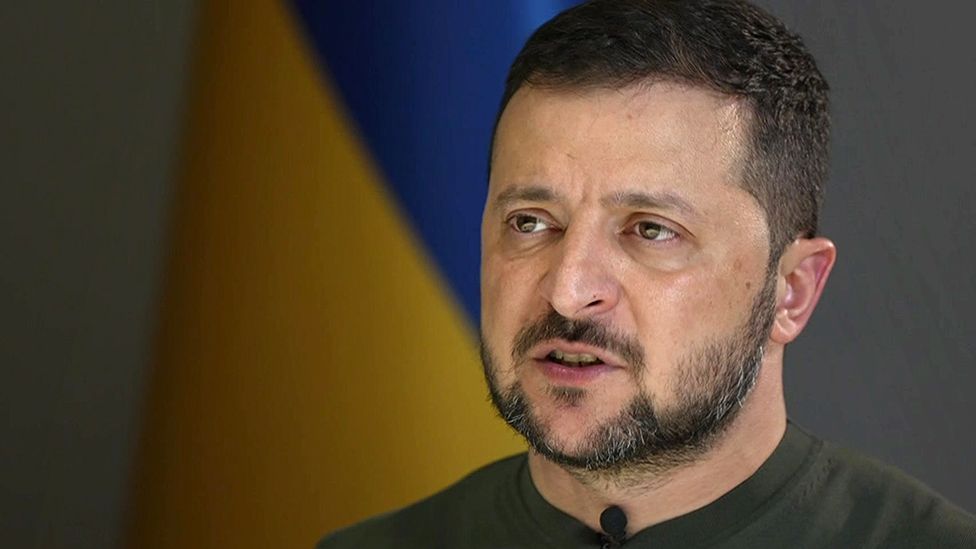
- Eight killed in strike on centre of Ukrainian city
- Published4 days ago
June 27th 2023
Twisting History by R J Cook
Nobody knows how to lie and twist history like the British and U.S sanctimonious elite which is why the following piece is so nauseating. The censors are so institutionalised that literary agents call themselves ‘gate keepers’ and publishers are employing ‘sensitivity readers’.
The British elite made the 1914 -18 European conflict a world war for their naval dominance, trade and empire. Unfairly blaming and punishing Germany for that war, ordinary people went from the misery of war to being ground into the dirt facilitating the rise of Hitler as the voice of a long suffering humiliated people.
Along with France, Britain had key role in shooting Lenin and they promoted Stalin to discredit communism, followed by promoting Hitler’s Nazis to contain him. World War II was inevitable with Britain and the U.S self righteously feigning innocence of war crime in the aftermath.
This elite have lived in fear of communism since 1917 – consequently fearing the massive Russo Chinese Belt & Road. They believed their man Yeltsin and assistant Putin had made the way clear to unbridled asset stripping. Sadly for this planet eating elite, Putin was not and is not an alcoholic. This will not put them off starting World War III. That’s what minions are for and Africa’s surplus population will supply an unending grateful supply of replacements. The elite have been working on deskilling and re educating their indigenous masses for decades
R J Cook
This Is Not 1943
How Putin twists the history of World War IIBy George Packer

February 3, 2023Saved Stories
Yesterday Vladimir Putin went to Stalingrad. It was the 80th anniversary of the Soviet victory over Nazi Germany in the city once named after the Soviet dictator. The current Russian dictator solemnly bowed his head and knelt before a wreath laid to honor the heroes of the battle that turned the tide of World War II. The day before the ceremony, a bronze bust of Joseph Stalin had been unveiled in the city, whose name was changed to Volgograd in 1961. By then Stalin, perhaps the 20th century’s greatest mass murderer, was out of favor. But for Putin, the city is still Stalingrad, the year is still 1943, Nazis are still waging a scorched-earth war, and the heroic Russian people are still fighting a far stronger enemy in defense of the motherland. Only it’s 2023, and the enemy is the independent, democratic, much smaller nation of Ukraine, led by a Jewish president and armed by Western democracies—including Germany.
Putin’s purpose in going to Stalingrad was to connect the past war to the present one, and in doing so to rouse Russian pride and warn his enemies of their coming doom. “Unfortunately, we see that the ideology of Nazism in its modern form and manifestation again directly threatens the security of our country,” he declared in a speech to a military audience. “Again and again we have to repel the aggression of the collective West. It’s incredible but it’s a fact: We are again being threatened with German Leopard tanks with crosses on them.”
To grasp the enormity of this lie—the foundational lie of Russia’s war against Ukraine—it helps to know something about the history of World War II. During Putin’s visit to Stalingrad, I was rereading the classic Rise and Fall of the Third Reich, by William L. Shirer, a CBS radio correspondent who had been based in Berlin in the 1930s. So it was fresh in my mind how Adolf Hitler, in his first move of conquest, annexed Austria in March 1938, claiming it as a historical part of the German Reich, and then held a plebiscite in which 99.75 percent of Austrians officially voted to join Germany. Putin’s first move in this war was to annex Crimea in March 2014, claiming it as a historical part of the Russian Empire, and then hold a plebiscite in which 97 percent of Crimeans officially voted to join Russia.
Next for Hitler in 1938 came the annexation of the Sudetenland, the German-speaking region of Czechoslovakia, where local Nazis, on orders from Berlin, instigated phony pretexts for a German takeover. Relentless Nazi propaganda transformed Czechoslovakia, a progressive democracy, into a hellish aggressor, and charged its president, Edvard Benes, with a litany of made-up crimes. “It is unbearable for a world power to know there are racial comrades at its side who are constantly being afflicted with the severest suffering for their sympathy or unity with the whole nation, its destiny and Weltanschauung,” the Fuhrer roared. “To the interests of the German Reich belong the protection of those German peoples who are not in a position to secure along our frontiers their political and spiritual freedom by their own efforts.”
It isn’t all that hard to replace the German Weltanschauung with Ruskiy Mir, or “Russian world”; Hitler the protector of oppressed German speakers with Putin the liberator of oppressed Russian speakers; Edvard Benes with Volodymyr Zelensky; the Sudetenland with the Donbas; Berlin-backed Sudeten Nazis with Moscow-backed Ukrainian separatists. In both cases, incidents in the breakaway regions were ginned up on orders from the neighboring empire, giving it an excuse to invade. In the Reich Chancellery then, as in the Kremlin now, every gesture toward peace negotiations was a sham to buy more time for war. Within six months of the September 1938 Munich Conference where the Sudetenland was surrendered to Germany, Hitler swallowed the rest of Czechoslovakia—and he was just beginning. Eight years after starting a war in Crimea and the Donbas, Putin launched a full-scale invasion of Ukraine, bringing destruction, murder, rape, occupation, annexation, deportation, threats of annihilation, and many more lies.
Recommended Reading

Parking for Gold

Coincidences and the Meaning of Life
History doesn’t repeat itself; it rarely even rhymes. Putin’s claim that Russia is reliving the defense of Stalingrad shows how misleading and pernicious analogies can be. It’s generally wise to resist them—this one above all, for Hitler truly was unique. But as I made my way through Shirer’s 1,100-page book, resisting the analogies required much more effort than drawing them.
Putin raises the Nazi ghost as a way not just to discredit his enemies with a false charge, but to immunize himself from having a far more plausible charge flung at him. This is propaganda as projection—a common technique of demagogues. Hitler accused the Czechs and Poles of aggression against Germany as he prepared to invade; Donald Trump accused Hillary Clinton and Joe Biden of corrupting American justice as he turned the executive branch into an instrument of his personal interests. “No puppet!” Trump retorted in a debate after Clinton suggested how Putin regarded him. “You’re the puppet!”
In Stalingrad, Putin used the historical lie where he knew it would hurt most—against the Germans. The agony of Chancellor Olaf Scholz’s decision, after months of hesitation, to send tanks to Ukraine reflected a genuine fear among Germans—not so much that Russia would retaliate with nuclear weapons, as Putin threatened in his speech, but that Germany’s Leopards are still Panzers, that their use in Ukraine might still evoke images of Operation Barbarossa, that the country can never live down its darkest history. I was in Berlin in 2014 during the months just after Putin began the war in Ukraine, and Germans were deeply divided, with a large percentage—though not a majority—sympathetic to Russia. Friends explained that the nightmare of another war with Russia still haunts Germany, but even more, the legacy of 27 million Soviet dead in World War II remains a source of almost transhistorical guilt. Putin, who served in Dresden, in East Germany, as a KGB officer, understands that he has only to say “Nazi” for the German soul to tremble.
I would like to hear Scholz, or Zelensky, or Biden, lay this ghost to rest by reversing the charge. Germany’s Leopards will be used, at last and much too late, to help Ukraine’s military defend the country against a far more numerous and heavily armed invader. The Germans were willing to lose entire divisions in the crucible of Stalingrad; the Russians are willing to do the same in Bakhmut, and they’re sending tens of thousands more troops for a new offensive in the Donbas, where cities and villages lie in ruins. Scholz’s belated decision should be seen not as a failure to learn from history, but as one more step in Germany’s long reckoning with its crimes. The Leopards are part of the same project of national atonement as the Holocaust Memorial, in the heart of Berlin. They won’t erase the past, much less, as Putin does, deform it. They will honor it.
George Packer is a staff writer at The Atlantic.
June 26th 2023
The swirling mists of swindler James Cleverly
 Mr Cleverly is a liar, and he knows it. The gdp of Ukraine is smaller than the UK NHS budget, and weighs in at N° 60 in the global output league. Prior to the Russian occupation, its massive contribution to planetary food was just 0.3% – and two thirds of it went to Belarus, Kazakhstan and….um, Russia. The three reasons Vladimir Putin occupied The Ukraine are (1) persistently murderous attacks upon Russians in that country with 173 ceasefire violations by the Ukrainian élite since 2014 (2) solid evidence of 64 bioweapon labs in the Ukraine funded and run by the US Pentagon and (3) Zelenskyy being the recipient of some $1.2 billion during the Biden Presidency – a vast fortune the former washed-up Soap actor has yet to explain….and in which Sleepy’s graft-riddled son Hunter is multiply implicated. Cleverly’s mist is designed to hide several realities: first, that an effectively broke UK has supported Ukraine with monies so far that total £1.5 billion in economic and humanitarian support such as the delivery of more than 11 million medical items as well as food supplies, ambulances and so forth. This does not include the arms the UK has supplied – some £4.6 billion in military assistance to Ukraine: all up, the United Kingdom is the second biggest global donor to Zelenskyy the Zany Zealot ….behind (of course) the United States. We have NOTHING to gain and NO INTEREST IN this hangover from the collapse of the USSR. But as usual, we have a Special Relationship with the American Unelected State roughly akin to being the poodle of a pimp-Madame. Second, British households are facing the fastest annual increase in food and drink prices since 1977, now running at 19.2% – higher than Gambia’s 17.3%, a country which has to import almost everything. Not one single grain of wheat or rice is exported from Ukraine to Gambia or the United Kingdom. Ergo sum, some other factor must be in play. The reality is that wholesale Food prices – especially for fruit, vegetables and sugar – have risen after poor harvests in Europe and North Africa reduced availability earlier this year. Retailers and wholesalers have had to pay more for items such as tomatoes, peppers and salad, which have been in short supply. As many of you will already know, the EU and North Africa are not close neighbours of Ukraine: but EU farming policies could very easily screw up the UK were we (Heaven forbid) to rejoin the European Bunion. You might also wonder why we – an offshore island NOT in the EU – have contributed far more than the EU Big Players to Ukrainian geopolitical games. Rinse and repeat along the lines of being the poodle of a pimp-Madame….plus also a Cash Cow for Brussels. But the New World Order of Cleverly’s mist is simply part of the ever-onward March of veggie, let’s eat bugs, red meat bad, farty-cows, climate emergency myth….designed to rationalise restricted vehicle movement, hitech surveillance of travel and the slaughter of livestock – and all in turn clearly inflationary when demand exceeds supply. The systematic creation of a food emergency is hidden in that mist by blaming one tiny war in one country with a tiny food gdp. It’s yet another Whopper from the NWO boys and girls. You couldn’t make it up. And it doesn’t end there: go to this Google search page and you can read about nine separate bits of nifty evasion and footwork that caused Sunny Jim to be hauled up before the Commons Standards and Procedures Committee. But this bloke is unconcerned with about standards, because he doesn’t have any. Mr Cleverly is a liar, and he knows it. The gdp of Ukraine is smaller than the UK NHS budget, and weighs in at N° 60 in the global output league. Prior to the Russian occupation, its massive contribution to planetary food was just 0.3% – and two thirds of it went to Belarus, Kazakhstan and….um, Russia. The three reasons Vladimir Putin occupied The Ukraine are (1) persistently murderous attacks upon Russians in that country with 173 ceasefire violations by the Ukrainian élite since 2014 (2) solid evidence of 64 bioweapon labs in the Ukraine funded and run by the US Pentagon and (3) Zelenskyy being the recipient of some $1.2 billion during the Biden Presidency – a vast fortune the former washed-up Soap actor has yet to explain….and in which Sleepy’s graft-riddled son Hunter is multiply implicated. Cleverly’s mist is designed to hide several realities: first, that an effectively broke UK has supported Ukraine with monies so far that total £1.5 billion in economic and humanitarian support such as the delivery of more than 11 million medical items as well as food supplies, ambulances and so forth. This does not include the arms the UK has supplied – some £4.6 billion in military assistance to Ukraine: all up, the United Kingdom is the second biggest global donor to Zelenskyy the Zany Zealot ….behind (of course) the United States. We have NOTHING to gain and NO INTEREST IN this hangover from the collapse of the USSR. But as usual, we have a Special Relationship with the American Unelected State roughly akin to being the poodle of a pimp-Madame. Second, British households are facing the fastest annual increase in food and drink prices since 1977, now running at 19.2% – higher than Gambia’s 17.3%, a country which has to import almost everything. Not one single grain of wheat or rice is exported from Ukraine to Gambia or the United Kingdom. Ergo sum, some other factor must be in play. The reality is that wholesale Food prices – especially for fruit, vegetables and sugar – have risen after poor harvests in Europe and North Africa reduced availability earlier this year. Retailers and wholesalers have had to pay more for items such as tomatoes, peppers and salad, which have been in short supply. As many of you will already know, the EU and North Africa are not close neighbours of Ukraine: but EU farming policies could very easily screw up the UK were we (Heaven forbid) to rejoin the European Bunion. You might also wonder why we – an offshore island NOT in the EU – have contributed far more than the EU Big Players to Ukrainian geopolitical games. Rinse and repeat along the lines of being the poodle of a pimp-Madame….plus also a Cash Cow for Brussels. But the New World Order of Cleverly’s mist is simply part of the ever-onward March of veggie, let’s eat bugs, red meat bad, farty-cows, climate emergency myth….designed to rationalise restricted vehicle movement, hitech surveillance of travel and the slaughter of livestock – and all in turn clearly inflationary when demand exceeds supply. The systematic creation of a food emergency is hidden in that mist by blaming one tiny war in one country with a tiny food gdp. It’s yet another Whopper from the NWO boys and girls. You couldn’t make it up. And it doesn’t end there: go to this Google search page and you can read about nine separate bits of nifty evasion and footwork that caused Sunny Jim to be hauled up before the Commons Standards and Procedures Committee. But this bloke is unconcerned with about standards, because he doesn’t have any. |
The Slog
June 25th 2023
Russia: Wagner mutiny shows real cracks in Putin authority – US
https://emp.bbc.co.uk/emp/SMPj/2.49.3/iframe.htmlMedia caption,
Watch: Putin says the actions from mutineers are “a knife in the back of our people”
An attempted armed mutiny in Russia shows “real cracks” in President Vladimir Putin’s authority, America’s top diplomat Antony Blinken has said.
He told US media Saturday’s rebellion by Yevgeny Prigozhin’s Wagner fighters was a “direct challenge” to Mr Putin, forcing him into an amnesty agreement.
The deal halted Wagner’s march on Moscow. The mercenaries had earlier seized two major Russian cities.
Mr Putin accused the group of treason, but all charges were later dropped.
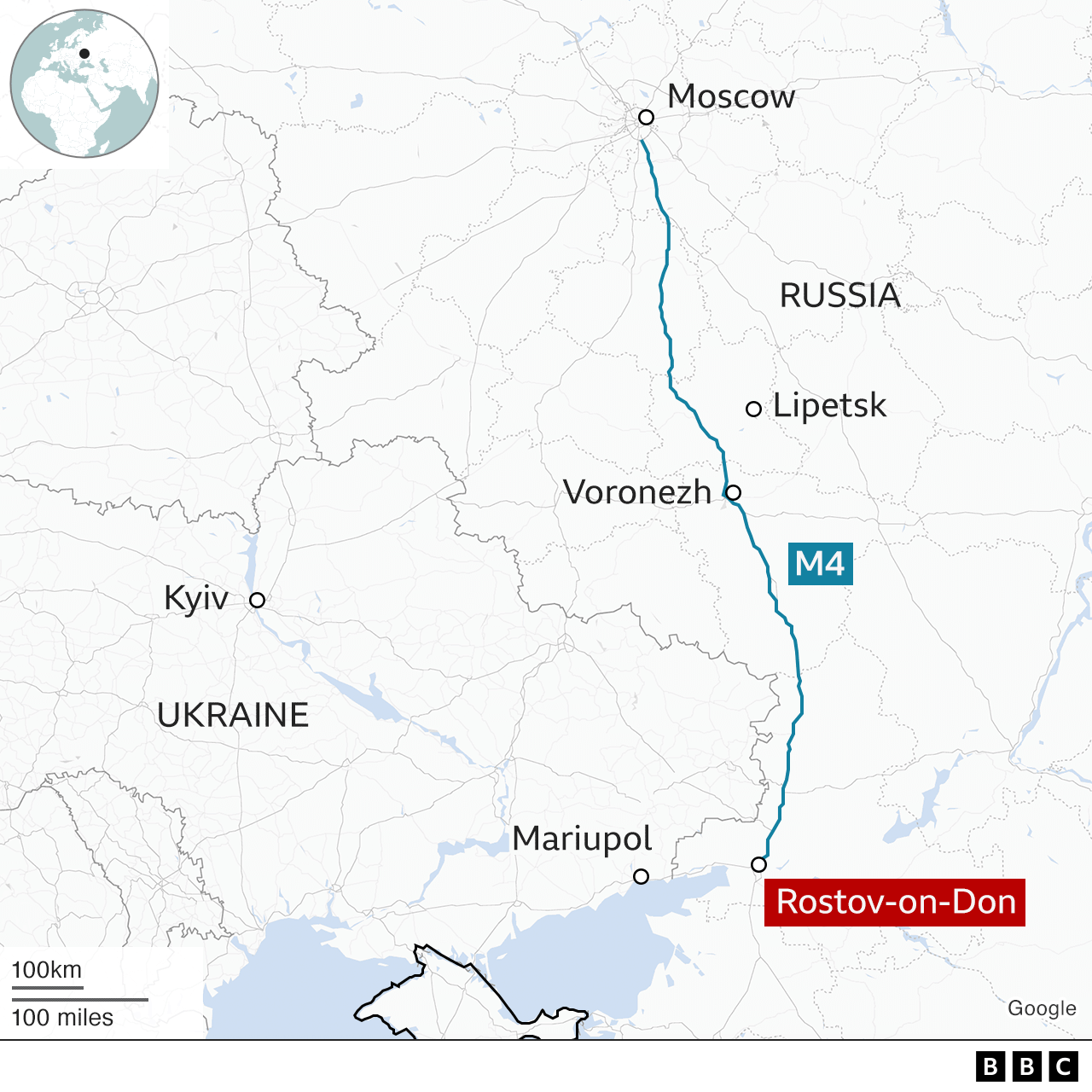
Under the deal, Wagner fighters must return to their field bases and Prigozhin move to Russia’s western neighbour Belarus, whose leader Alexander Lukashenko was involved in the negotiations.
Comment What this shows is that the west has wanted Russian regime change since Putin atopped playing the western lackey in 2011. They have been undermining the Russian State with MI6 playing a key role ever since. Prigozhin made fair comment on Russian command and control. The Putin regime needs to wake up and buckle down if it wants to win. Anglo – U.S led NATO is a devious hypocritical ruthless enemy. Fighting them fairly is like nailing jelly to a wall.

R J Cook
June 24th 2023
- The head of the Wagner group will leave for Belarus and charges against his mercenaries will be dropped following their rebellion, Russian state media says
- Yevgeny Prigozhin told his forces to return to their bases earlier to “avoid bloodshed” after negotiations with Belarusian leader Alexander Lukashenko
- Wagner fighters have begun to leave the southern city of Rostov-on-Don where their mutiny began less than 24 hours ago, according to reports
- Prigozhin had called for a rebellion against the Russian army, and his group had been advancing on Moscow
- President Vladimir Putin decried Prigozhin’s actions as a “betrayal” and “treason” in a TV speech, promising to punish rebels
- Security was tightened in Moscow, and the mayor told residents to avoid travelling. All mass outdoor events have been cancelled until 1 July
Live Reporting
Edited by Jasmine Taylor-Coleman
Get involved
- Send an email to haveyoursay@bbc.co.uk
- Posted at 22:3522:35Wagner chief seen leaving captured city – report
Yevgeny Prigozhin is seen leaving the military headquarter in Rostov-on-DonImage caption: Yevgeny Prigozhin is seen leaving the military headquarter in Rostov-on-DonThe head of the Wagner mercenary group has been pictured by Reuters news agency apparently leaving the city of Rostov-on-Don, which his fighters took control of earlier today.Yevgeny Prigozhin was driving away from the district military headquarters in the city, the agency says.According to Russian state media, Progozhin is to leave Russia for Belarus and all charges against him and his Wagner forces will be dropped by authorities to avoid “bloodshed”.
What happens now?

Frank Gardner
BBC News, Security Correspondent
Even for seasoned Kremlin-watchers, this has been the most extraordinary 24 hours.
One moment Russia looked to be almost on the brink of civil war with Moscow’s most effective ground force, the Wagner group, rebelling in open defiance of the Kremlin.
The next, it all appeared to be over with the renegade mercenary boss Yevgeny Prigozhin backing down and withdrawing his forces after a phone call from the Belarus leader.
What exactly was said in that phone call?
We are not told, but it’s fair to assume that Prigozhin was given some home truths somewhere along the lines of: “Look, you’re on your own here, no one has come out in support for you, and if you continue on this course a lot of blood is going to be spilled, and that’s Russian blood.”
Where does this leave the Wagner group? They have, after all, been a useful arms-length tool for the Kremlin for the past eight years, promoting its interests from Mali to Ukraine with scant regard for human rights.
But it’s hard to see how President Putin could ever again trust his former protege Prigozhin.
He’s accused him of treachery and betrayal and the FSB security forces consider him a criminal.
So expect purges and possibly some reshuffling in the defence ministry. And, meanwhile, the war in Ukraine will likely continue unabated. For the hard-pressed Ukrainian troops on the front line, the intermission is over.
Comment British media manspreading anchor men and moralising posh anchor women, always pretty and condescending ,were orgasmic over their hasty conclusions about Wagner raising an armed rebellion. They thought the war was over so fat cat capitailists could start devouring Russia and killing the ‘Belt & Road’ sane solution to world poverty and climate change.
There was never evidence of such violent intent. Prigozhin had simply been making a point. Shell shocked from battle, he is unhappy with ordnance supplies and strategy. Smug commentators have no interest in how Russia was set up for this war. Western masses are easily diverted from home front miseries and consequences of the rich man’s war they are subsidising. They believe that Putin is coming to take away the freedoms they do not have. Ask Julian Assange about westerm freedoms and democracy,if you can find him. This country is so democratic, this site comes up as insecure thanks to Police State Google.

R J Cook 1955.
June 23rd 2023
Ukraine ‘A Wonderful Investment Opporunity’ by R J Cook
Forget how the Anglo U.S elite run NATO set Russia up for this war, the massive environmental impact, thousands of dead and the consequent absurdly naned ‘cost of living crisis’ aka war profiteering because the war provides a wonderful investment opportunity for the western global elite. That is what a posh Tory Foreign Office Minister told the House of Commons yesterday.
Moreover, Russia is going to be proesecuted for war crimes because the western elite makes the rules and Russia will have to pay the bill. Vladimir Putin is being told what will happen to him. The plan is to humiliate Russia, breaking her pretty much in the same style Germany was blamed fo World War One.Then the rabble rousers in Britain had the slogan ‘Squeeze Germany until the pips squeak.’ World War Two came next . Economist John Maynard Keynes predicted this in his book ‘The Economic Consequences of the Peace’ . I read it when I was 17. Keynes was and still his a hero of mine. But fact cat moronic grabbers and masses know little or anything of his work. And so the money grabbing ruling class of fake democrats will do as they please. AsI have said, I won’t be on the planet for much longer. The only thing I am looking forward to is death. I can’t take any more of what police state U.K has done and is doing to me and my son.

R J Cook 1955.
June 21st 2023
Ukraine war: Zelensky admits slow progress but says offensive is not a movie
Related Topics
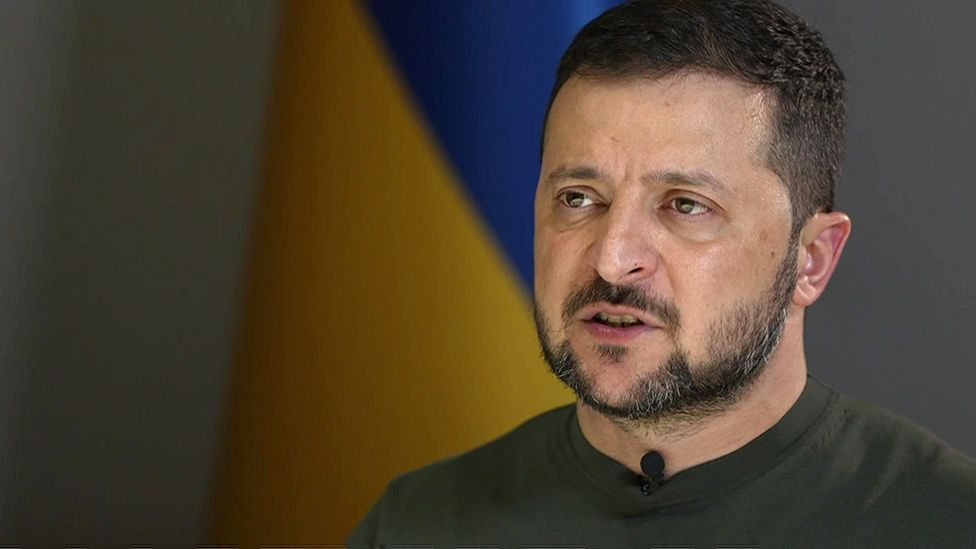
By Yalda Hakim
BBC News
President Volodymyr Zelensky has acknowledged battlefield progress has been “slower than desired”, weeks into Ukraine’s military offensive to recapture areas occupied by Russia.
“Some people believe this is a Hollywood movie and expect results now. It’s not,” he told the BBC.
“What’s at stake is people’s lives.”
Ukraine says its counter-offensive has reclaimed eight villages so far in the southern region of Zaporizhzhia and Donetsk to the east.
Mr Zelensky said the military push was not going easily because 200,000 sq km (77,220 sq miles) of Ukrainian territory had been mined by Russian forces.
“Whatever some might want, including attempts to pressure us, with all due respect, we will advance on the battlefield the way we deem best,” Mr Zelensky added.
He reinforced the need for Ukraine to be given security guarantees from Nato but said ultimately the goal was membership of the defensive alliance.
Nato’s secretary general made clear this week that no plan was on the table to issue an invitation to Ukraine at next month’s summit in Lithuania.
“[Jens] Stoltenberg knows my position,” the Ukrainian leader said “We’ve told them numerous times: ‘Don’t knock the ground from under our feet.'”
The Ukrainian leader again made the case for Ukraine to receive US-made F-16s and said he believed fighter pilots could start training as soon as August, and that the first jets could arrive in six or seven months’ time.
Mr Zelensky was speaking to the BBC to mark a Ukraine Recovery Conference in London focusing on the role the private sector can play in rebuilding his country. He later spoke at the conference, along with UK PM Rishi Sunak.
Ukraine’s economy shrank by 29.2% in 2022 and earlier this year the World Bank estimated the cost of reconstruction and recovery at $411bn (£339bn).
The Ukrainian leader told the BBC that the support he needed was not just for recovery but for transformation as well.
He said “quick steps” to be done immediately included finding places for people to live, rebuilding the destroyed Kakhovka dam and decentralising the energy network.
“But on the larger scale we are speaking about the transformation of Ukraine,” he explained. “This is Ukraine not only with its energy and agriculture and industrial complexes, but with its reforms we can see.”
He spoke of “the digitilisation of Ukraine” as well as judicial and anti-corruption reforms.
When I asked him what the endgame of the war looked like at this stage, he made clear that “victories on the battlefield are necessary” and that Ukraine would never sit down with whoever was president in Moscow, if Russia remained on Ukraine’s territory.
“No matter how far we advance in our counter-offensive, we will not agree to a frozen conflict because that is war, that is a prospectless development for Ukraine.”
Russia announced a few days ago that it had moved tactical nuclear weapons to Belarus and President Joe Biden has warned that the threat of Vladimir Putin using them is real.
So I asked Mr Zelensky if he was worried by that threat.
“Putin has been dangerous for us since 2014 when he occupied the first of our territories,” he said.
“He will talk about the use of nuclear weapons, I don’t think he is ready to do it because he is scared for his life, he loves it a lot. But there is no way I could say for sure, especially about a person with no ties to reality, who in the 21st Century, launched a full-scale war against their neighbour.”
I also asked for his reaction to President Putin telling an international conference in St Petersburg last week that he was a disgrace to the Jewish people. Mr Zelensky lost many of his relatives in the Holocaust, including his grandfather, and it was clear that he was taken by surprise by the question.
He took a deep breath, put his head down and a few seconds later said he wasn’t quite sure how to answer the question.
“It’s like he doesn’t fully understand his words. Apologies, but it’s like he is the second king of antisemitism after Hitler.
“This is a president speaking. A civilised world cannot speak that way. But it was important for me to hear the reaction of the world and I am grateful for the support.”
Could Russia really play nuclear roulette in Ukraine?
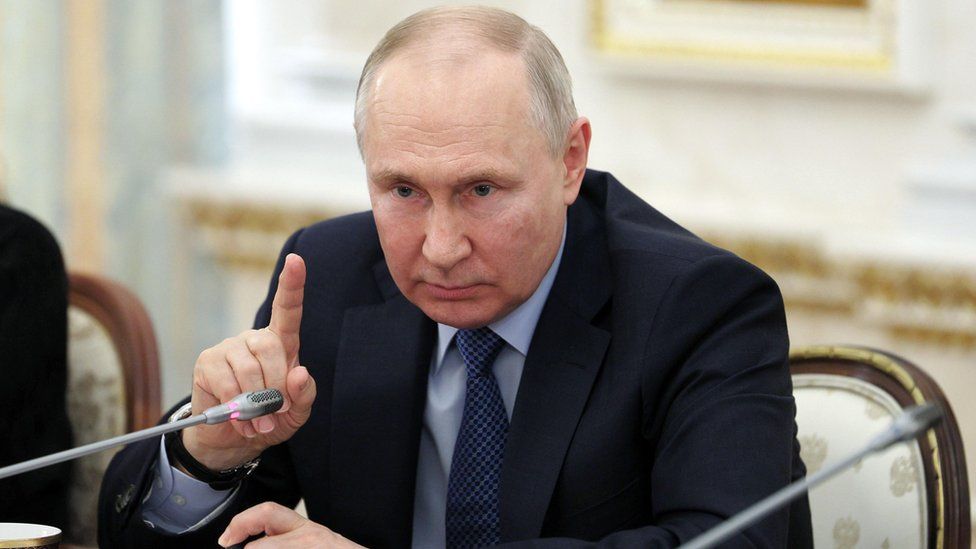
By Steve Rosenberg
Russia Editor, Moscow
It’s the question we’ve been asking ever since President Vladimir Putin ordered the full-scale Russian invasion of Ukraine. In this war, would the Kremlin go nuclear?
President Joe Biden isn’t ruling it out.
“I worry about Putin using tactical nuclear weapons,” the US president said this week. He believes the danger is “real”.
I don’t know whether President Biden reads the Russian magazine Profile. If he does, you can understand why he’s worried.
- Putin confirms first nuclear weapons moved to Belarus
- Zelensky admits slow progress in Ukraine offensive
- Could Russia use tactical nuclear weapons?
Last week, Profile published an article by prominent Russian foreign and defence policy expert Sergei Karaganov. The hawkish Mr Karaganov is honorary chairman of the Presidium of the Council on Foreign and Defence Policy. In short, he’s well-connected to those in power here.
His argument goes like this. In order to “break the West’s will”, Russia “will have to make nuclear deterrence a convincing argument again by lowering the threshold for the use of nuclear weapons”.
“The enemy must know that we are ready to deliver a pre-emptive strike in retaliation for all of its current and past acts of aggression in order to prevent a slide into global thermonuclear war.
“But what if they do not back down? In this case, we will have to hit a bunch of targets in a number of countries in order to bring those who have lost their mind to reason.”
Since last year, we’ve grown used to nuclear sabre-rattling from Moscow.
And President Putin has confirmed that Russia has already stationed a first batch of tactical nuclear weapons in Belarus, a move the Russian leader says is designed to remind anyone “thinking of inflicting a strategic defeat on us”.
But arguing the pluses of a pre-emptive nuclear strike on the West? That’s a whole new level.
Clearly, not everyone in Russia is on board with such an idea.
Today’s edition of the business daily Kommersant features an article entitled “Nuclear War is a bad way of resolving problems”.
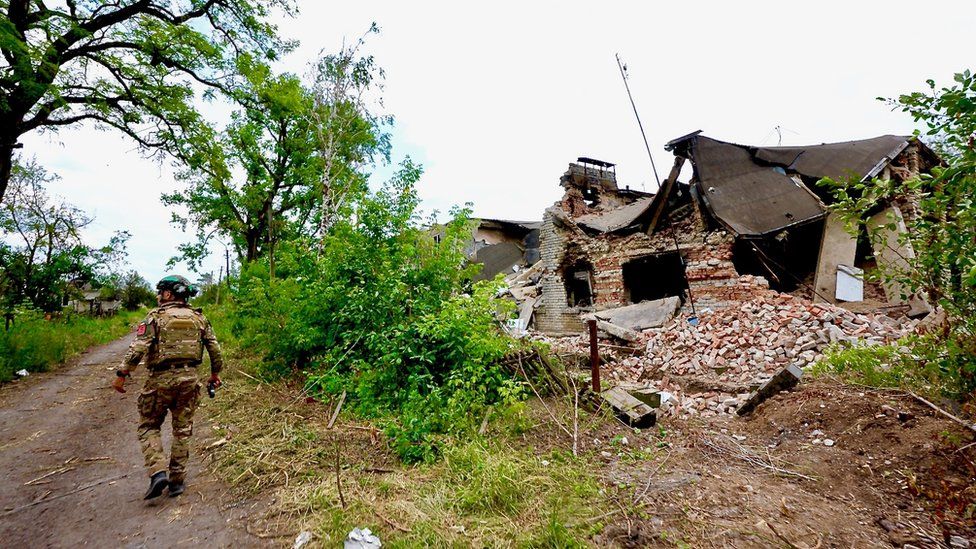
Understatement of all time, maybe. But what’s fascinating about this piece is that it suggests the debate in Russia about when or whether to use nuclear weapons in the war in Ukraine has burst into the public domain. And the hawks don’t have it all their way.
Penned by another group of Moscow-based foreign and defence policy experts, the Kommersant article explains why they believe Sergei Karaganov has got it wrong. Dangerously wrong.
“The idea that the use of nuclear weapons can halt escalation and resolve strategic problems that conventional military means have failed to is extremely dubious and, most likely, mistaken,” write Alexei Arbatov, Konstantin Bogdanov and Dmitry Stefanovich from the Centre for International Security – part of a think tank within the Russian Academy of Science.
“In modern history, there are many examples of military operations leading to unforeseen consequences. But these were without nuclear weapons being used. A nuclear strike would raise the conflict to a whole new level of unpredictability and raise the stakes of confrontation many times over.
“The radioactive ruins that playing ‘nuclear roulette’ would most likely lead to are the worst foundation for a bright future. Fans of sensationalist ideas and dangerous gambling would be best to remember that.”
Which brings us to another question we’ve been asking since the start of Russia’s war in Ukraine: what on Earth is going on?
It’s possible that Mr Karaganov’s proposal for a pre-emptive nuclear strike was so shocking that other Russian academics felt they just couldn’t stay silent.
If so, it shows that although the Russian media landscape is now heavily controlled by the state, even within current confines, there is still room on some platforms for limited debate and discussion on certain topics. Especially such crucial topics as nuclear war.
Or it may be that this whole debate is designed to grab the West’s attention, to make President Putin look like good cop to Mr Karaganov’s bad cop.
After all, the Kremlin leader himself hasn’t called for a pre-emptive nuclear strike on the West. And so – the argument goes – better sit down and make peace with him, before hardliner Karaganovites win the day and press the nuclear button.
One thing’s clear: with anti-Western rhetoric in Russia rising, and with the Ukrainian army’s counter-offensive under way, the nuclear question isn’t going away.
June 20th 2023
Hunter Biden to plead guilty to tax crimes and admit gun offence
- Published
- 1 hour ago

By Bernd Debusmann Jr
BBC News, Washington
US President Joe Biden’s son, Hunter Biden, is expected to plead guilty to two misdemeanour tax crimes and admit to illegally possessing a gun while a drug user, after a five-year investigation.
The US Attorney in Delaware has filed papers indicating a plea agreement has been reached.
He is expected to agree to drug treatment and monitoring.
The terms of the agreement are likely to keep him out of jail.
In theory, he still faces a maximum penalty of a year in prison on each of the tax charges and 10 years in prison on the gun charge, the justice department said in a statement. The proposed deal would need to be approved by the judge in the case, who will also determine the sentence.
It is unclear when Hunter Biden will appear in court to enter his guilty plea on the tax charges.
He will admit to felony gun possession as part of a “pre-trial diversion agreement” that is separate from the plea deal, his lawyer Chris Clark said in a statement.
“I know Hunter believes it is important to take responsibility for these mistakes he made during a period of turmoil and addiction in his life,” Mr Clark added. “He looks forward to continuing his recovery and moving forward.”
Hunter Biden, 53, has previously worked as a lawyer, and a lobbyist including abroad in China and Ukraine. He was discharged from the US Navy in 2014 after testing positive for cocaine.
The plea deal brings to an end a long-running justice department investigation into whether he properly reported his income and made false statements on paperwork used to purchase a firearm in 2018.
The two misdemeanour tax charges stem from a failure to pay more than $100,000 in taxes in both 2017 and 2018.
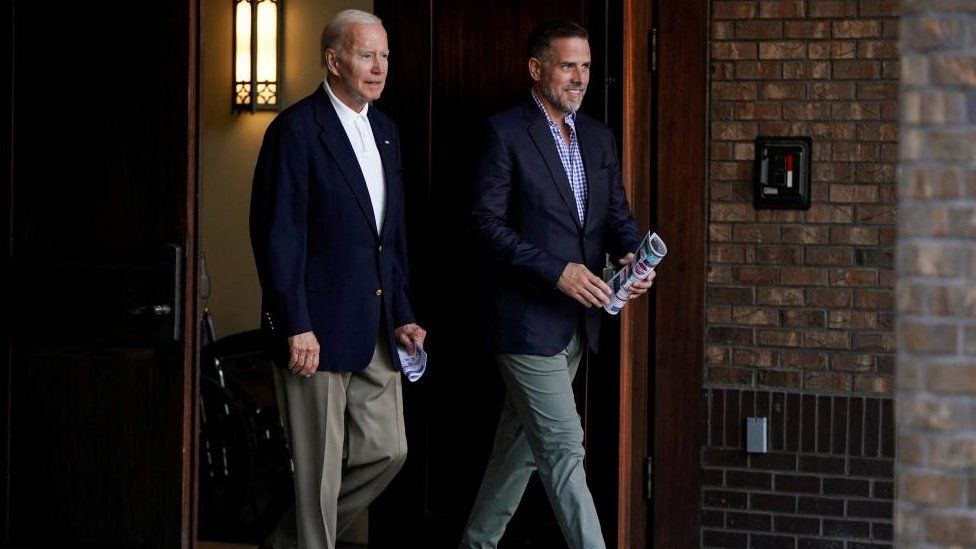
The gun charge stems from a 2018 possession of a firearm while a drug user.
In a 2021 book, the younger Mr Biden admitted to being a heavy user of crack cocaine at that time.
But he reportedly said “no” on a federal form asking if he was “an unlawful user of, or addicted to, marijuana or any depressant, stimulant, narcotic drug or any other controlled substance”.
The deal comes as some Republican lawmakers and presidential candidates have accused Joe Biden of “weaponising” the justice department against political opponents.
Hunter Biden has long been a target of scrutiny from conservatives, who have alleged that his dealings overseas indicate a pattern of corruption.
News of the plea deal was met with swift and strong criticism from Donald Trump and his campaign, as well as senior congressional Republicans.
Karoline Leavitt, a spokeswoman for the pro-Trump Make America Great Again Inc, called the agreement a “sweetheart deal” that allows the justice department to “turn a blind eye” to corruption. Mr Trump, for his part, called the deal a “mere traffic ticket”.
House majority leader Kevin McCarthy told reporters on Capitol Hill that the deal was evidence of a “two-tier” system of justice and vowed that the case would “enhance” a separate Republican investigation into Hunter Biden.
Prominent Democrats have remained largely quiet on the case. David Brock, a former right-wing investigative reporter turned pro-Democrat operative, said in a statement that the case should now be considered closed since “Hunter will not be charged with any of the unfounded and outlandish issues Republicans and right-wing media have used to smear him with for years”.
In a brief statement, the White House also said that Joe Biden and First Lady Jill Biden “love their son and support him as he continues to rebuild his life. We will have no further comment”.
While the younger Mr Biden has detailed a troubled life and “massive drug addiction”, he long denied engaging in illegal activity.
He first admitted knowledge of an investigation into him in December 2020.
In a statement at the time, he said that he was “confident that a professional and objective review of these matters will demonstrate that I handled my affairs legally and appropriately, with the benefit of professional tax advisers”.
The justice department statement said that the investigation is “ongoing”.
Trump’s call for ‘termination’ of constitution condemned
- Published
- 4 December 2022
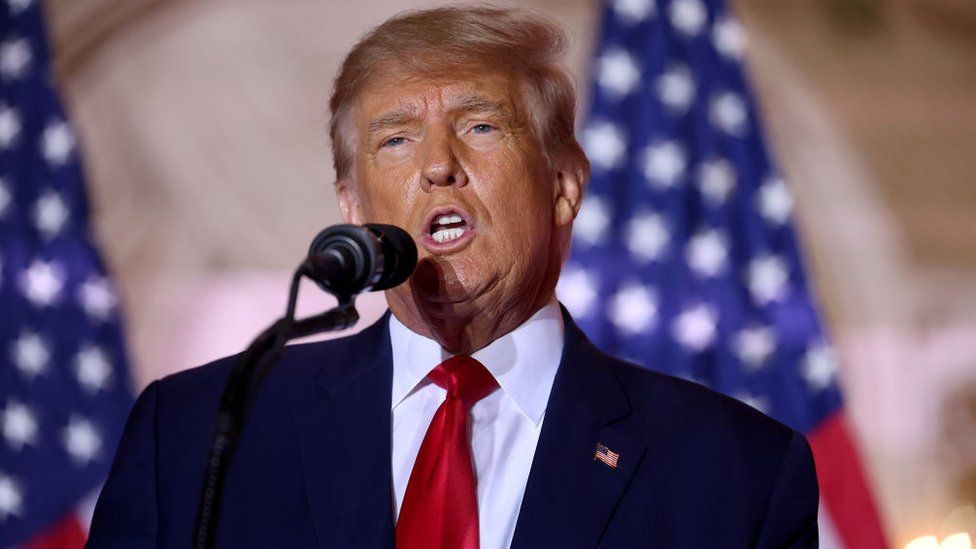
By Matt Murphy
BBC News
The White House has condemned former President Donald Trump after he called for the “termination” of the US constitution.
Mr Trump made the comments in a post to his Truth Social account on Saturday while repeating his false claim that he won the 2020 presidential election.
He also accused “Big Tech Companies” of colluding against him with Democrats.
White House spokesman Andrew Bates said Mr Trump’s comments were “anathema to the soul of our nation”.
“You cannot only love America when you win,” Mr Bates said in a statement.
He added that Mr Trump’s comments should be “universally condemned” – seemingly a pointed jab at senior Republicans who have so far avoided criticising the former president’s outburst.
Other senior Democrats also challenged Republicans – including Rep Eric Swalwell who questioned how the party’s members could continue to refer to themselves as “Constitutional conservatives” if they didn’t condemn the comments.
In the post, Mr Trump referred to vague allegations of “massive & widespread fraud and deception” and asked whether he should be immediately returned to power.
“A Massive Fraud of this type and magnitude allows for the termination of all rules, regulations, and articles, even those found in the Constitution. Our great ‘Founders’ did not want, and would not condone, False & Fraudulent Elections!” he said.
The post came just hours after Twitter’s internal deliberations around limiting a 2020 story about Hunter Biden were revealed.
The story, which came weeks ahead of the 2020 presidential election, was published by the New York Post and revealed the chaotic personal life and business dealings of President Joe Biden’s youngest son.
Twitter initially blocked the story because of a company policy on hacked and stolen materials, and the leaked emails showed confusion and disagreements among staff as they scrambled to respond.
The files – which the BBC cannot verify – were published on Twitter by Substack writer Matt Taibbi on Friday night.
But last week, Twitter owner Elon Musk hinted that he would release the information, writing on the platform: “This is necessary to restore public trust.”
The billionaire defended the move in a Twitter spaces live stream on Saturday, but he accepted there may be a “legal risk” to his decision.
“We’re just going to put all the information out there try to get a clean slate,” Mr Musk said. He added that legal risks were “less of a concern than just clearing the air and making sure that people know what really happened”.
Mr Trump announced his third presidential bid last month and is a frontrunner to seal the Republican nomination in 2024.
But he has come under fire this week after dining with a known white nationalist and Holocaust denier at his Florida home.
Mr Trump said he was not aware that the man would be present and said he had accompanied the rapper Kanye West – who earlier this week expressed admiration for Adolf Hitler and has been accused of a host of antisemitic comments.
Related Topics
June 18th 2023
| Long before Russia’s invasion, NATO states were divided over whether to offer membership to Ukraine. They still are, even as the alliance rallies to Kyiv’s defense in the war.Division is what Russian President Vladimir Putin wants, according to eastern European states who argue Ukraine should be given a clear path to joining the North Atlantic Treaty Organization at its summit in Vilnius next month.Others maintain that’s impossible while the war is raging, because it risks dragging NATO into a direct fight with Russia, something both sides have avoided so far.Key Reading: NATO Allies Seek to Resolve Divisions on Ukraine Membership Kissinger Says Putin Survival ‘Improbable’ If Ukraine Prevails F-16 Planes Are a Message to Putin: NATO Support Isn’t Waning Russia Still Top US Uranium Supplier Despite Efforts to Wean Off Follow our Ukraine Recap for the latest coverage of the war.Ukraine as a NATO member would be entitled to invoke the Article 5 guarantee of mutual defense, they say, triggering a wider European war.At a summit in 2008 when NATO first offered to admit Ukraine and Georgia one day, the deliberately vague pledge reflected fears of provoking Putin. He invaded Georgia months later anyway.Now he has triggered Europe’s biggest conflict since World War II in Ukraine, and expanded NATO’s border with Russia by prompting Finland and Sweden to seek membership.  Ukraine may get bilateral security assurances from some NATO states in the Lithuanian capital to help strengthen its army on the battlefield.Former US Secretary of State Henry Kissinger in his June 7 Bloomberg interview described Putin’s actions over European military expansion as “at the edge of irrationality.” It’s “improbable” the Kremlin leader will survive in power if the war forces Russia to accept a peace deal and abandon military aggression toward Europe, he said.Putin’s war reinvigorated NATO after years in which some wondered whether it any longer had a purpose. In seeking to drive it away, he’s brought it closer to home.Early in his presidency, Putin expressed interest in joining NATO. It would be ironic if his rule ended because Russia finally learned to live at ease with the bloc. Ukraine may get bilateral security assurances from some NATO states in the Lithuanian capital to help strengthen its army on the battlefield.Former US Secretary of State Henry Kissinger in his June 7 Bloomberg interview described Putin’s actions over European military expansion as “at the edge of irrationality.” It’s “improbable” the Kremlin leader will survive in power if the war forces Russia to accept a peace deal and abandon military aggression toward Europe, he said.Putin’s war reinvigorated NATO after years in which some wondered whether it any longer had a purpose. In seeking to drive it away, he’s brought it closer to home.Early in his presidency, Putin expressed interest in joining NATO. It would be ironic if his rule ended because Russia finally learned to live at ease with the bloc. |
 Ukrainian servicemen help a disabled resident during an evacuation from a flooded area in Kherson on June 8. Photographer: Genya Savilov/AFP/Getty ImagesSign up for our twice-weekly newsletter Next Africa. And if you are enjoying this newsletter, sign up here. Ukrainian servicemen help a disabled resident during an evacuation from a flooded area in Kherson on June 8. Photographer: Genya Savilov/AFP/Getty ImagesSign up for our twice-weekly newsletter Next Africa. And if you are enjoying this newsletter, sign up here. |
| Global Headlines |
President Xi Jinping’s meeting with American billionaire Bill Gates today raised expectations that the Chinese leader may receive US Secretary of State Antony Blinken, who’s set to start a two-day visit to Beijing on Sunday in a bid to reset ties between the world’s largest economies. Xi told Gates that China is willing to work with the world on technology innovation and global challenges including pandemic prevention.The US sent a nuclear-powered, guided-missile submarine to South Korea for the first time in six years in a show of force meant to deter North Korea from military strikes. The visit comes after President Yoon Suk Yeol won assurances during a summit with President Joe Biden in April to strengthen extended deterrence measures, including more regular deployments of nuclear-armed submarines.The national security advisers of the US, Japan and the Philippines agreed to bolster defense cooperation at the first trilateral meeting of its type. There’s growing concern that this year’s COP28 climate talks won’t take aggressive action to slash carbon emissions and boost financing for developing nations. After two weeks of preparatory negotiations, delegates said inter-country bickering and what some called a lack of ambition from the host, the United Arab Emirates, dampened hopes for strong moves to address global warming at the November summit in Dubai.The US and Iran are nearing an informal understanding in which Tehran would free American prisoners and eventually limit its nuclear program, while the US would release payments owed to the Islamic Republic that were frozen by sanctions, sources say. Jonathan Tirone and Annmarie Hordern report on the negotiations through intermediaries in Oman and on the sidelines of United Nations meetings. There’s growing concern that this year’s COP28 climate talks won’t take aggressive action to slash carbon emissions and boost financing for developing nations. After two weeks of preparatory negotiations, delegates said inter-country bickering and what some called a lack of ambition from the host, the United Arab Emirates, dampened hopes for strong moves to address global warming at the November summit in Dubai.The US and Iran are nearing an informal understanding in which Tehran would free American prisoners and eventually limit its nuclear program, while the US would release payments owed to the Islamic Republic that were frozen by sanctions, sources say. Jonathan Tirone and Annmarie Hordern report on the negotiations through intermediaries in Oman and on the sidelines of United Nations meetings. |
| Best of Bloomberg Opinion |
China Had Better Listen to What Blinken Has to Say: Minxin Pei US Should Look South, Not Far East, on Trade: Shannon O’Neil Brazil’s Economy Is Even Better Than It Looks: JP SpinettoAfrica’s richest city was built on gold, but it’s now defined increasingly by chaos, crime and corruption. Constant power cuts force schools, hospitals, restaurants and businesses in Johannesburg to rely on backup generators to keep running, while homeless people guide vehicles through potholed streets for cash, S’thembile Cele writes. It is symbolic of the collapse of basic services across the nation. A collapsed bridge embankment in downtown Johannesburg on May 23. Photographer: Leon Sadiki/Bloomberg A collapsed bridge embankment in downtown Johannesburg on May 23. Photographer: Leon Sadiki/Bloomberg |
| Explainers You Can Use |
| Trump Tests Out Defense Strategies in Top-Secret Documents Case Nigeria’s New Leader Thrills Investors With Reforms and Firings Why Slow-Burn Pension Crisis Is Getting Harder to FixJapan passed a landmark sex-crime bill today to make a range of sexual offenses, including rape, photo voyeurism and online child-grooming, more easily punishable. The amendments to the Penal Code change the term for the crime of “forced sexual intercourse” to “non-consensual sexual intercourse,” widening the scope of cases that can be treated as an offense, and raise the age of consent to 16 from 13.Tune in to Bloomberg TV’s Balance of Power at 5pm to 6pm ET weekdays with Washington correspondents Annmarie Hordern and Joe Mathieu. You can watch and listen on Bloomberg channels and online here. |
| News to Note |
Japanese Prime Minister Fumio Kishida said he’s not thinking of dissolving parliament during the current session, cooling speculation he could call an early election as soon as next month. Putin held talks with the leader of the UAE at a flagship business forum today, bolstering the Kremlin’s efforts to ease its international isolation over the war in Ukraine. The European Commission is increasing the pressure on member nations to stop using Huawei and ZTE equipment as part of an effort to crack down on Chinese equipment in critical infrastructure. A month after Thailand’s pro-democracy parties won the election that ended nearly a decade of military-backed rule, hurdles are mounting for the coalition and its prime minister candidate Pita Limjaroenrat to take power. Peruvian President Dina Boluarte said she plans to stay in power until 2026, her first explicit statement on the issue since congress rejected her proposal to bring elections forward to this year.Pop quiz (no cheating!) Which country may finalize a deal with the US as early as next week to jointly manufacture fighter-jet engines? Send your answers to balancepower@bloomberg.net.And finally … For half a century, the Soviet Union used a spy base in Cuba to steal US military secrets by listening in on phone and data communications. Twenty years after the post was shut down, Beijing may be picking up where Moscow left off. While the Chinese foreign ministry has denied it’s using Havana to listen in on Washington, the question may add to the list of concerns ahead of Blinken’s visit to Beijing. Russia’s listening station 18 miles outside of Havana in 2001. Source: Getty Images Russia’s listening station 18 miles outside of Havana in 2001. Source: Getty Images |
June 16th 2023
Ukraine war: The challenges of training F-16 pilots
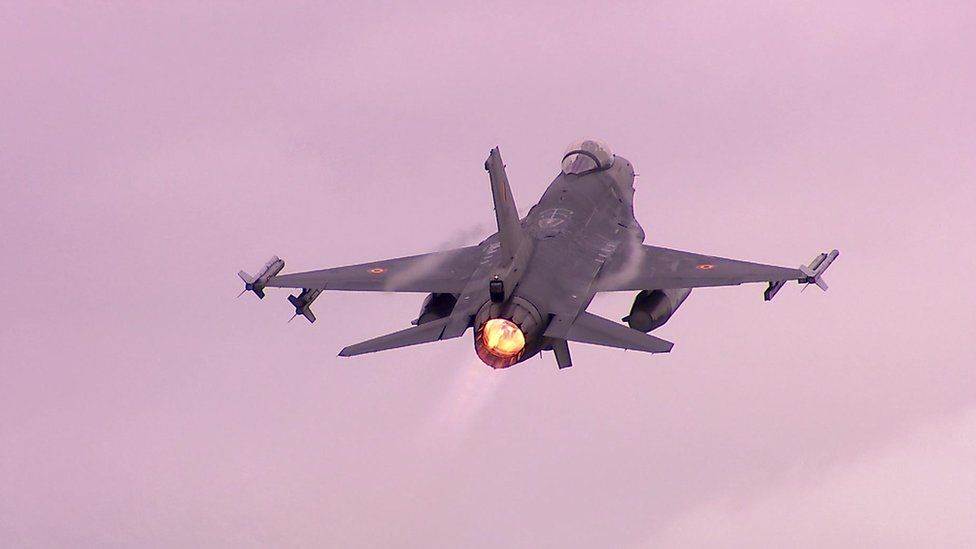
By Jonathan Beale
Defence correspondent, Norway
Western allies are set to announce their plans to train Ukrainian pilots to fly US-made F-16s when they meet in Brussels today. But it’s still not clear which countries will be willing to provide the jets, how many, or even when.
Supplying Ukraine with F-16 fighter jets will “not be a silver bullet” or a “quick fix”, says the head of Norway’s Air Force. Maj Gen Rolf Folland says it’ll take time for Ukraine to develop the ability to operate Western jets with complex weapons.
We meet at a large allied air exercise taking place over Norway, Finland and Sweden. It involves 150 fighter planes – many more than the entire Ukrainian Air Force.
Gen Folland says the training is about dominating the skies – to avoid what he calls the type of “old fashioned” conflict now taking place in Ukraine.
To gain supremacy of the air requires a level of scale and sophistication that Ukraine will not be able to replicate. Even providing a small fleet of F-16s could prove a major challenge.
It took Pulse, a Belgian pilot, three years to master his F-16 fighter. We’ve been asked to use his call sign, not his real name.
He shows us round his F-16, originally designed in the late 1970s, long before he was born.
“It flies like a dream”, he says. “But flying is the easiest part. The rest is more difficult.”
BBC
Flying is the easy part. The rest is more difficult
Pulse
Belgian fighter pilot
That includes learning to operate the F-16’s radar, sensors and weapons. Ukraine, which currently has more pilots than aircraft, is hoping to compress that training into months.
Pulse sees the logic of providing Western jets to Ukraine. He points to his F-16’s weapons: air-to-air missiles to destroy enemy aircraft, and bombs to hit targets on the ground. “That’s important,” says Pulse, “because you can use any weapons from Nato stocks with this jet.”
But then there’s the question of maintaining the jets.
The Norwegian Air Force, like others in Europe, has transitioned to the more modern F-35. So in theory there should be F-16s available for Ukraine.
At Orland air base they use two of their old F-16s to train aircraft engineers. That can take a year – even longer for a senior aircraft technician.
“You can’t just hand over a fighter aircraft and say off you go!” Col Martin Tesli, the base commander and a former F-16 pilot, says.
He says there’s a large logistical tail – spare parts, software and weapons. But he too understands the need to modernise Ukraine’s fleet of old Soviet-era jets.
“At a certain point, if they’re not provided with another aircraft, they won’t have an air force to defend themselves.”
BBC
You can’t just hand over a fighter aircraft and say off you go!
Col Martin Tesli
Orland air base commander
Justin Bronk of the Royal United Services Institute says Ukraine would probably need the help of Western contractors to keep any F-16s flying. The obvious question, is what country is willing to accept the obvious risks of putting their own people on the ground?
Professor Bronk adds that Russia is only more likely to target Ukraine’s air bases if it’s supplied with Western jets. That’s a danger for the single engine F-16, which has a large intake that can suck up debris from the runway.
These are good reasons why the US has, for so long, resisted pressure from Ukraine to provide F-16s. It’s less about fears of escalation, and more about the practicalities of operating and maintaining the jets. The Pentagon has warned it’ll be both complex and costly.
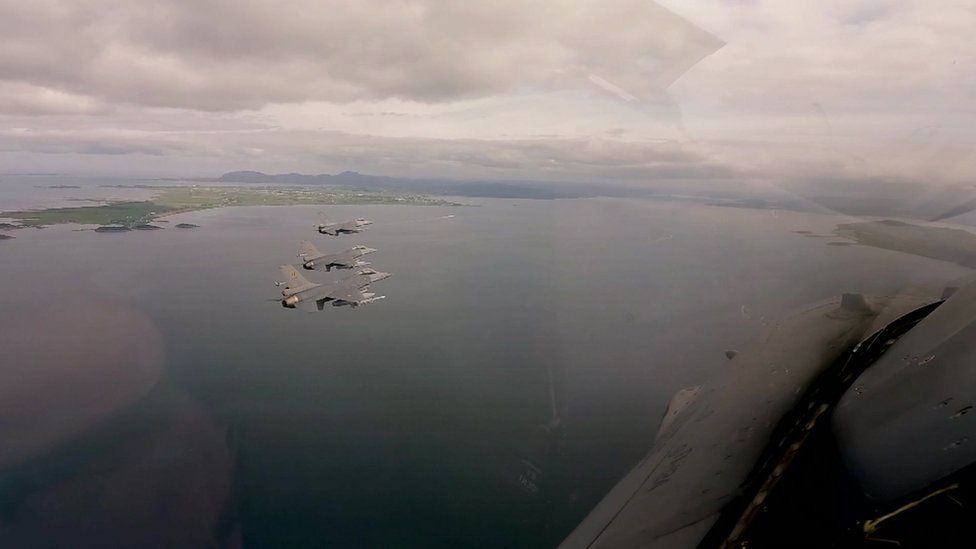
Nor is providing Ukraine with Western fighters likely to significantly alter the battle on the ground.
Lt Col Neils Van Hussen, a former F-16 pilot of the Royal Netherlands Air Force, says “not a single weapons system will change a big war”. F-16s, he believes, would simply give Ukraine “the ability to sustain what they’re doing now”.
The reality of this war is that even Russia, with its sizeable air force, has not been able to dominate the skies. Ground-based air defence systems are helping to prevent that from happening.
Providing Ukraine with more air defences will continue to be the immediate priority for the West. Rebuilding its air force is a longer term goal.
Russian nuclear weapons ‘in hands of Belarus dictator’, warns opposition leader
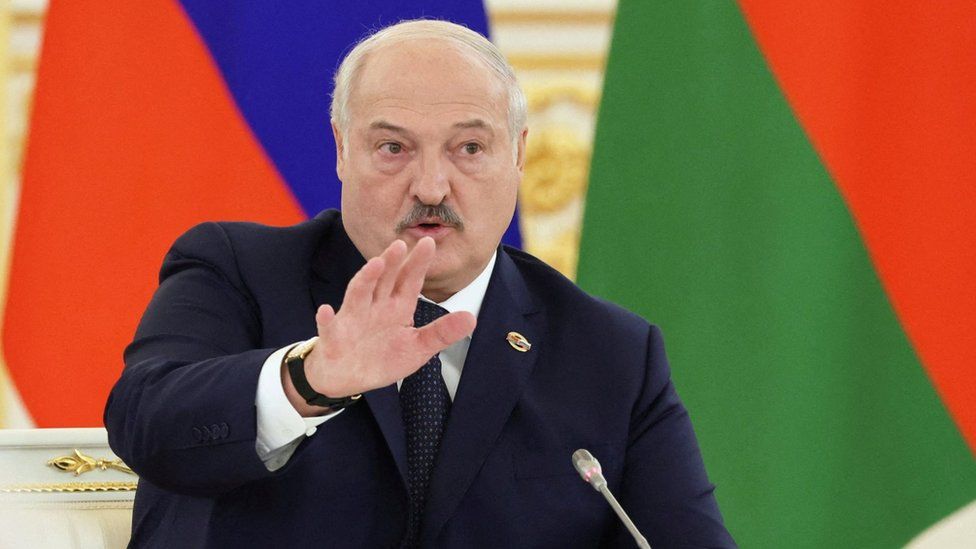
By Sarah Rainsford
BBC Eastern Europe correspondent, Warsaw
Exiled Belarusian opposition leader Svetlana Tikhanovskaya has warned of the danger of transferring nuclear weapons from Russia into “the hands of a crazy dictator” in Belarus, after Alexander Lukashenko confirmed that the first “missiles and bombs” had arrived in the country.
Ms Tikhanovskaya, who was speaking to the BBC in Warsaw, accused Western politicians of “staying silent” about the first deployment of tactical nuclear weapons outside of Russia since the collapse of the USSR in 1991.
Mr Lukashenko, the authoritarian leader of Belarus, made his announcement in a staged discussion with a Russian state TV presenter, conducted somewhere in the Belarusian countryside with military trucks and hardware placed carefully in the background.
When the presenter asked him to clarify his statement – that Belarus has already received the weapons, sooner than expected – Mr Lukashenko chuckled, like the two were sharing a joke. “Not all of them. Gradually,” he said.
Mr Lukashenko is seen as Russia’s key ally, with Belarus serving as a launchpad for President Vladimir Putin’s full-scale invasion of Ukraine in February 2022.
In comments clearly intended to rattle Ukraine’s allies in the West, Mr Lukashenko stressed that the Russian bombs were “three times more powerful” than those dropped by the US on Nagasaki and Hiroshima in World War Two.
He added that he had not simply asked Russian President Vladimir Putin for the nuclear weapons.
“I demanded them back,” he said, claiming that he needed them for protection from external aggression – a false threat he also uses to justify his repression of all political opposition.
Mr Lukashenko – who has been in power since 1994 – claimed victory in disputed elections in 2020, triggering mass protests and a brutal crackdown by the Belarusian KGB security service and riot police.

Belarus, like Ukraine and Kazakhstan, gave up its nuclear arsenal in the 1990s in return for security guarantees from post-Soviet Russia and the West. That makes this a significant reversal, although there is as yet no proof that the Russian weapons have been delivered.
Mr Putin first announced the transfer in March, pointing out that the US has deployed similar weapons in Europe. He later said the move would only take place when storage sites had been prepared, but Alexander Lukashenko now says Belarus has “more storage sites than village dogs” and several have already been renovated.
Moscow says it will retain control of the missiles, which are tactical – not longer-range strategic weapons.
“I am not planning to fight the US… tactical weapons are fine,” Mr Lukashenko said. “And the Iskander [rocket] travels 500 kilometres (310 miles) or more.”
“This deployment creates no new threat to Nato countries, so they don’t take it seriously,”Ms Tikhanovskaya argued, believing that Western countries see no difference between a missile fired from Russia or from Belarus.
Russia already has nuclear weapons in its western-most Kaliningrad region, putting Poland and the Baltic states well within range.
“But Belarus is our country and we don’t want nuclear weapons,” Ms Tikhanovskaya said. “This is like the last step to keeping our independence. And they [in the West] are staying silent about that.”
Ukraine war: ‘Extremely fierce battles’ as Kyiv seeks to advance
Air raid alert issued in Kyiv as African leaders arrive
As African leaders arrive in the Ukrainian capital Kyiv to meet with Zelensky, an air raid alert was issued in the city and the region.
The alert came after the Ukrainian air force said several Russian Kalibr missiles had been launched from the Black Sea and were “heading north” towards Kyiv.
Russian missile attacks ramped up this week on Kyiv, Odesa, and President Zelensky’s hometown of Kryvyi Rih, killing several people.
Olexander Scherba, a Ukrainian diplomat has tweeted: “Sirens now. Putin welcoming African leaders in Kyiv.”
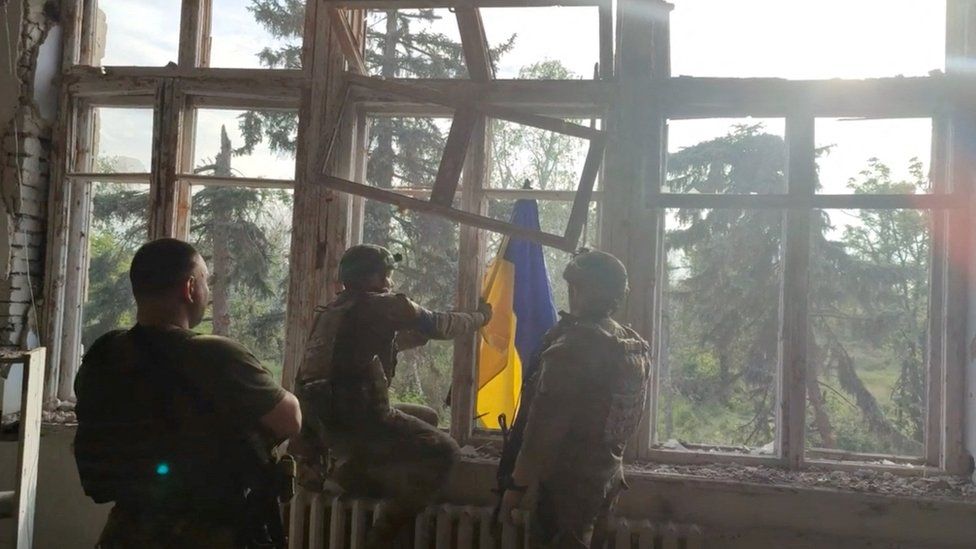
By Matt Murphy & James Lansdale, diplomatic correspondent
BBC News
“Extremely fierce battles” are raging in parts of Ukraine as Kyiv’s forces continue their counter-offensive, the country’s deputy defence minister says.
Hanna Maliar wrote on Telegram that Ukrainian forces had managed to advance near Bakhmut in the east and Zaporizhzhia in the south.
But she conceded Russian forces were mounting a stiff defence in some areas.
Her comments come after another night of Russian missile and drones strikes on cities across Ukraine.
Russia has stepped up its bombing campaign in recent weeks, despite President Vladimir Putin admitting that his forces are suffering from a shortage of missiles and drones.
In the early hours of Thursday morning, overnight attacks hit industrial facilities in the Dnipropetrovsk region, according to Ukraine’s army. Regional military spokesperson Serhiy Bratchuk said a series of drone attacks on the Black Sea region of Odesa were repelled by air defence systems.
The previous day, a strike on a warehouse and a shopping centre in the city of Odesa had killed three people.
Kyiv’s much-anticipated advance has been long in the making, and Ukrainian officials have accused Russia of increasing strikes in recent weeks to deflect attention from the offensive.
The Ukrainians say their troops have recaptured seven settlements and at least 90 sq km (35 sq miles) since starting their counter-offensive.
Ms Maliar wrote on Telegram that Ukrainian troops had advanced around the city of Bakhmut, long the centre of a grinding and bloody street-by-street battle with Russian forces.
She said soldiers advanced by 200m to 500m towards the city, as well as advancing 300m to 500m in the southern Zaporizhzhia province. The BBC cannot independently verify these claims.
But she conceded that the counter-offensive had already led to some “extremely fierce battles”, as Ukrainian forces try to break through well-established Russian defensive lines.
Senior Western officials have warned against the idea that Russian forces will simply “melt away” in the face of Ukrainian attacks, adding that Kyiv’s gains had already been “costly”.
“Russian forces have generally put up a good defence from their well-prepared, defended positions and had been falling back between tactical lines,” the sources said.
“This ‘manoeuvre defence approach’ is proving challenging for the Ukrainians and also costly to attacking forces. Hence, the advance at the moment has been slow,” they observed, adding that it was too soon to say how effective Ukraine’s offensive has been.
- Valery Zaluzhny, the man behind Ukraine’s counter-offensive
- Inside one of the villages freed from Russian forces
- What will it take for military push to succeed?
But they emphasised that heavy losses were to be expected, given Russia has had months to prepare defensive lines.
“This was never going to be without risk,” they said. “What we’re seeing is not unexpected. It’s difficult, and it is going to be challenging for Ukrainians. What we have seen, though, is they’ve continued to push through where they have had losses, and then continued to advance. So overall is going in the right direction.”
Both sides have reported mounting casualties among their opponents which cannot be independently verified.
Wednesday night’s strikes on the Black Sea port city of Odesa killed at east three people, Ukrainian officials have said.
Another 13 people were injured in the early morning attacks, which targeted a warehouse and damaged shops.
The south-western city is vital to Ukraine’s grain exports through the Black Sea and has come under infrequent missile fire during the war.
Military commanders said Russia fired 10 missiles and 10 drones overnight, most of which were shot down by air defences.
They added that three of four KH-22 missiles launched from a Russian warship in the Black Sea were shot down, with the final one managing to hit Odesa.

Oleg Kiper, the head of the region’s military administration, said the three dead were workers in the warehouse, which was being used as a food storage centre.
“There may be people under the rubble,” he added. More civilians were injured after the blast and “air combat” damaged shops, restaurants – including a McDonald’s – and residential areas, Mr Kiper wrote on Telegram.
Elsewhere, strikes on the eastern cities of Kramatorsk and Kostiantynivka killed a further three people and destroyed dozens of residential houses, Ukrainian authorities said.
And six people – including four forestry workers – were killed after Russia shelled a a van in north-eastern Ukraine on Tuesday. Ukrainian prosecutors said the attack occurred near the village of Seredyna-Buda, close to the Russian border.
The director of the UN’s nuclear watchdog has postponed a planned trip the the Zaporizhzhia nuclear plant.
Senior Ukrainian officials said Rafael Grossi had agreed to delay his trip until it was safer to travel. The International Atomic Energy Agency (IAEA) chief said on Tuesday that he was “very concerned” that the plant could be caught in the crossfire of Ukraine’s counter-offensive.
His officials have also stressed their need to access a site near the plant to check water levels, after the nearby reservoir supplying cooling pools for the plant was hit by the destruction of the Kakhovka dam.
Meanwhile, in Moscow the state Duma [parliament] has approved a new bill allowing the defence ministry to sign contracts with convicted criminals to fight in Ukraine.
The new law will allow anyone who is being investigated for committing a crime, having their case heard in court or who has been convicted but before the verdict takes legal effect, to sign up to the army.
People accused of sexual offences, treason, terrorism or extremism will be excluded from the law.
The move – widely seen as the latest attempt by Russian to avoid moving to full conscription – seeks to fill gaps left by mounting casualties.
Ukraine offensive: What will it take for military push to succeed?
- Published
- 3 days ago
Related Topics
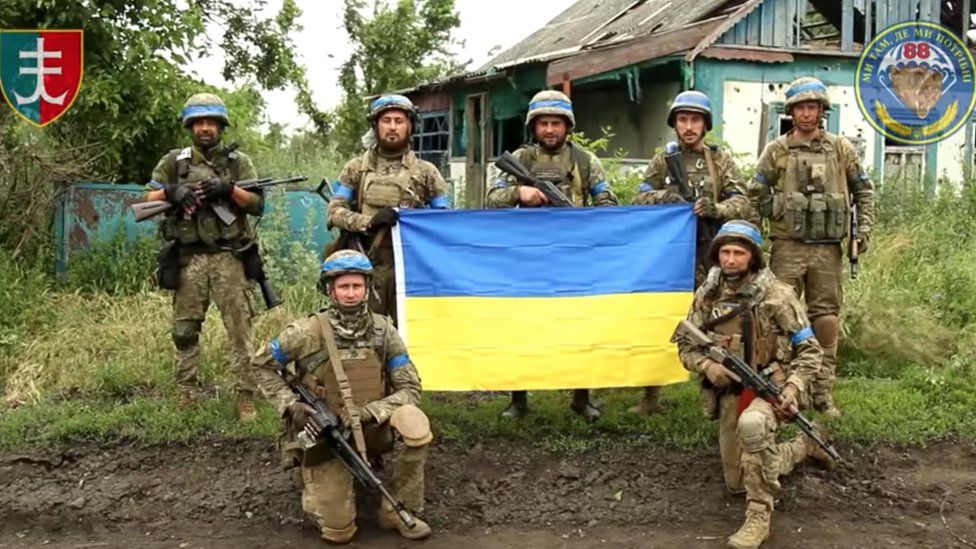
By Frank Gardner
BBC security correspondent
“Don’t call it a counter-offensive,” say the Ukrainians. “This is our offensive, it’s our chance to finally drive out the Russian army from our land.”
All right, but what will it take to actually succeed?
First off, let’s not get distracted by the recent hard-fought but tiny territorial gains Ukraine has been making as it retakes obscure, half-abandoned villages in the eastern Donetsk and south-eastern Zaporizhzhia regions.
After months of stalemate, images of victorious, battle-stained Ukrainian soldiers holding up their country’s blue and yellow flag in front of a bullet-ridden building is a welcome morale boost for Ukrainians.
But in the big strategic picture, this is a sideshow.
The area of Russian-held territory that matters most in this campaign is the south: the area between the city of Zaporizhzhia and the Sea of Azov.
This is the so-called “land corridor” that connects Russia to illegally annexed Crimea, the central part of that purple-shaded strip on the map below that has barely changed since the early weeks of the invasion last year.
If Ukraine can split that in two and hold the ground it’s retaken, then its offensive will have largely been successful.
It would cut off Russia’s troops in the west and make it hard to resupply their garrison in Crimea.
It would not necessarily spell an end to the war – which some are now predicting could drag on for years – but it would put Ukraine in a strong bargaining position when the inevitable peace talks finally take place.

But the Russians have looked at the map, quite some time ago, and reached the same conclusion.
So while Ukraine sent its soldiers off to Nato countries for training and readied their 12 armoured brigades for this summer campaign, Moscow spent that time constructing what is now being called “the most formidable defensive fortifications in the world”.
Blocking Ukraine’s path to the coast – its own coast, let’s not forget – are layer upon layer of Russian minefields, concrete tank-blockers (known as “dragons’ teeth”) bunkers, firing positions and trenches wide enough and deep enough to stop a Leopard 2 or M1 Abrams tank literally in its tracks.
All of this is covered by pre-determined artillery impact zones calibrated to rain down high explosive on Ukraine’s armoured vehicles as they and their crews wait for their engineers to find a way through.
The early signs are – and it is still very early in this campaign – that those Russian defences are so far holding fast.
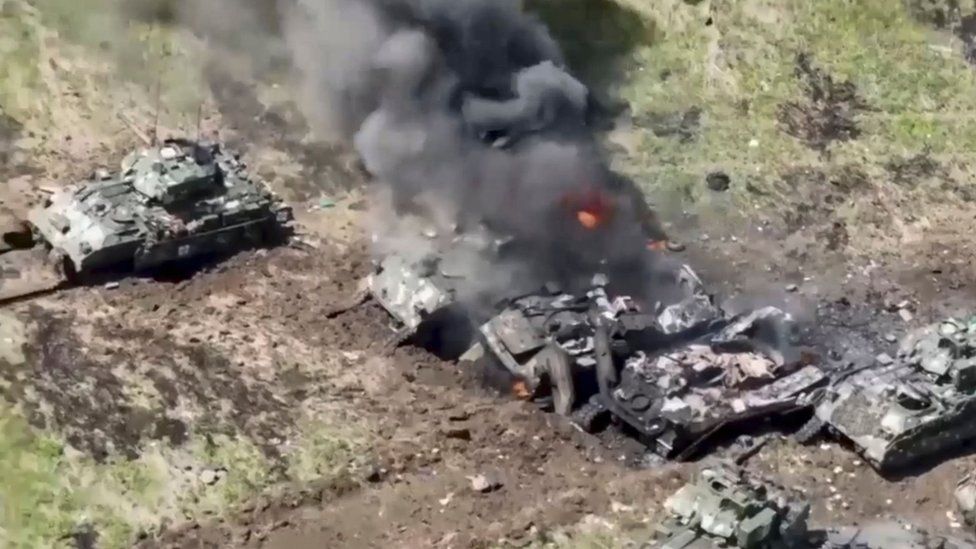
Ukraine has yet to commit the bulk of its forces – so these are probing, reconnaissance attacks designed to reveal the whereabouts of Russia’s artillery and search out areas of vulnerability in their lines.
In Ukraine’s favour is morale. Its soldiers are highly-motivated and fighting to liberate their own country from an invader.
Most of Russia’s troops do not share that motivation, and in many cases their training, equipment and leadership are inferior to Ukraine’s.
The General Staff back in Kyiv will be hoping that if they can achieve a sufficient breakthrough then a collapse in Russian morale will be contagious, spreading across the battlefront as demoralised Russian troops lose the will to fight.
Also in Ukraine’s favour is the quality of hardware that Nato countries have provided. Unlike Soviet-designed armoured vehicles, Nato’s tanks and infantry fighting vehicles can often withstand a direct hit, or at least enough to protect the crew inside who then live to fight on.
But will that be enough to counter the strength of Russia’s artillery and drone attacks?
Russia, as the vastly bigger country, can draw on more resources than Ukraine. President Vladimir Putin, who started this war in the first place, knows that if he can only wear down the Ukrainians into a stalemate that drags on into next year then there is a chance that the US and other allies will tire of supporting this expensive war effort and start to pressure Kyiv to reach a ceasefire compromise.
- Ukraine’s counter-offensive analysed
- Satellite images reveal Russian defences before major assault
- Ukrainians remember Bakhmut, city of salt and sparkling wine
Finally, there is the matter of air cover, or lack of it. Attacking a well dug-in enemy without sufficient close air support is highly risky.
Ukraine knows this, which is why it’s long been pleading with the West to supply it with F16 fighter jets.
The US, which makes them, did not give the green light for this until late May, by which time the first, preparatory, phase of Ukraine’s offensive was already under way.
Critically for Ukraine, the game-changing F16s may now arrive too late on the battlefield to play a key role in the early phases of this counter-offensive.
This is not to say the Ukrainians will lose.
Time and again they have proved themselves agile, resourceful and inventive. They successfully drove the Russian army out of Kherson by hitting their rear-area logistics hubs to the point where the Russians could no longer resupply their troops in that southern city.
Equipped with long-range weapons like Britain’s Storm Shadow cruise missile, Ukraine will be attempting to do the same now.
But amidst all the claim and counter-claim of a propaganda war, it may yet be weeks or even months before we get a clearer picture of who is likely to ultimately prevail in this war.
June 15th 2023
Why the US and Nato have long wanted Russia to attack Ukraine
Vladimir Putin’s decision to invade Ukraine has come at a substantial cost for Russia, with the country so far failing to achieve its military objectives and the Russian economy suffering under unprecedented western sanctions. Robert H. Wade argues that while nothing can excuse Russia’s invasion, the Kremlin has effectively fallen into a trap laid by the US and Nato that is intended to bring down Putin’s regime.
On 26 March, President Biden, speaking in Warsaw, said, unscripted: “For God’s sake, this man [Putin] cannot remain in power.” Such an overt statement of intention for regime change in Russia has not gone down well in most of Europe. US Secretary of State Antony Blinken later clarified Biden’s Warsaw remark: “As you know, and as you have heard us say repeatedly, we do not have a strategy of regime change in Russia, or anywhere else, for that matter”. Blinken has apparently forgotten Vietnam, Chile, Iraq, Afghanistan, and quite a few more.
Consider the following quotes. On 24 February, during a White House press conference on the first day of Russia’s invasion, Biden said sanctions are designed not to prevent invasion but to punish Russia after invading “…so the people of Russia know what he has brought on them. That is what this is all about.”
On 27 February, James Heappey, UK Minister for the Armed Forces, wrote in the Daily Telegraph: “His failure must be complete; Ukrainian sovereignty must be restored, and the Russian people empowered to see how little he cares for them. In showing them that, Putin’s days as President will surely be numbered… He’ll lose power and he won’t get to choose his successor.” Finally, on 1 March, Boris Johnson’s spokesperson said the sanctions on Russia “we are introducing, that large parts of the world are introducing, are to bring down the Putin regime.”
These statements reflect long-standing US strategy for regime change in Moscow, with Ukraine as the pivot. On one hand, send sufficient military and other equipment to Ukraine to sink the Russian military in a quagmire. On the other hand, impose severe, far-reaching sanctions on Russia so as to cause major disruption to the Russian elite and a major contraction of living conditions for the Russian middle-class. The combination should last long enough for Russians to rise up to overthrow Putin and install a Yeltsin-like President more sympathetic to the West.
But this weapons-plus-sanctions strategy needed a cause. Putin’s invasion was the required casus belli. It in no way excuses Russia’s invasion and its despicable tactics to say that the Kremlin fell into a US and Nato trap.
Two clashing mega forces
Our “free” mainstream media has tended to stick to the narrative of a “wicked, revanchist Putin” attacking “innocent and unified Ukraine, as a first step to conquest of other parts of eastern and central Europe and restoration of the erstwhile Soviet Union”.
The Ukraine crisis expresses the clash of two mega forces shaping the world order. One is the US’s long-standing assertion of “primacy” or “hegemony” vis-à-vis all other states. Presidents Putin and Xi (as well as many in the West) talk often and pleasurably of the decline of the US and the fracturing of the West, especially since the 2008 North Atlantic financial crisis. Yet what is striking about the US and the West’s response to Russia’s invasion is how forcefully the US has rallied other western states – and very importantly, western multinational corporations – to isolate a prominent G20 state and former G8 member.
The other clashing mega force is the Russian state’s ambition to constitute itself as the centre of the Eurasian polity, culture and economy. This long-term drive is missed by the focus on Putin – his ambition and his state of mind. Jane Burbank, emeritus Professor of History and Russian and Slavic studies at New York University, reminds us, “Since the 1990s, plans to reunite Ukraine and other post-Soviet states into a trans-continental superpower have been brewing in Russia. A revitalized theory of Eurasian empire informs Mr Putin’s every move”.
Indeed, ever since the collapse of the Russian Empire in 1917 a line of Russian thinkers has developed an ideology of Eurasianism. It was suppressed during the Soviet period but burst forth during perestroika in the late 1980s. The ideology posits not just America but the whole Atlantic world as Russia’s “clash of civilizations” opponent, with Russian Orthodoxy harnessed as the glue in the geopolitical war to come. Under Putin, the themes of imperial glory and western victimisation have been elevated to centre stage across the country.
As Burbank explains, Ukraine figured in this Eurasian ideology as an obstacle from the start. Eurasian ideologists in the 1920s were already talking of “the Ukraine problem”, presenting Ukraine as excessively “individualistic” and insufficiently Orthodox. Prominent ideologists of the 1990s identified Ukrainian sovereignty as, in the words of one, a “huge danger to all of Eurasia”. Russia’s Eurasia project, he said, required, as an “absolute imperative”, total control of the whole north coast of the Black Sea. Ukraine had to become “a purely administrative sector of the Russian centralized state”.
This is the ideology which motives Putin, which led him to declare Ukraine as “a colony with a puppet regime” on the eve of the invasion. This is the ideology which inspires and justifies his brutal war in his eyes.
The US and Nato strategy
Having summarised the ambition of Putin and the Russian state, we return to the US and Nato strategy for Ukraine and Russia. I draw on an eye-opening essay by Joe Lauria, which fleshes out the US and Nato’s ulterior motives in the Ukraine crisis: to end the Putin regime and replace it with one friendly to and subordinate to the US.
The US strategy for regime change in Moscow has been long in preparation. In 2013 (before Ukraine’s President Yanukovych was overthrown in 2014) , Carl Gershman, Director of National Endowment for Democracy (NED), wrote: “Ukraine is the biggest prize.” He explained that if it could be pulled away from Russia and into the West, “Putin may find himself on the losing end not just in the near abroad but within Russia itself.”
This larger strategy for containing Russia is the context to understand the expansion of Nato members all along Russia’s borders, from the Baltics to Bulgaria, and the presence of 30,000 Nato-designated troops. It also helps understand the US and some other western states’ military intervention to overthrow Syria’s ruler, Bashar al-Assad, Russia’s ally, as well as the policy of encouraging US NGOs to foment unrest in Russia.
Since 2015 the CIA has been overseeing a secret intensive training programme in the US for elite Ukrainian special operations forces and other intelligence personnel. On 13 January, it was reported that the CIA-trained forces “could soon play a critical role on Ukraine’s eastern border, where Russian troops have massed in what many fear is preparation for an invasion.” A former CIA official explained, “The United States is training an insurgency.” It is no surprise that Moscow has long read US and Nato actions as being deeply hostile and intended to produce “regime change” in the Kremlin.
The countdown to Russia’s invasion
In 2014 the democratically elected president Yanukovych – explicitly friendly to both the EU and to Moscow – was overthrown in a coup (with substantial US backing). On 23 February, the day after Yanukovych fled, the first act of the Ukrainian parliament was to revoke the legal status of Russian as a national language; and more broadly, to prevent regions from allowing the use of any other language than Ukrainian. The government set about blocking access to Russian news, TV channels and radio. All through the next months, the government, the broadcast media and large sections of the population chanted the motto “One Nation, One Language, One People”.
These were blatantly belligerent acts towards a large minority. It is easy to understand why the many millions of Russian speakers felt under envenomed siege; and why they felt emboldened by support from the powerful state on their doorstep. The fact that language legislation was then not put into law did not suddenly “make everything right again”. The efforts to marginalise Russian speakers continued.
The largely Russian speaking and Russian Orthodox believing populations of the eastern provinces of Donetsk and Luhansk voted in favour of independence from Ukraine. The government in Kyiv (mostly Ukrainian speaking and Catholic) launched a war against these provinces to crush their resistance.
Scroll forward to December 2021. The Kremlin presented treaty proposals, which included implementation of the eight-year old Minsk peace accords (which include a commitment that Ukraine not join Nato); dissolving extreme right Ukrainian militias; and engaging in serious negotiations about a new security architecture in Europe. The US and Nato consistently refused to negotiate. As they refused, they also warned the world, from December 2021 onwards, that Russia would invade. And they transferred huge quantities of weapons and trained the Ukrainian military.
On 19 February, Ukrainian President Zelensky gave an impassioned speech at the Munich Security Conference insisting that Ukraine must have a clear path to join Nato, and expressing regret that Ukraine had given up its nuclear arsenal at the end of the Soviet Union, then the world’s third biggest. In the third week of February, the Ukrainian military dramatically increased its shelling of the Donetsk and Luhansk provinces, as reported by observers from the OSCE (Organization for Security and Cooperation in Europe). It is likely that this step-up in the Ukrainian attack had the blessing of the US and Nato.
Until this point, the Kremlin had not recognised the two Donbas republics; it had held off for eight years. Now, as the Ukrainian military stepped up its attack, the Kremlin had to decide. It entered the on-going civil war in order to protect the Donbas republics from the stepped up Ukrainian military attacks, and on a scale big enough for it to replace the national government.
The US-laid trap
It now appears the Kremlin has fallen into a trap (and to say this is not – to repeat – an attempt to excuse Russia’s actions). The trap has similarities to the trap the US set for Saddam Hussein in 1990 when it said it would not interfere in his government’s dispute with Kuwait. Saddam invaded Kuwait, which gave the US the casus belli to destroy Iraq’s military.
The trap also has similarities to one the CIA laid for Moscow four decades ago, by arming the mujahideen to fight the Soviet-backed government in Afghanistan. The US intended for Moscow to send in its military to defend the government, which it did in 1979. President Carter’s national security advisor, Zbigniew Brzezinski, in an interview in 1998 with Le Nouvel Observateur, happily admitted the US had set a trap:
Indeed, it was July 3, 1979 that President Carter signed the first directive for secret aid to the opponents of the pro-Soviet regime in Kabul. And that very day, I wrote a note to the president in which I explained to him that in my opinion this aid was going to induce a Soviet military intervention… That secret operation was an excellent idea. It had the effect of drawing the Russians into the Afghan trap [note his phrase] and you want me to regret it? The day the Soviets officially crossed the border, I wrote to President Carter, essentially: ‘We now have the opportunity of giving the USSR its Vietnam war.’ Indeed, for almost 10 years, Moscow had to carry on a war that was unsustainable for the regime, a conflict that bought about the demoralization and finally the breakup of the Soviet empire.
Brzezinski presumed, as the US does today, that control of Eurasia is vital for US “primacy” or “hegemony” in the world system (directly countering Russia’s Eurasian ideology). In his 1997 book The Grand Chessboard: American Primacy and Its Geopolitical Imperatives he wrote: “Ukraine, a new and important space on the Eurasian chessboard, is a geopolitical pivot because its very existence as an independent country helps to transform Russia.”
He explained that without Ukraine being integrated into or closely allied to Russia, Russia was a “predominantly Asian imperial state”. Whereas Ukraine integrated into Russia gave Russia the opening to be (or resume being) “a Eurasian empire”. So the long-held US aim has been to push Ukraine away from Russia, as a major step towards constraining Russian strategy, and more distantly Chinese strategy too, thereby sustaining US primacy.
It seems likely that US and Nato strategists have a second Ukraine trap in mind. The first one was the invasion; the second one is Russia bogged down in another long insurgency, the second after Afghanistan, the second Russian “Vietnam”. As the Afghanistan insurgency against the Soviet military helped bring down the Soviet Union, the western strategists hope that the Ukrainian insurgency against the bogged-down Russian military will help end the Putin regime. From the US standpoint, the longer the Ukrainians can sustain the insurgency and keep the Russian military bogged down the more likely is the end of the Putin regime. This is called “realist politics”!
In this context we can understand why a senior retired Russian general (Leonid Ivashov) warned in an open letter shortly before the invasion that an attack would be “pointless and extremely dangerous” and threaten Russia’s existence. The Financial Times quotes a Moscow-based military analyst, Pavel Luzin, as saying that the Kremlin “didn’t listen to the military – they listened to [secret service officers] who said we can do this special operation quickly.”
The sanctions strategy
The quagmire or Vietnam strategy is complemented by the sanctions strategy – the harshest sanctions the US and Europe have ever imposed on any nation. As noted, even to those sceptical of claims of “the end of the American empire”, it is astonishing how effectively the US has mobilised western nations around a project of isolating one of the world’s biggest economies, one of the top two nuclear powers, and the biggest energy supplier to Europe, as though it was North Korea.
The list is impressive. The most damaging sanctions are those on Russia’s central bank, which are succeeding in hammering the value of the ruble (from 85 rubles to the US dollar on 24 February, the day of the invasion, to 154 to the dollar on 7 March, back up to 101 on 25 March).
Most Russian transactions are no longer allowed to be settled through the SWIFT international payment system, which means most Russian international transactions are no longer allowed. Russia’s largest banks are sanctioned. The already physically completed German-Russian Nord Stream 2 gas pipeline was closed down and its company bankrupt. The US has prohibited imports of Russian oil. BP and Shell have pulled out of Russian partnerships.
Russian exports of wheat and fertiliser have been banned, driving up the price of food in the West. European and US airspace is closed to Russian planes. Putin and many Russian leaders have been personally sanctioned. PayPal, Facebook, Twitter, Netflix, McDonalds, and Coca-Cola have been shut down in Russia. And US cable providers have succeeded in getting RT (Russia Today) America shut down.
French Foreign Minister Jean-Yves Le Drian explained that the aim is “asphyxiating Russia’s economy”, even if the West is damaged in the process. Damage to the West is a price worth paying for regime change in Moscow with new leaders respectful of US primacy.
But after only a month of the invasion, the heavy costs of the US and Nato strategy to themselves are becoming only too clear. As the quagmire drags on, the effects of the economic rupture with Russia are beginning to be felt acutely in Europe in the form of rising prices, energy shortages, lost jobs, the absorption of many millions of Ukrainian refugees, and soon approaching the absorption of still more refugees from food-starved countries that previously relied on Ukrainian and Russian grain and fertiliser. The costs are significant even in the US, where inflation is already high and President Biden’s approval ratings are low. At some point, the US and other western nations will have to backpedal on the regime change objective, to save themselves.
But the US and Nato’s objectives are still more complicated than Moscow regime change and keeping costs to themselves tolerable. The objective of securing a Russian regime respectful of US and Nato primacy is intertwined like a double helix with the objective of keeping Russia as an external enemy in order to provide glue for cooperation between the West’s often fractious member states under US leadership.
To justify US leadership, to present a unitary front in Nato, and to justify big increases in western (especially German) military budgets, Russia must be presented as the common enemy. Western military firms also have a strong demand for the West to believe it faces existential enemies in the form of major states (and not just slippery “terrorists” or “a bunch of midgets”, as Chairman of the Joint Chiefs of Staff, General Martin Dempsey, labelled the Islamic State). Indeed, the share prices of the major US arms manufactures zoomed skywards as the Russian invasion looked likely.
The key point was made by Georgy Arbatov, a political scientist and advisor to Mikhail Gorbachev (and other secretaries of the Communist Party), and founder and director of the Institute for US and Canadian Studies at the Russian Academy of Science. He said to a group of senior US officials in 1987: “We are going to do a terrible thing to you – we are going to deprive you of an enemy.”
This is how one can understand the West’s persistent rebuff to the efforts of Gorbachev, Boris Yeltsin, and early Putin to establish non-adversarial relations with western states. It needs Russia as an enemy to provide internal unity. But on the other hand, it also needs Russia as a cooperative partner showing suitable deference to the West, especially over the coming decades as China grows stronger.
Meanwhile, China is watching the Ukraine crisis and the US and Nato strategy, and probably recalculating its confidence in the decline of the West. That recalculation may prompt Beijing to forge closer ties with Moscow – while Beijing also wants to make sure that it does not help the Kremlin to the point where Russia could challenge its own design to dominate the Eurasian landmass, which is well underway in the form of the infrastructure alliances created by the giant Belt and Road Initiative.
Note: This article gives the views of the author, not the position of EUROPP – European Politics and Policy or the London School of Economics. Featured image credit: NATO (CC BY-NC-ND 2.0)
About the author

Robert H. Wade
Robert H. Wade is Professor of Global Political Economy at the London School of Economics.
June 14th 2023
Suckers For War by R J Cook
The CIA are great conspirators, so gifted in that black art, that they started the convention of ridiculing any one publishing anything that can be labelled a conspiracy theory. Obviously we must believe only in government approved conspiracies because we western folk live in what our ruling elites call democracies. Here we must believe what our ‘independent news’ and politically correct ‘sensitivity reader approved’ art and literature censors– and the approved teachers – tell us to believe.
We were so lucky to have Churchill wannabe Big Boris in the U.K P. M’s Job, Churchill’s heavy jowelled grandson in the House of Lords and ‘Sleepy Joe’ Biden in the White House to make sure World War Three took hold. War profiteers are having a good time which is why interest rates and food prices are inflating faster than the U.K’s penises. The British elite know how to delude their hopeless impotent masses and lead the charge for world war. The Coronation of two septuagenarians last month was hideously militaristic, mesmerising their U.S offspring and the insecure Western Europeans.
The British are suckers for all the war profiteering and interest rate rises passed off as a cost of living crisis. British women are sidetracked into a preoccupation with all men, even transsexuals wanting to rape them, whilst complaining that their men don’t get erections and don’t want to marry them. Feminists are so worried that they want new laws making it illegal not to like women , and illegal to look at or speak to them without their permission. This is a country with its priorities all sorted out, don’t you know ?

Image by Appldene Phorographics Portsmouth 2018.
R J Cook
Russia–Ukraine Peace Was Blocked By Western Powers, Former Israeli Prime Minister Claims
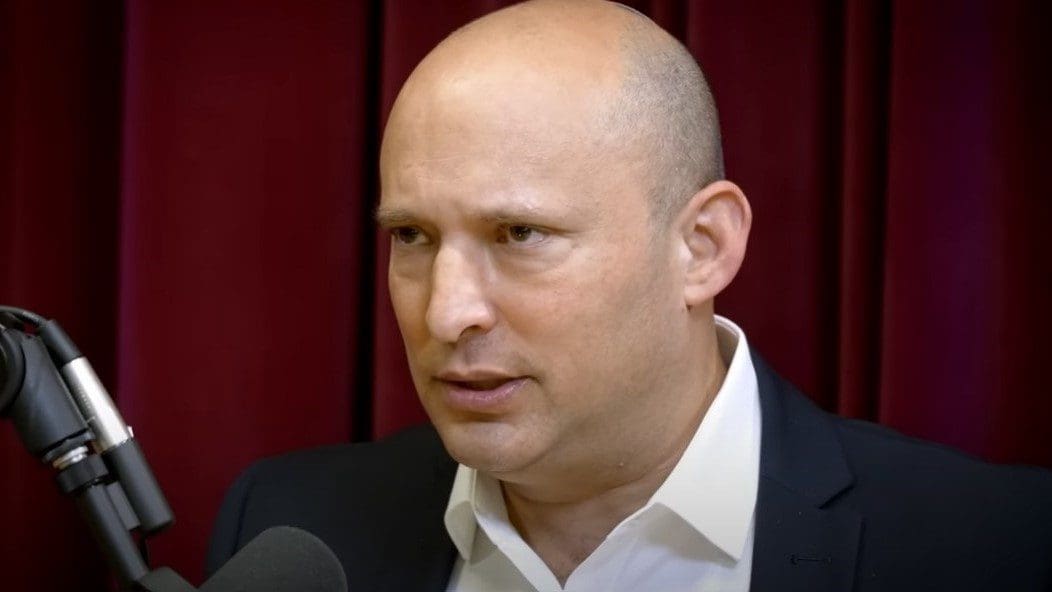
Naftali Bennett
Screenshot of the YouTube interview
Naftali Bennett made shocking claims about his derailed mediation efforts in the Ukraine conflict in a five-hour interview, uploaded to his own YouTube channel.
On Saturday, 4 February, former Israeli Prime Minister Naftali Bennett sat down with journalist Hanoch Daum to give his first in-depth interview since leaving office in June 2022. The nearly five-hour-long discussion was posted on his personal YouTube channel. Despite not amassing an outstandingly large number of views, the video contains some shocking statements by the former Israeli head of government in relation to the ongoing Russo-Ukrainian war.
Bennett claims that he was set to broker a peace deal between Russia and Ukraine but his efforts were stopped by the major Western powers.
According to the former PM, negotiations about this potential peace agreement started as early as 7 March 2022, merely weeks after the invasion began on 21 February. Bennett travelled to Moscow in early March to meet with President Vladimir Putin. He was in constant communication with then-British Prime Minister Boris Johnson, French President Emmanuel Macron, German Chancellor Olaf Scholz, and US President Joe Biden to take coordinate on how to navigate talks about the possible ceasefire.
Still according to Bennett, PM Johnson was the most adamant about taking aggressive action against Putin. Scholz and Macron were exploring more pragmatic options, while Biden was in support of both approaches. The talks between the two belligerent sides seemed to be making some headway, with both parties making concessions. Putin vowed not to have Ukrainian President Volodymyr Zelenskyy killed and to not demand disarmament from Ukraine; Zelenskyy agreed to not pursue NATO membership for his country, which was Putin’s primary contention.
At the same time, Russian and Ukrainian officials were engaging in a negotiation of their own in Gomel, Belarus. So, there seemed to be a very real chance for making peace in Eastern Europe again. However, the major Western NATO powers ultimately decided to end negotiations
because they ‘decided it was necessary to continue to smash Putin’,
as the former Israeli Prime Minister put it in his explosive interview. In light of the suffering and loss of human lives that have since ensued in the war, this is hard to understate.
You can watch Naftali Bennett’s interview in its entirety below, with English close captions available. The discussion about the war and his role as a mediator starts at the two hour 33 minute mark.
As early as last September, based on information from the Ukrainian newspaper Ukrainska Pravda, our website ran a piece about an abandoned peace deal between Russia and Ukraine. It was supposedly ready to be signed by early April 2022, which matches up with the timeline Naftali Bennett outlined in the video cited above, as he spoke about having started mediating between Putin and Zelenskyy in March. Also in accordance with recent revelations from the former Israeli prime minister, the same article claims that the peace talks were halted by an impromptu visit to Kyiv by Boris Johnson. Johnson was described as the most hawkish of the Western leaders in the interview, as we wrote above. Perhaps he was motivated by avoiding the fate of his fellow former British Prime Minister Neville Chamberlain, who is widely viewed as being too weak with Hitler leading up to World War II.
More recently, Balázs Orbán, the Hungarian prime minister’s political director, told the Israeli paper Israel Hayom that he hopes the Jewish state’s new PM, Benjamin Netanyahu, can be an effective mediator between the political leaders in the Eastern conflict, thus helping to bring about the much-coveted peace earlier. This was also before such efforts by Netanyahu’s predecessor were publicly stated.
June 13th 2023
Ukraine offensive: What will it take for military push to succeed?
By Frank Gardner
BBC security correspondent
“Don’t call it a counter-offensive,” say the Ukrainians. “This is our offensive, it’s our chance to finally drive out the Russian army from our land.”
All right, but what will it take to actually succeed?
First off, let’s not get distracted by the recent hard-fought but tiny territorial gains Ukraine has been making as it retakes obscure, half-abandoned villages in the eastern Donetsk and south-eastern Zaporizhzhia regions.
After months of stalemate, images of victorious, battle-stained Ukrainian soldiers holding up their country’s blue and yellow flag in front of a bullet-ridden building is a welcome morale boost for Ukrainians.
But in the big strategic picture, this is a sideshow.
The area of Russian-held territory that matters most in this campaign is the south: the area between the city of Zaporizhzhia and the Sea of Azov.
This is the so-called “land corridor” that connects Russia to illegally annexed Crimea, the central part of that purple-shaded strip on the map below that has barely changed since the early weeks of the invasion last year.
If Ukraine can split that in two and hold the ground it’s retaken, then its offensive will have largely been successful.
It would cut off Russia’s troops in the west and make it hard to resupply their garrison in Crimea.
It would not necessarily spell an end to the war – which some are now predicting could drag on for years – but it would put Ukraine in a strong bargaining position when the inevitable peace talks finally take place.

But the Russians have looked at the map, quite some time ago, and reached the same conclusion.
So while Ukraine sent its soldiers off to Nato countries for training and readied their 12 armoured brigades for this summer campaign, Moscow spent that time constructing what is now being called “the most formidable defensive fortifications in the world”.
Blocking Ukraine’s path to the coast – its own coast, let’s not forget – are layer upon layer of Russian minefields, concrete tank-blockers (known as “dragons’ teeth”) bunkers, firing positions and trenches wide enough and deep enough to stop a Leopard 2 or M1 Abrams tank literally in its tracks.
All of this is covered by pre-determined artillery impact zones calibrated to rain down high explosive on Ukraine’s armoured vehicles as they and their crews wait for their engineers to find a way through.
The early signs are – and it is still very early in this campaign – that those Russian defences are so far holding fast.

Ukraine has yet to commit the bulk of its forces – so these are probing, reconnaissance attacks designed to reveal the whereabouts of Russia’s artillery and search out areas of vulnerability in their lines.
In Ukraine’s favour is morale. Its soldiers are highly-motivated and fighting to liberate their own country from an invader.
Most of Russia’s troops do not share that motivation, and in many cases their training, equipment and leadership are inferior to Ukraine’s.
The General Staff back in Kyiv will be hoping that if they can achieve a sufficient breakthrough then a collapse in Russian morale will be contagious, spreading across the battlefront as demoralised Russian troops lose the will to fight.
Also in Ukraine’s favour is the quality of hardware that Nato countries have provided. Unlike Soviet-designed armoured vehicles, Nato’s tanks and infantry fighting vehicles can often withstand a direct hit, or at least enough to protect the crew inside who then live to fight on.
But will that be enough to counter the strength of Russia’s artillery and drone attacks?
Russia, as the vastly bigger country, can draw on more resources than Ukraine. President Vladimir Putin, who started this war in the first place, knows that if he can only wear down the Ukrainians into a stalemate that drags on into next year then there is a chance that the US and other allies will tire of supporting this expensive war effort and start to pressure Kyiv to reach a ceasefire compromise.
- Ukraine’s counter-offensive analysed
- Satellite images reveal Russian defences before major assault
- Ukrainians remember Bakhmut, city of salt and sparkling wine
Finally, there is the matter of air cover, or lack of it. Attacking a well dug-in enemy without sufficient close air support is highly risky.
Ukraine knows this, which is why it’s long been pleading with the West to supply it with F16 fighter jets.
The US, which makes them, did not give the green light for this until late May, by which time the first, preparatory, phase of Ukraine’s offensive was already under way.
Critically for Ukraine, the game-changing F16s may now arrive too late on the battlefield to play a key role in the early phases of this counter-offensive.
This is not to say the Ukrainians will lose.
Time and again they have proved themselves agile, resourceful and inventive. They successfully drove the Russian army out of Kherson by hitting their rear-area logistics hubs to the point where the Russians could no longer resupply their troops in that southern city.
Equipped with long-range weapons like Britain’s Storm Shadow cruise missile, Ukraine will be attempting to do the same now.
But amidst all the claim and counter-claim of a propaganda war, it may yet be weeks or even months before we get a clearer picture of who is likely to ultimately prevail in this war.
June 12th 2023
Modest gains with counter-offensive still in its early phase

James Waterhouse
Ukraine correspondent in Dnipro
When reading about these latest advances claimed by Kyiv, it’s worth bearing in mind this note of caution from our Ukraine correspondent.
The sight of soldiers once again hoisting Ukrainian flags in liberated settlements is an exciting one for the country and its allies.
What we will hear less about is, where progress has been slower, or non-existent. This counter-offensive is still in its early phase. It’s reflected by the Ukrainians attacking in multiple areas with modest gains.
They’re still costly as well. In the southern Zaporizhzhia region in particular, a lot of men and equipment have been lost as Kyiv tries to probe for a weakness. Building heavy fortifications also plays to a Russian strength as they’ve had months to prepare.
Moscow also has the upper hand when it comes to air superiority. Neither side has deployed their main forces yet. When Kyiv decides to, it’ll hope it brings more than the liberation of villages.
June 11th 2023
Government of Canada orders seizure of Russian-registered cargo aircraft at Toronto Pearson Airport
From: Global Affairs Canada
News release
June 10, 2023 – Ottawa, Canada – Global Affairs Canada
The Honourable Mélanie Joly, Minister of Foreign Affairs, today announced that the Government of Canada had ordered the seizure of a Russian-registered cargo aircraft currently grounded at Toronto Pearson Airport, pursuant to the Special Economic Measures Act.
The targeted Russian aircraft, an Antonov 124, is believed to be owned by a subsidiary of Volga-Dnepr Airlines LLC and Volga-Dnepr Group, two entities against which Canada recently imposed sanctions due to their complicity in President Putin’s war of choice. The seizure of the asset was made possible by the new asset seizure and forfeiture authorities under Canada’s autonomous sanctions regimes put forward in Budget 2022 and is in direct response to Russia’s full-scale invasion of Ukraine that began on February 24, 2022.
The seizure of this important asset is the first step of the Government of Canada’s action under the asset seizure and forfeiture regime and is designed to put additional pressure on Russia to stop its illegal war against Ukraine by straining its economic system and limiting resources that fuel the war. This is the first physical asset seized by the Government of Canada under this regime, and second overall seized and restrained under the Special Economic Measures Act.
The Government of Canada will seize the asset and manage it in accordance with federal legislation. Should the asset ultimately be forfeited to the Crown, Canada will work with the Government of Ukraine on options to redistribute this asset to compensate victims of human rights abuses, restore international peace and security, or rebuild Ukraine.
By authorizing the seizure of the Antonov 124, Canada reaffirms that impunity is not an option for those who have profited from Russia’s illegal war in Ukraine.
Quotes
“Today, Canada is sending a clear message to the Russian regime that there will be nowhere left to hide for those who support and profit from the Kremlin’s war of aggression. Canada has been there to support Ukraine’s fight for freedom since day one and we will continue to be there through their victory to aid in their reconstruction efforts.”
– Mélanie Joly, Minister of Foreign Affairs
“Our Government is unwavering in our commitment to Ukraine’s sovereignty and against Russia’s illegal invasion. From the beginning we have stood on the side of the Ukrainian people, and implemented a NOTAM against all Russian-owned and operated flights into Canada. Today, we are demonstrating that Russia’s actions continue to have consequences. We stand with Ukraine and will take any and all necessary actions, including this seizure, to put pressure on President Putin”
– Omar Alghabra, Minister of Transport
Quick facts
- Following Russia’s invasion of Ukraine, Canada and its G7 and other allies jointly decided to take additional steps to isolate Russia from the international financial system and impose consequences for its actions.
- Canada made amendments to the Special Economic Measures Act and the Justice for Victims of Corrupt Foreign Officials Act. The amendments, which entered into force in June 2022, provide the authorities for the Government to seize, forfeit, dispose and redistribute assets belonging to sanctioned individuals and entities.
- The aircraft, the largest cargo aircraft, is the second asset that Canada has seized/restrained under the Special Economic Measures Act. In December 2022, an order-in-council was announced to restrain US$26 million from Granite Capital Holdings Ltd., a company believed to be owned by Roman Abramovich, a Russian oligarch sanctioned under the Special Economic Measures (Russia) Regulations.
- Global Affairs Canada will work with Public Services and Procurement Canada’s Seized Property Management Directorate to evaluate the condition of the asset and manage it through the seizure and forfeiture process.
Associated links
- Canada starts first process to seize and pursue the forfeiture of assets of sanctioned Russian oligarch
- Special Economic Measures (Russia) Regulations
- Canada’s response to the invasion of Ukraine
- Sanctions – Russian invasion of Ukraine
Whole Company of NATO Tanks Destroyed as Ukraine & NATO Continue Action To Capture Crimea. Ukraine Action On Russian Border To Divert Troops. Russia Has Cause For Concern & Drastic Action. British Government Awards £150 Million To Fund Ukrainian Refugees U.K Homes & Jobs. What About the British or is British Now A Racist Word ?
Videos

2:25
Ukraine’s Counteroffensive a Flop Show? Dramatic Video of …
YouTube · Hindustan Times
Russia: Warship guarding Black Sea pipelines attacked by uncrewed Ukraine craft
May 24, 20234:36 PM GMT+1Updated 18 days ago
MOSCOW, May 24 (Reuters) – Russia’s Defence Ministry said on Wednesday the Russian warship Ivan Hurs had been attacked unsuccessfully in the early morning by three Ukrainian uncrewed speedboats in the Black Sea, on the approaches to the Bosphorus strait.
In a statement posted on Telegram, the ministry said the warship had been protecting the TurkStream and Blue Stream gas pipelines – which carry gas from Russia to Turkey, partly across the Black Sea – and “continues to fulfil its tasks”.

 Yevgeny Prigozhin is seen leaving the military headquarter in Rostov-on-DonImage caption: Yevgeny Prigozhin is seen leaving the military headquarter in Rostov-on-DonThe head of the Wagner mercenary group has been pictured by Reuters news agency apparently leaving the city of Rostov-on-Don, which his fighters took control of earlier today.Yevgeny Prigozhin was driving away from the district military headquarters in the city, the agency says.According to Russian state media, Progozhin is to leave Russia for Belarus and all charges against him and his Wagner forces will be dropped by authorities to avoid “bloodshed”.
Yevgeny Prigozhin is seen leaving the military headquarter in Rostov-on-DonImage caption: Yevgeny Prigozhin is seen leaving the military headquarter in Rostov-on-DonThe head of the Wagner mercenary group has been pictured by Reuters news agency apparently leaving the city of Rostov-on-Don, which his fighters took control of earlier today.Yevgeny Prigozhin was driving away from the district military headquarters in the city, the agency says.According to Russian state media, Progozhin is to leave Russia for Belarus and all charges against him and his Wagner forces will be dropped by authorities to avoid “bloodshed”.
Be the first to comment on "Exceptional Powers – Anglo U.S NATO Elite Tyranny III"